`
The Plumbe Family
Albert Edward Plumbe
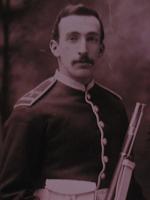 |
|
Albert Edward Plumbe
photo from David Morris
|
30 December 1861, in Henley on
Thames, Oxfordshire, England
30 May 1862, in St. Mary's, Henley on Thames, Oxfordshire,
England
William Plumbe
Ann
Richardby (Strange) Plumbe
Brewery Clerk 6 May 1886, aged 24, in Henley, Oxfordshire, England 12 May 1886, in St. Mary's, Henley on Thames, Oxfordshire,
England
1881: Market Place, Henley on
Thames, Oxfordshire
- Keith Hazell
- Henley baptism
registers researched by Mike Strange
- 1881 census
- England Death Index
2Q1886 vol3a p417; exact date from David Morris at www.steelbreeze.net
- Keith Hazell
Albert Granville Plumbe
1880, in Tottenham, Middlesex,
England
Henry
Martyn Plumbe
Louisa (Walker) Plumbe
Laura Grace Nelson on 8 June 1904
at the Manse, First Church, 16th Ave., Seattle, King county, Washington,
United States.
Laura was born in 1882/3, in Washington, United
States.
Teamster (1900); Dry Goods
Grocer (1910)
1881:
11
Tilson Road, Tottenham, Middlesex
1904: Seattle, King county, Washington (marriage certificate)
1910:
1403
33rd Ave, Seattle, King county, Washington
Albert Maclaren Plumbe
August 1908, in Atlin, British
Columbia, Canada
Samuel
Henry Plumbe
Henrietta (Maclaren) Plumbe
17 January 1990, in Beacon Hill
Lodge, North Vancouver, British Columbia, Canada
23 January 1990, in Boal Chapel,
1505 Lillooet Rd, North Vancouver, British Columbia, Canada
nbsp;
1911:
62 Government Street, Victoria, British Columbia
Alexandra Plumbe
8 March 1863, in Henley on Thames,
Oxfordshire, England
23 November 1864, in St. Mary's,
Henley on Thames, Oxfordshire, England
William Plumbe
Ann
Richardby (Strange) Plumbe
Governess
17 October 1912, in Henley on Thames,
Oxfordshire, England
23 October 1912, in St. Mary's,
Henley on Thames, Oxfordshire, England
1881: Market Place, Henley on
Thames, Oxfordshire
1891:
Robinson Road, Mitcham, Surrey: Alexandra Plumbe, sister in law, is
aged 28, born in Henley, Oxfordshire. Her occupation is governess.
- Date from David Morris
at www.steelbreeze.net; place from 1881 census
- Henley baptism
registers researched by Mike Strange
- 1891 census
- Keith Hazell
- Keith Hazell
Alice (Plumbe) Widdowson
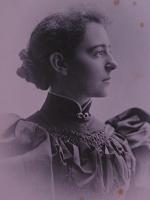 |
|
Alice (Plumbe) Widdowson
photo from David Morris
|
1867, in Islington, Middlesex,
England
James Plumbe
Velebeth
(Chibnall) Plumbe
Joseph
James Widdowson in 1895, in Amersham
district, Buckinghamshire, England
Dressmaker (1891) and later
landlady of the King's Head in Aylesbury,
Buckinghamshire. This 15th century inn is now in the hands of the National
Trust, but is still run as a public house.
1881:
Box
End, Kempston, Bedfordshire
1891: 18 Gery Street, Bedford St.
Cuthbert, Bedfordshire
1901: Slough, Buckinghamshire
1948
- England Birth Index
(4Q1867 Islington vol 1b p214); exact place from 1881 census
- England Marriage
Index (3Q1895 vol 3a page 1061)
- 1891 census; David
Morris at www.steelbreeze.net
- Claire Freestone
Alice May Plumbe
1873, in Whitechapel, Middlesex,
England
Henry
Martyn Plumbe
Louisa (Walker) Plumbe
12 October 1938 at 76 Eridge Road,
Croydon, Surrey, England, aged 65
proved on 2 November 1938 in the
Principal Probate Registry, by Basil Roy Power, the executor
1881:
11
Tilson Road, Tottenham, Middlesex
1891: Alice M. Plumbe, daughter, is aged 17, born in Whitechapel, London
1901: Croydon, Surrey: Alice M. Plumbe is aged 27, born in London St Marks
E, Whitechapel
1911: Croydon, Surrey: Alice May Plumbe is aged 37
1938: 44 Heathfield Road, Croydon, Surrey (London Gazette 16 December 1938 p8038)
Alice Christine Norah Plumbe
1896, in Ashton Keynes, Wiltshire,
England
John Plumbe
Alice
Jane (Leaker) Plumbe
1980
1901: Ashton Keynes, Wiltshire; Age: 6; Place of Birth: Ashton Keynes,
Wiltshire
- England Birth Index
(1Q1896 vol 5a p45); exact place from 1901 census
- Gloucester Records
Office: D4128/F11/10 has Order of Service of Alice's funeral in 1980
Andrew Reed Plumbe
5 May 1835, in London, Middlesex,
England
28 June 1835, in Wycliffe Chapel
Philpot Street-Independent, Stepney, London, England
Samuel Plumbe
Ann
Serena (Payne) Plumbe
1881, in Reigate
district, Surrey, England aged 45
Andrew Reed Plumbe was named after Andrew
Reed, a minister at the Wycliffe Chapel on Philpot Street with which
the Plumbes were associated. Andrew Reed was a well known philanthropist and
was later to work with Ann Serena Plumbe in the establishment of one the
first institutions to train the learning disabled in England. This was the
Asylum for Idiots, initially located at Park House in Highgate, and later
moved to Redhill, Surrey where it became the Royal
Earlswood Hospital. Andrew Reed Plumbe was admitted to the institution
as a patient in 1848, aged 13.
Anne (Plumbe) Ive
9 January 1819, in Henley on Thames,
Oxfordshire, England
8 February 1819, in St. Mary's,
Henley on Thames, Oxfordshire, England
John Simmons
Plumbe
Charlotte
(Aldworth) Plumbe
Alfred
Ive on 20 July 1840, in St. Mary, Henley on Thames, Oxfordshire,
England. The marriage was witnessed by John Simmons Plumbe, Jane Billingham,
Lucy Ann Ive and Emma Plumbe.
Wine Merchant
4 September 1892, in Eastbourne,
Sussex, England
9 September 1892, in Holy Trinity,
Henley on Thames, Oxfordshire, England
1881: Hart Street, Henley on
Thames, Oxfordshire
- Date from David Morris
at www.steelbreeze.net; place from 1881 census
- Oxfordshire parish
registers researched by Keith Hazell
- England Marriage
Index (3Q1840 Henley vol 16 p105); exact date, place and witnesses from
Mike Strange citing Henley marriage registers
- 1881 census
- Keith Hazell
- Keith Hazell
Anne Clarissa (Plumbe) Seager
11 April 1821, in St. Martin in the
Field, Westminster, London
Samuel Plumbe
Anne
Clarissa (Perkins) Plumbe
Thomas
Whittaker
Seager on 30 September 1843 in Moradabad, North-Western Provinces,
India
Bombay Times and Journal of Commerce 18 October
1843
At Moradabad on the 30th of September by the Revd A B Spry Lieut T W
Seager 27th N I to Anne Clarissa elder daughter of the late Dr S Plumbe
22 November 1858, in Attock, Punjab
Province, India
British Medical Journal 19 February 1859 p160
DEATHS.
SEAGER. On November 22nd, 1858, at Attock, Anne Clarissa, wife of Captain
Thomas Seager, and daughter of the late Samuel Plumbe, Esq., Surgeon.
Anne Richardby Strange (Plumbe) Duggua
8 January 1855, in Henley,
Oxfordshire, England
28 February 1855, in St Mary's,
Henley on Thames, Oxfordshire, England
William Plumbe
Ann
Richardby (Strange) Plumbe
George
Oxley
Duggua on 17 May 1888, in St. Marys, Henley on Thames, Oxfordshire,
England
1861: Henley, Oxfordshire: Anne R. S. Plumbe, daughter, is aged 6, born in
Henley, Oxfordshire
1881: Market Place, Henley on
Thames, Oxfordshire
1891:
Robinson Road, Mitcham, Surrey: Annie R. Duggua, wife, is aged 36,
born in Henley, Oxfordshire
1901: Bromley
Road, Lee, London: Anne Duggua, wife, is aged 45, born in Henley,
Oxfordshire
1911: Lee, London: Annie R. S. Duggua is aged 56, born in Healey On Thames,
Oxfordshire
- England Birth Index
(1Q1855 Henley vol 3a p449); exact date from David Morris at
www.steelbreeze.net; place from 1861 census
- Henley baptism
registers researched by Mike Strange
- England Marriage
Index (2Q1888 Henley vol 3a p951); exact date and place from Keith
Hazell
Annie Plumbe
1824/5, in London, Middlesex, England
Samuel Plumbe
Caroline
(Payne) Plumbe
Annie is referred to in Rolls Plumbe: An Authentic
Memoir of a Child in A Series of Letters to a Child, and on
on page 48, dated April 24 1832, we learn that Annie is seven years old.
Annie Ethelreda (Plumbe) Gosnell
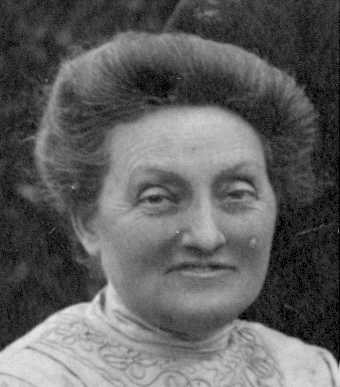 |
|
Annie Ethelreda (Plumbe) Gosnell
(click for full photo)
photo from Jerry Gosnell
|
22 October 1859 in Maidenhead,
Berkshire, England
6 December 1859, in Maidenhead
Chapel, Maidenhead, Berkshire, England. The sponsors at the baptism were Mrs
Charretie, Mrs Bellis (wife of her father's medical practice partner), and
Captain Seager (uncle)
Samuel Alderson
Plumbe
Louisa
Burton (Hulke) Plumbe
 |
|
Marriage register entry for Arthur William
Gosnell and Annie Ethelreda Plumbe
|
Arthur
William Gosnell on 21 February 1889 in Holy Trinity Church, Hobart,
Tasmania, Australia.
Arthur William Gosnell is recorded as a schoolmaster, of full age. Annie
Ethelreda Plumbe is recorded as a spinster, of full age. The marriage was
officiated by George Wood Shoobridge and witnessed by P. E. Raynor, B. C.
Hunt and J. Mitchell.
The engagement took place in December 1886.
The
Mercury (Hobart, Tasmania), 2 March 1889
MARRIAGES.
GOSNELL—PLUMBE.—On
February 21, at Holy Trinity Church, Hobart, by the Rev. G. W.
Shoobridge, assisted by the Rev. G. A. Brequet, Arthur William Gosnell
Esq., M.A., Head Mathematical Master of Christ's College, Hobart, only
son of Thomas Gosnell, Esq., of Bideford, Devon, England, to Annie
Ethelreda, third daughter of the late Samuel Alderson Plumbe, Esq.,
M.D., of Maidenhead, Berks, England.
The day after their engagement,
Arthur Gosnell sailed for Tasmania to establish himself there, and Annie
joined him in Hobart two years later sailing for Hobart on the
Tongariro, leaving London on 11 January 1889, and arriving in
Hobart on 20 February 1889.
The
Mercury (Hobart, Tasmania) 21 February 1889 p2
SHIPPING.
ARRIVED.—February 20.
Tongariro, R.M.S.S. (New Zealand Ship ping Co.'s line), 2,657 tons, J.
Bone, from
London January 11, Plymouth, January 12, Teneriffe, January 17, Cape Town
February 1. Passengers for Hobart—First saloon : Miss Plumbe ; 4 in the
steerage. For Melbourne—7 in the steerage. For Sydney—First saloon : Rev.
F. D. Brock ; second saloon : Mr. W. H. Jones ; and 2 in the st erage.
Agents—Messrs. Macfarlane Bros. and Co.
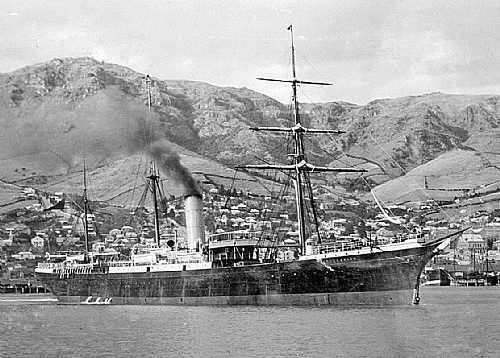 |
R.M.S.
Tongariro
Although it is not stated on the
original photograph, I believe that this picture is taken
while the Tongariro was
anchored at Hobart, probably around the time that Annie sailed
on her.
|
ARRIVAL
OF THE R.M.S. TONGARIRO.
The royal mail steamship Tongariro (New Zealand Shipping Co.'s line)
arrived at Hobart yesterday morning from London, having called at
Plymouth, Teneriffe, and Cape Town on the journey. This boat is noted
for her punctuality in arriving, and this trip cannot really be said to
be an exception to the rule, for, although she was due here on Tuesday,
she arrived yesterday at 2 a.m., thus keeping up her reputation. On her
arrival the Tongariro was boarded by Dr. Barnard, the health officer,
and Captain Riddle, harbourmaster, who were satisfied with the order
that existed and the vessel received the usual clean bill of health. The
passage does not seem to have differed much from the general run, the
customary and greatly looked forward to entertainments and amusements
being indulged in by the passengers, and no mishap occurred on the
voyage. The passenger list is not so lengthy as usual, and only 16
passengers landed at Hobart for the Australasian colonies, their
destination being as follows :— For Hobart, one in the first saloon and
four in the steerage ; for Melbourne, seven in the steerage ; for
Sydney, one in the first saloon, one in the second saloon, and two in
the steerage. The roll of officers is the same as when the Tongariro was
last here. Captain Bone is still in command, and Mr. Bloxam retains his
post as chief officer, and Mr. Waring as chief engineer. Mr. Burlinson
continues in his duties as purser, and is as obliging as ever in
supplying information regarding the voyage. No casualties happened
during the voyage, and no births or deaths are reported. The following
is a short description of the voyage :—The Tongariro left London on
January 11, and Plymouth on the following day at 1.37 p.m., with 206
bags of mails and 96 passengers. Moderate winds and a rough sea were
experienced white crossing the Bay of Biscay and until arrival at
Teneriffe on January 17, at 4.15 a.m. After coaling at that picturesque
island the Tongariro sailed, at noon of the same day with moderate
trades and variable winds, which accompanied her to the Equator, crossed
on January 23. Light south east trades and southerly winds faced her to
the Cape. She arrived here at 8.28 p.m on the 1st inst., and sailed at
1.26 a.m. on the 2nd inst. Unsettled weather with fogs now set in. After
Kerguelan Island was passed, the usual westerly winds and fine weather
prevailed until arrival at Hobart at the time stated above. One hundred
and ninety five tons of cargo were discharged here and 200 tons of coal
taken in. The Tongariro sailed yesterday afternoon for Wellington at
2.30 with four additions to her first saloon passenger list, viz.:— Mr.
and Mrs. Duckworth and Messrs. Joseph Clarke and S. Rivington, all for
New Zealand.
Critic (Adelaide, South
Australia) 23 December 1899 p24
Mr. and Mrs. Gosnell, late of Clifton House
School, are now living near Bristol, England, where Mrs. Gosnell
receives delicate and backward boys for coaching.
13 June 1943, in Bridgwater,
Somerset, England, aged 83
MY WILL.
I, Annie Ethelreda Gosnell, make hereunder my last will and testament.
I leave all I possess, completely and entirely, to my husband Arthur William
Gosnell, but if he should predecease me I desire my assets to be divided
amongst my children as follows:-
A. To Wilfrid - I leave the four cottages, Nos 1,2,3,&4 Park View,
Harefield, which originally belonged to his Godfather Willie Kennell,
subject to Wilfrid repaying to my estate the sum of £300 (Three Hundred
Pounds) which is deemed by me to have been advanced to him.
B. The remainder of my assets, including the above £300, I wish to be
divided equally amongst my remaining children, viz. Enid, Kenneth, Alan,
Phyllis, and Joan. The amount left to Enid is not to be given her as a lump
sum, but should be paid out in weekly
or monthly instalments at the discretion of the Executors. The Executors
shall decide in what manner this shall be done.
I appoint Kenneth and Phyllis as
co-executors, but in the event of Kenneth being detained abroad Phyllis
shall act as sole executor, referring to Kenneth in case of difficulty.
Signed at Bexhill-on-Sea this third day of April (May A.E.G.)1935
Annie E. Gosnell
in the presence of.
Witness. Benjamin Lister Oswell Gentleman
17
Knebworth Road Bexhill on Sea 3 May 1935
Witness. Lucy Oswell. Wife. Same address May 3rd
1935 as above
1861: Cookham, Berkshire: Annie E. Plumbe, daughter, is aged 1, born in
Maidenhead, Berkshire
1871: Terrace, Winchcombe,
Gloucestershire
1888: "Monkendons", Maidenhead, Berkshire (letters written to her from
Hobart by her fiance, Arthur Gosnell). One letter, arriving in Maidenhead on
27 July 1888, was forwarded to the home of her sister Harriet (Plumbe)
Whitfield, in Uxbridge, where Annie must have been visiting, following the
birth of Harriet's first child in June 1888.
1890: "Monkendons", Shoobridge Street, Glebe, Hobart, Tasmania (birth notice
of daughter Enid)
1901: High
Street, Maidenhead, Berkshire
1911: The
High School West End, Melksham, Wiltshire
Annie (Plumbe) Robinson
1864, in Islington
district, Middlesex, England James Plumbe
Velebeth
(Chibnall) Plumbe
to William
Hensman Robinson in 1895, in Cookham
district, Berkshire, England
1937
- England Birth Index
(2Q1864 vol 1b p196)
- England Marriage Index
(2Q1895 vol 2c p869)
Archibald Plumbe
19 February 1909, in Victoria,
British Columbia, Canada
Samuel
Henry Plumbe
Henrietta (Maclaren) Plumbe
Rosalie Spendlove
Rosalie was born on 14 September 1909, in North Vancouver, British Columbia.
18 March 1988, in North Vancouver,
British Columbia, Canada
1911:
62 Government Street, Victoria, British Columbia
Arthur Plumbe
20 July 1863, in Ashton Keynes,
Wiltshire, England
John Plumbe
Elizabeth
Jane (Richards) Plumbe
Winifred Hettie Giles in
1896, in Ashfield district, New South Wales, Australia
Winifred was the daughter of Elizabeth S. _____. She died in 1922 in Mosman
district, New South Wales, Australia.
- Arthur James Plumbe (1897 - ? )
- Robert Ashton Plumbe (1901 - ? )
- Winifred Mary Plumbe (1903 - 1942)
Frances Mack
Medical doctor. In the 1881
census, Arthur's occupation is recorded as "Medical Student". He became a
doctor in Singleton, New South Wales, Australia.
1944 in Mosman district, New South
Wales, Australia
1871: Manor House, Meysey
Hampton, Gloucestershire
1881: Church Road, Ashton Keynes,
Wiltshire
- Claire Freestone; 1881
census
- New South
Wales Registry of Births, Deaths and Marriages (6945/1896); Winifred
death from New South Wales Registry of Births, Deaths and Marriages
(7346/1922)
- Claire
Freestone
- Claire Freestone;
1881 census
- New South Wales
Registry of Births, Deaths and Marriages (25843/1944)
Arthur Victor Plumbe
12 October 1864, in Henley on Thames,
Oxfordshire, England
23 November 1864, in St. Mary's,
Henley on Thames, Oxfordshire, England
William Plumbe
Ann
Richardby (Strange) Plumbe
Fanny
Meagher in 1888 in Wandsworth, London, England
Commercial Clerk
15 May 1909, in Lewisham district,
London, England
Brompton Cemetery
1881: Market Place, Henley on
Thames, Oxfordshire
- Date from David Morris
at www.steelbreeze.net; place from 1881 census
- Henley baptism
registers researched by Mike Strange
- England Marriage
Index (1Q1888 vol 1d page 790)
- Keith Hazell
- England Death Index
(2Q1909 vol 1d p573); exact date from Keith Hazell
- David Morris at
www.steelbreeze.net
Brooke Lambert Plumbe
1867, in Whitechapel, Middlesex,
England
Henry
Martyn Plumbe
Louisa (Walker) Plumbe
Junior Clerk (1881), and sailor
(1885). His death registration lists him as "App'Ce", presumably meaning
apprentice aboard the merchant ship.
10 March 1885, at sea, aged 16.
Brooke was on the merchant ship Shannon,
an East Indiaman which was lost with all hands on a voyage from London to
Calcutta.
The Liverpool Mercury 14 August 1885
Foundering of an East Indiaman - 45 Lives
Lost
Information received from Lloyds yesterday morning states that the
splendid iron ship Shannon of London, 1650 tons register, bound from the
Thames to Calcutta with a valuable general cargo, is missing. She sailed
from Deal on the 27th of January and was spoken near the Line on the 10th
March, all well, but has never arrived at her destination. Underwriters
have given up all hope of her safety, as she is two months overdue, and
they are of opinion that the vessel has foundered off the Cape of Good
Hope with all hands, numbering 45 all told.
The Board of Trade Wreck
Report
for the Shannon noted that
she had a crew of 28 and also carried the master's wife at the time of her
loss. They concluded:
The Court, having carefully inquired into the circumstances of the
above-mentioned shipping casualty, finds, for the reasons annexed, that
the said ship, when she left this country in January 1885, was in good and
seaworthy condition, but that she was not sufficiently manned; and that
there is nothing to shew how she was lost.
In the report it is noted that:
We are told that she had a master, three mates, a carpenter, a sail maker,
13 A.B.'s, an ordinary seaman, four apprentices, a boy, and three Lascars,
of who one was the steward and another the cook.
1881:
11
Tilson Road, Tottenham, Middlesex
2 Adelaide Villas, Northumberland Park, Tottenham, London (Rootsweb
WorldConnect
(martingough))
Caroline Mary Plumbe
1858, in Winchcombe, Gloucestershire,
England
Henry
Plumbe
Caroline (Straford) Plumbe
Matron Nursing Institute
1937, in Aled
district, Denbighshire, Wales, aged 78
1861: Abbey Terrace, Winchcombe,
Gloucestershire
1871: Terrace, Winchcombe,
Gloucestershire
1901: Richmond, Surrey: May Plumbe is aged 42, born in Winchcombe, Gloster
and her occupation is Matron Nursing Institute
1911: Richmond, Surrey: Caroline Mary Plumbe is aged 52
- England Birth Index
(4Q1858 Winchcomb vol 6a p332); exact place from 1861 census
- 1861 census
- 1901 census
- England Death Index
(2Q1937 Aled vol 11b p363)
Caroline Ada (Plumbe) Thomson
9 July 1864 in Maidenhead, Berkshire,
England
12 November 1864 in Maidenhead
Chapel, Maidenhead, Berkshire, England
Sponsors at christening were Caroline Plumbe, Elizabeth Hulke, and Mr
Montgomery, her father's partner in medical practice.
Samuel Alderson
Plumbe
Louisa
Burton (Hulke) Plumbe
Henry
John Phipps Thomson on 18 March 1884, in St Luke, Maidenhead,
Berkshire, England
Henry is recorded as a widower, aged 43, resident in St Mary Magdelen,
Taunton. He is Secretary to the Great Indian Peninsula Railway, Bombay.
Caroline is recorded as aged 19. The marriage was witnessed by Samuel
Thomson Plumbe M.D., Philip Algernon Plumbe, E. M. Thomson, Louisa B.
Plumbe, and Laura Kate Plumbe.
London Evening News 20 March 1884 p4
MARRIAGES.
THOMSON—PLUMBE—On the 18th inst., at St. Luke's, Maidenhead, by the Rev.
G. O. L. Thomson, M.A., brother of the bridegroom, assisted by the vicar,
the Rev. W. G. Sawyer, M.A., Henry John Phipps Thomson, of Bombay, to
Caroline Ada, fourth daughter of the late Samuel Alderson Plumbe, M.D.
known as "Ada"
Harry returned to India now accompanied by Ada, in May 1886.
Ada lived at "Kia-Ora", Cooden Drive, Bexhill, Sussex after her husband,
Harry Thomson, died in 1907. Her daughters Muriel and Edie also lived there,
and her sister Ellen joined them there after the family home "Monkendons" in
Maidenhead was sold in 1907.
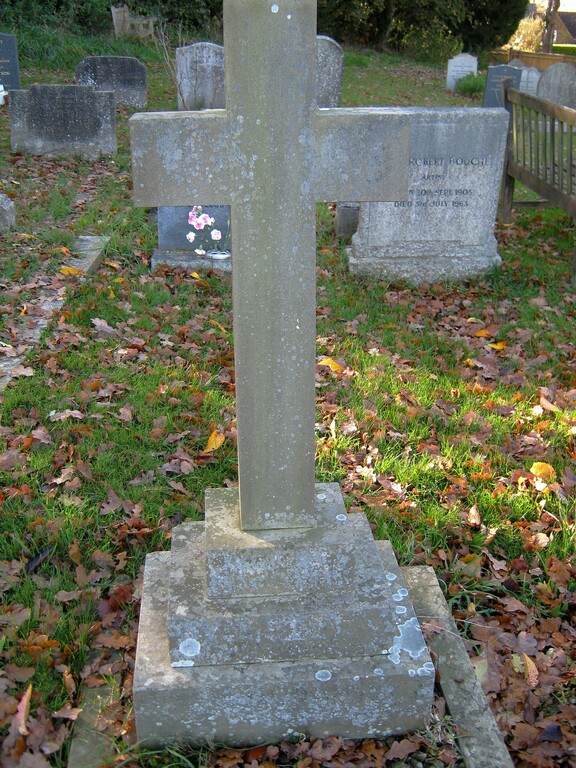 |
|
Gravestone of Caroline Ada (Plumbe)
Thomson in St John the Evangelist’s Church Cemetery, Dormansland,
Surrey
|
29 April 1944 in Surrey
South Eastern district, Surrey, England, aged 79
St John the Evangelist’s Church
Cemetery, Dormansland, Surrey, England
1871: Maidenhead,
Berkshire
1881: High Street, Cookham,
Berkshire
1911: Bexhill, Sussex: Caroline Ada Thomson is aged 46, born in Maidenhead,
Berkshire
Charles Plumbe
of St. Dioinis, Backhurst, London
27 December 1804, in Henley on
Thames, Oxfordshire, England
1 February 1805, in St. Mary,
Henley on Thames, Oxfordshire, England
John Plumbe
Sarah
(Simmons) Plumbe
Mary
Simmonds on 14 February 1828, in St. Mary, Henley on Thames,
Oxfordshire, England. Witnesses were W. Plumbe and Robert Outhwaite. The
first is presumably Charles's brother, William, and the second a relative of
William's wife, Anne Outhwaite.
31 December 1875, in Henley,
Oxfordshire, England
proved 27 January 1876 "by William
Plumbe, of Henley-upon-Thames, in the county of Oxford, Draper, James
Plumbe, of 230, Upper-street, Islington, in the county of Middlesex,
Ironmonger, Rowland Plumbe, of 13, Fitzroysquare, in the county of
Middlesex, Architect and Surveyor, and Jolm Plumbe Payne, of 1,
Northumberland-place, Bayswater, in the county of Middlesex, Gentleman, the
executors named in the said will"
1875: Remenham Hill, near Henley-on-Thames, Oxfordshire (London Gazette 18 February 1876 p783)
Charles Strange Plumbe
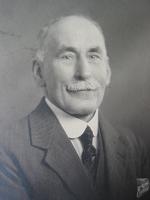 |
|
Charles Strange Plumbe
photo from David Morris
|
19 October 1853, in Henley on Thames,
Oxfordshire, England
28 December 1853, in St Mary,
Henley on Thames, Oxfordshire, England
William Plumbe
Ann
Richardby (Strange) Plumbe
Cleaver House School in Windsor
Frances
Elizabeth Gosling on 20 March 1876, in Haverstock Hill, Pancras,
London, England
Velebeth
Plumbe on 11 August 1910, Aylesbury, Buckinghamshire, England
Charles's second wife was his second cousin. The common ancestors were his
great-grandparents, John Plumbe and Sarah Simmons.
David Morris notes that the reverse of the marriage certificate to Velebeth
Plumbe is stamped by the Great Indian Peninsula Railway (19 January 1911)
and by the Delta Metal Co. Ltd (dated 27 February 1911).
- William Anthony Plumbe (1911 - 1989)
- Velebeth Anne Plumbe (1916 - 2002)
Draper, Accountant, Company
Director.
After 2 years apprenticeship in London, Charles entered his father's
draper's shop which fronted Market Place & Bell Street. After his father
died in 1890, he became outside manager of Henley Brewery and lived at
Everly House. In 1909, Charles became Secretary to Henley Water Co. and
retired in 1934. In 1910 he became Secretary and Actuary to Henley Trustee
Savings Bank which he served for about 20 years. Charles was a Borough
Auditor and for many years was administrator for the Green School (a Henley
charity founded by John Stevens in 1717) and was still auditor to the Henley
Grammar School. He was a director of the former Henley Gas Co. for a number
of years and chairman at the time of the amalgamation.
17 August 1939
22 August 1939, in St Mary's, Henley
on Thames, Oxfordshire
Charles was at one time a member of
the Henley Rowing Club and won several prizes. He has always taken a keen
interest in rowing and never missed viewing Henley Royal Regatta, usually
from the river. He was a sidesman and regular attendant at St Mary's Church.
1881: Market Place, Henley on
Thames, Oxfordshire
- Date from David Morris
at www.steelbreeze.net; place from 1881 census
- Henley baptism
registers researched by Mike Strange
- England
Marriage Index (1Q1876 vol 1b page 63) - Charles is recorded as Plumb
rather than Plumbe. David Morris at www.steelbreeze.net has a copy of
the marriage certificate.
-
England Marriage Index (3Q1910 Aylesbury vol 3a p2017); exact
date and place from David Morris at www.steelbreeze.net citing the
marriage certificate
- 1881 census; David
Morris at www.steelbreeze.net
- David Morris at
www.steelbreeze.net
- Keith Hazell
- David Morris at
www.steelbreeze.net
Charles Leaker Plumbe
9 July 1866, in Ashton Keynes,
Wiltshire
John Plumbe
Elizabeth
Jane (Richards) Plumbe
Muriel
K. Chaffers-Welsh in 1911, in Inverell district, New South Wales,
Australia
Charles became a pharmacist's
assistant, then an Insurance Agent for AMP in Pagewood, Sydney.
1936, in Hornsby district, New South Wales, Australia
Lost top of his finger in an
accident.
1871: Manor House, Meysey Hampton,
Gloucestershire
1881:
King
Alfreds College, Wantage, Berkshire
- Claire Freestone; place
from Keith Hazell
- New South Wales
Registry of Births, Deaths and Marriages (9562/1911); Claire Freestone
has the marriage date as 14 June 1912 which does not match the marriage
registry, but the marriage date may have been 14 June 1911.
- Claire Freestone
- New South Wales Registry
of Births, Deaths and Marriages (23364/1936)
- Claire Freestone
Charles James Plumbe
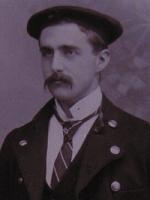 |
|
Charles James Plumbe
photo from David Morris
|
1877, in Islington, Middlesex,
England
James Plumbe
Velebeth
(Chibnall) Plumbe
Ellen
Fensom in 1903, in Bedford
district, Bedfordshire, England
Undertaker
1960
1881:
Box
End, Kempston, Bedfordshire
1891: 18 Gery Street, Bedford St.
Cuthbert, Bedfordshire
- England Birth Index
(3Q1877 Islington vol 1b p280); exact place from 1881 census
- England Marriage Index
(2Q1903 vol 3b p769)
- Probate notice of
sister Fanny (Plumbe) Fensom
- Claire Freestone
Charlotte (Plumbe) Coombs
1828/9
11 March 1829, in St. Mary's, Henley on Thames,
Oxfordshire, England
John Simmons
Plumbe
Charlotte
(Aldworth) Plumbe
William
Walter Coombs on 8 July 1856, in St. Mary's, Henley on Thames,
Oxfordshire, England. Witnesses were C. Plumbe, Wm Plumbe and Mary Strange.
The first two witnesses are probably Charlotte's mother, Charlotte
(Aldworth) Plumbe, and her brother William.
2 April 1868, in Weymouth, Dorset,
England, aged 39
- aged 39 at death in
1868
- Oxfordshire parish
registers researched by Keith Hazell
- Henley marriage
registers researched by Mike Strange
- England Death Index
(2Q1868 vol 5a p197); exact date from Keith Hazell
Ebenezer Erskine Plumbe
18 April 1833 in Bedford Square,
London, England
30 June 1833 in Wycliffe Chapel
Philpot Street-Independent, Stepney, London
Samuel
Plumbe
Caroline
(Payne) Plumbe
Tallow Chandler apprentice
(1851); Labourer
Ebenezer's stepmother, Ann Serena
Plumbe, was a driving force in the establishment of one the first
institutions to train the learning disabled in England. This was the Asylum
for Idiots, initially located at Park House in Highgate, and in 1855 moved
to Redhill, Surrey where it became the Royal
Earlswood Hospital. Ebenezer's half-brother, Andrew Reed Plumbe was
admitted to the institution as a patient in 1848, aged 13, and records show
that Ebenezer was discharged from Earlswood on 20 July 1860. It seems that
he emigrated almost immediately to Australia (ship record entry found in
1860). Ebenezer's death certificate claims that he had been in Australia for
40 years, while this entry date would indicate 31 years. Most likely the
death certificate, which contains several other incorrect entries, is a bit
out.
24 May 1891, at Maitland St.,
Bingara, New South Wales, Australia, aged 58, of inflammation of the groin.
25 May 1891
Granted on 13 July 1892 to Mary Ann
Millar
England &
Wales, National Probate Calendar Wills 1892 p179
PLUMBE Ebenezer Erksine of Bingara New
South Wales labourer died 24 May 1891 at 23 Corsica-street Probate London
13 July to Mary Ann Miller (wife of George Robert Miller) Effects
£57 15s.
1841: Green
End, Aylesbury, Buckinghamshire
1851: North
Gate Street, Oakham Deanshold, Rutland
Elizabeth Plumbe
Samuel
Plumb
Mary
(Goff) Plumb
25 November 1769, in SS Peter &
Paul, Wantage, Berkshire (now Oxfordshire), England
- Oxfordshire parish
registers researched by Keith Hazell
Ellen Plumbe
7 April 1824, in Henley on Thames,
Oxfordshire, England
7 May 1824, in St. Mary's, Henley
on Thames, Oxfordshire, England
William Plumbe
Anne
(Outhwaite) Plumbe
12 April 1827, in St. Mary's, Henley
on Thames, Oxfordshire, England, aged 3
Baptised as Ellen, buried as Eleanor.
- Oxfordshire parish
registers researched by Keith Hazell
- Oxfordshire parish
registers researched by Keith Hazell
- Oxfordshire parish
registers researched by Keith Hazell; Mike Strange has this date as 13
April 1827.
Ellen A. Plumbe
1843/4
Thomas Plumbe
Ellen (Moss) Plumbe
12 February 1846, in Soharunpore,
North West Provinces, India
Allen's Indian Mail 2 April 1846 p233
DEATHS.
Plumbe, Ellen A. d. of Capt Thos. at Soharunpore, aged 2, Feb 12.
Ellen (Plumbe) Cobb
known as "Nellie"
about 1865, in Islington, Middlesex,
England
James Plumbe
Velebeth
(Chibnall) Plumbe
to Thomas
Cobb
1938
- Keith Hazell
- Keith Hazell
- Data provided by Claire
Freestone
Ellen Augusta Plumbe
26 August 1867 in Maidenhead,
Berkshire, England
Samuel Alderson
Plumbe
Louisa
Burton (Hulke) Plumbe
Ellen lived at "Monkendens" in Maidenhead until her brother
Samuel Thomson Plumbe died in 1909. The house was sold in September 1909,
and Ellen appears to have moved to "Kia-Ora" in Cooden Drive, Bexhill,
Sussex to live with her widowed sister (Caroline) Ada, whose own husband,
Harry Thomson, had died in 1907. Her nieces Muriel and Edie also lived
there.
1951, in Battle
district, East Sussex, England, aged 84
1871: Maidenhead,
Berkshire
1881: High Street, Cookham,
Berkshire
1891: 86-90 High Street, Cookham,
Berkshire
1901: High
Street, Maidenhead, Berkshire
1910: 10 Jameson Road, Bexhill, East Sussex (Rootsweb
WorldConnect (martingough I240 citing her sister Ada's Codicil to her
Will dated 4/4/1910)
1911: Otterbourne, Hampshire: Ellen Augusta Plumbe, visitor, is aged 43,
born in Maidenhead, Berkshire. Ellen is a visitor at the home of her sister
Laura Kate and brother-in-law, Charles Arthur Mason.
- England Birth Index
(4Q1867 Cookham vol 2c p369); exact date from Claire Freestone; exact
place from 1871 census
- 1871 census
- Claire Freestone
- England Death Index
(4Q1951 Battle vol 5h p6)
Emily Plumbe
23 February 1859, in Henley,
Oxfordshire, England
3 March 1859, in St. Mary's, Henley
on Thames, Oxfordshire, England
William Plumbe
Ann
Richardby (Strange) Plumbe
3 March 1859, in Henley, Oxfordshire,
England
5 March 1859, in St. Mary's, Henley
on Thames, Oxfordshire, England
- David Morris at
www.steelbreeze.net
- Henley baptism
registers researched by Mike Strange
- David Morris at
www.steelbreeze.net.
- Henley parish
registers researched by Mike Strange
Emma (Plumbe) Kinch
30 April 1823, in Henley on Thames,
Oxfordshire, England
28 May 1823, in St. Mary's, Henley
on Thames, Oxfordshire, England
John Simmons
Plumbe
Charlotte
(Aldworth) Plumbe
Charles
Kinch on 12 August 1844 in St. Mary's, Henley on Thames, Oxfordshire,
England. John Simmons Plumbe, the brides's father and Charlotte Plumbe,
presumably the bride's sister, were witnesses.
Emma is recorded on a Return
of
Owners of Land, 1873 in Oxfordshire as having land in Henley-on-Thames
of 4 acres and 27 poles (1 pole = 37.25 square yards) with a rental value of
£191 16s.
1881:
6
The Elms, Toxteth Park, Lancashire (note: appears as Emma Kinck)
1901: Seaton Carew, Durham, living with her married son, William
- Date from David Morris
at www.steelbreeze.net; place from 1881 census
- Keith Hazell
- England Marriage
Index (3Q1844 vol 16 page 117); exact date from Henley parish registers
researched by Mike Strange. Marriage index refers to Charles Kench, a
transcription error.
Emma Charretie (Plumbe) Seager
1 July 1828 in Lower Bedford Place,
London, England
29 July 1828, in Old Church, St.
Pancras, London, England
Samuel Plumbe
Emma
(Lloyd) Plumbe
Thomas
Whittaker Seager on 2 July 1863 in the Republic
and Canton of Neuchâtel, Switzerland
Marriage certificate #229 (part1,
part2,
part3)
ACTE DE MARIAGE
EXTRAIT
des Registres de la Circonscription de Neuchâtel
L'an mil huit cent Soixante-trois le premier Juillet a deux heures apres
midi, par devant nous, Louis Barbier, officier de l'état de civil
Neuchâtel, sont comparus: Thomas Whittaker Seager, Caputaine dans
l'armée du Bengal, Grandes-Indes, originaire de Londres, Angleterre,
domicilié a Neuchâtel, né le vingt-cinq Juillet mil huit cent dix-huir,
majeur, fils de James Lys Seager, Esquire, demeurant a Southt Lambeth,
Comté de Surrey, Angleterre, et de Henriette neé Whittaker, son
épouse; veuf en premier noces ie. Anne Clarissa Plumbe, décéseé le
vingt-huit Novembre mil huir cent cinquante-huit a Attock dans le
Punjaub Indes-Anglaises ainsi qu'il résulte d'un acte de decés délivré a
Londres le deux Juin mil huit cent soixante-trois par les autorités
compétentes d'une part; Et Emma Charritie Plumbe, sans profession,
originaire de la Paroisse de St George, Bloomsbury, Comté de
Middlesex Angleterre, domiciliée à Neuchâtel, neé le premier Juillet mil
huit cent vingt huit, majeure fille de feu Samuel Plumbe Esquire,
demeurant en son vivant, a Southampton-Street a Londres et de Emma neé
Lloyd, son épouse, l'autre part
Lesquels nous ont requis de procéder a la célébration de leur
mariage. En conséquence lecture a été faire: 1e des
publications ordonneés pour les Loi-publications qui ont en lieu sans
opposition; 2e de l'arrêt d'autorisation donné par le Conseil
d'Etat de la République et Canton de Neuchâtel, le vingt neuf Juin mil
huit cent soizante-trois, 3e du chapitre de le Loi sur les
droits et devoirs respectifs des époux, nous avons ensuite demandé au
futur époux et a la future épouse, s'ils veulent se prendre pour mari et
femme et chacun d'eux ayant répondu séparément et affirmativement, nous
avons déclaré au nom de la Loi, que Thomas Whittaker Seager et Emma
Charritie Plumbe, sont unis par le mariage
Des pièces relatives à cet acte et déposées aux archives, sont au
nombre de quatre et cotées, sous N229, troisième régistre et paraphé
Fait en séance publique a l'hôtel de ville de Neuchâtel en
présence de Henri Plumbe, Solliciteur, âgé de trente-trois ans,
demeurant Winchcomb, Comté de Glouster, Angleterre, frerè de l'épouse et
de Charles Tunod Professeur, âgé de soixante-trois ans demeurant à
Neuchâtel, et ont, les époux et les témoins signé avec nous après
lecture faite.
(Signé) Thomas Whittaker Seager, Henri Plumbe, Emma
Charritie Plumbe, Charles Tunod
(Signé) L Barbier
Délivré conforme au régistre pour nous officier de l'état civil de la
circonscription A Neuchâtel 2 Juillet 1863
L Barbier
Le Secrétaire du Conseil d'Etat de la République at Canton de
Neuchâtel en Suisse, certifie véritable la signature ci devant citoyen
L. Barbier, Officier de l'état civil de la circonscription Neuchâtel. Il
déclare de plus que le contrôle et le papier timbré ne sont pas en usage
dans cet Etat
Neuchâtel le deux Juillet mil huit cent soixante-trois (1863)
Pr Secrétaire d'Etat:
Le premier Secrétaire de la Chancellerie
L Sandoz
This roughly translates as:
MARRIAGE CERTIFICATE
EXTRACT
of the Registers of the District of Neuchâtel
In the year one thousand eight hundred and sixty-three on the first of
July at two o'clock in the afternoon, before me, Louis Barbier, civil
registrar of Neuchâtel, appeared: Thomas Whittaker Seager, Captain in the
Bengal army, East Indies, originally from London, England, domiciled in
Neuchâtel, born on July twenty-fifth, eighteen hundred and eighteen, of
legal age, son of James Lys Seager, Esquire, residing in South Lambeth,
County of Surrey, England, and of Henriette nee Whittaker, his wife;
widower in first marriage ie. Anne Clarissa Plumbe, died on the
twenty-eighth of November, one thousand eight hundred and fifty-eight in
Attock in the Punjab of the English Indies, as results from a death
certificate issued in London on the second of June, one thousand eight
hundred and sixty-three by the competent authorities, on the one hand; And
Emma Charritie Plumbe, without profession, originally from the Parish of
St George, Bloomsbury, County of Middlesex England, domiciled in
Neuchâtel, born on the first of July eighteen hundred and twenty-eight,
adult daughter of the late Samuel Plumbe Esquire, residing during his
lifetime, in Southampton-Street in London and Emma neé Lloyd, his wife, on
the other hand
Who asked us to celebrate their marriage. Consequently reading was
done: 1st of the publications ordered for the Law-publications which have
place without opposition; 2nd of the authorization judgment given by the
Council of State of the Republic and Canton of Neuchâtel, on June
twenty-ninth, one thousand eight hundred and sixty-three, 3rd of the
chapter of the Law on the respective rights and duties of spouses, we then
asked the future husband and wife if they wanted to take each other as
husband and wife and each of them having responded separately and in the
affirmative, we declared in the name of the Law that Thomas Whittaker
Seager and Emma Charritie Plumbe , are united by marriage
Documents relating to this act and deposited in the archives are
four in number and listed under N229, third register and initialed
Done in public session at the town hall of Neuchâtel in the presence
of Henri Plumbe, Solicitor, aged thirty-three, residing in Winchcomb,
County of Glouster, England, brother of the wife and of Charles Tunod,
Professor, aged sixty -three years living in Neuchâtel, and have, the
spouses and witnesses signed with us after reading.
(Signed) Thomas Whittaker Seager, Henri Plumbe, Emma Charritie
Plumbe, Charles Tunod
(Signed) L Barbier
Issued in accordance with the register for us civil status officer of the
district A Neuchâtel July 2, 1863
L Barbier
The Secretary of the Council of State of the Republic at Canton of
Neuchâtel in Switzerland, certifies the true signature in front of citizen
L. Barbier, Civil Registrar of the Neuchâtel district. He further declares
that control and stamped paper are not in use in this State
Neuchâtel July 2, one thousand eight hundred and sixty-three (1863)
Professor Secretary of State:
The first Secretary of the Chancellery
L Sandoz
Morning
Post 4 July 1863 p7
Seager-Plumbe.--On the 2d Inst., at Neuchatel, Switzerland, by the Rev.
Louis Junod, Captain Thomas Whittaker Seager, of H.M.'s Indian Army, to
Emma Charritie, second daughter of the late Samuel Plumbe, M.D., of
London.
The marriage of Thomas and Emma was not legal in England at that time since
Thomas had been previously married to Emma's half-sister, Anne, which is
likely the reason that the marriage took place in Neuchâtel.
A month before the wedding, Thomas had contributed
£25 to the Marriage Law Reform Association which had "the exclusive
object of promoting the passing of an act to render lawful marriage with a
deceased wife's sister". Their marriage status in Eng;and is unclear -
when Thomas died in 1866, Emma is recorded as "widow, the relict", but
when the widowed Emma died in England in 1870, she was described as a a
spinster, and her last name was listed as "Seager otherwise Plumbe".
4 November 1870, at 18 Powis Road,
Brighton, Sussex, England, aged 42
Granted on 11 March 1871 to Samuel
Alderson Plumbe and Henry Plumbe
England &
Wales, National Probate Calendar Wills 1871 p90
SEAGER
otherwise PLUMBE Emma Charretie Effects under £7,000. 11 March.
The Will of Emma Charretie Seager otherwise Plumbe formerly of 47
Edwardes-square Kensington in the County of Middlesex afterwards of
Neuchatel in Switzerland but late of 18 Powis-road Brighton in the
County of Sussex Spinster who died 4 November 1870 at 18
Powis-road was proved at Lewes by Samuel Alderson Plumbe of
Maidenhead in the County of Berks M.D. and Henry Plumbe of Winchcomb in
the County of Gloucester Gentleman the Brothers two of the Executors.
Eric Ashton Plumbe
1903
Thomas
Plumbe
Susan
(Argent) Plumbe
Ernest Langley Plumbe
12 May 1868
John
Plumbe
Elizabeth
Jane (Richards) Plumbe
Ernest Augustus Plumbe
15 February 1869, in Henley on
Thames, Oxfordshire, England
25 February 1876, in St. Mary's,
Henley on Thames, Oxfordshire, England (recorded as being aged 7)
William Plumbe
Ann
Richardby (Strange) Plumbe
27 June 1890, aged 21, in Henley on
Thames, Oxfordshire, England
30 June 1890, in St. Mary's, Henley
on Thames, Oxfordshire, England
1881: Market Place, Henley on
Thames, Oxfordshire
- Date from David Morris
at www.steelbreeze.net; place from 1881 census
- Henley baptism
registers researched by Mike Strange
- England Death Index
(2Q1890 vol 3a p425); exact date from David Morris at
www.steelbreeze.net
- Keith Hazell
Ethel Plumbe
about 1888, in Watford,
Hertfordshire, England
Arthur Victor
Plumbe
Fanny
(Meagher) Plumbe
Fanny (Plumbe) Talbot
9 May 1808, in Wantage, Berkshire,
England
3 June 1808, in SS Peter &
Paul, Wantage, Berkshire, England
Samuel Plumbe
Molly
(Aldworth) Plumbe
_____
Talbot in Calcutta, India. Fanny went out to India to stay with her
brother Dr Robert Plumbe, a surgeon in the East India Company, and while
there met and married Colonel Talbot.
After the death of her husband in
India, Fanny retuned to live in Kensington, London, possibly with her
widowed sister-in-law, Louisa (nee Davies), although the 1881 census finds
her living in Somerset.
1881: 4
Oxford
Terrace, Lyncombe & Widcombe, Somerset
- IGI Batch C021982; 1881
census
- IGI Batch C021982;
Oxfordshire parish registers researched by Keith Hazell
- Claire Freestone
- Claire Freestone
Fanny Plumbe
29 March 1826, in Henley on Thames,
Oxfordshire, England
3 May 1826, in St. Mary's, Henley
on Thames, Oxfordshire, England
William Plumbe
Anne
(Outhwaite) Plumbe
1896
1881:
Box
End, Kempston, Bedfordshire
- Oxfordshire parish
registers researched by Keith Hazell; 1881 census
- Oxfordshire parish
registers researched by Keith Hazell
Fanny Elizabeth (Plumbe) Langley
1830, in Wantage, Berkshire (now
Oxfordshire), England
22 September 1830, in SS Peter
& Paul, Wantage, Berkshire, England
John Plumbe
Elizabeth
(Neate) Plumbe
Noah Beldom Langley in 1869 in
Ashton Keynes, Wiltshire, England.
Noah was born in 1831, in Harrow Weald, Middlesex, and baptised on 15 May
1831 in Great Stanmore, Middlesex, the son of George Langley and Ann. Noah
was a surgeon and a member of the Royal College of Surgeons London and a
Licentiate of the Apothecaries Hall of London,
1891, in Cricklade, Wiltshire,
England, aged 60
1851: Mill Street, Wantage, Berkshire
1881: High Street, Cricklade St.
Sampson, Wiltshire
- 1851, 1881 census
- Oxfordshire parish
registers researched by Keith Hazell
- England Marriage
Index (3Q1869 vol 5a p33); Noah birth from 1881 census and baptism date;
Noah baptism from IGI baptism extracts batch C048611; Noah occupation
from 1881 census
- England Death Index
(2Q1891 vol 5a p23)
Fanny Maria Grace (Plumbe) Moore
1 June 1850, in Benares, Bengal,
India
6 May 1850, in Agra, Bengal, India
Thomas Plumbe
Ellen (Moss) Plumbe
James
Sinclair Moore in 1881, in Lyncombe & Widcombe, Somerset, England
Fanny was known as Grace.
1933, in St.
Thomas district, Devon, England, aged 83
1871: Lyncombe
& Widcombe, Somerset
1881: Abbey Villa,
Lyncombe & Widcome, Somerset
1891: Great Yarmouth, Norfolk: Fanny M. G. Moore, wife, is aged 40, born in
Borares, India
1901: Willesden, Middlesex: Fanny M. G. Moore, wife, is aged 50, born in
India
1911: Wellington Urban, Shropshire: Fanny Maria Grace Moore is aged 60, born
in India
Fanny Elizabeth (Plumbe) Hobbs
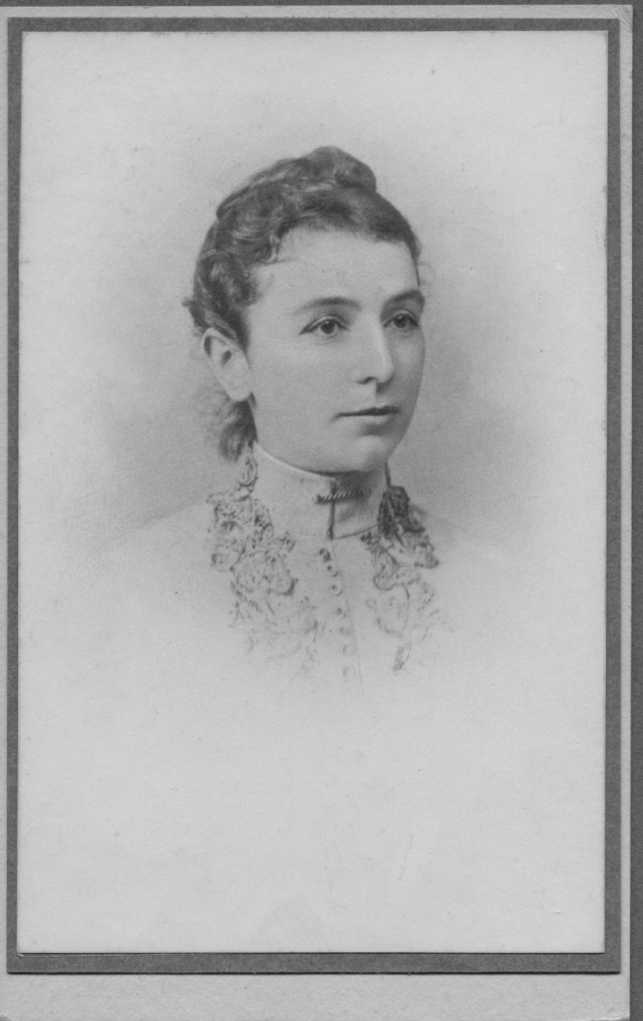 |
|
Fanny Elizabeth (Plumbe) Hobbs
scan courtesy of Liza Hobbs
|
20 September 1852, in Ashton Keynes,
Wiltshire, England
John Plumbe
Elizabeth
Jane (Richards) Plumbe
Robert
William Hobbs in 1874, in Ashton Keynes, Wiltshire, England
1890, in Faringdon
district, of pneumonia after being caught in a heavy downpour on a
return journey to Kelmscott from a family visit to Meysey Hampton. She was
37.
Kelmscott Churchyard, Kelmscot,
Oxfordshire, England
1871: Westham Farm, Ashton Keynes,
Wiltshire
1881: Kelmscot, Oxfordshire
- England Birth Index
(4Q1852 vol 5a page 27); exact place from 1881 census
- England Marriage
Index (2Q1874 vol 5a page 49); exact place from Keith Hazell
- England Death Index
(2Q1890 vol 2c p152); details from Liza Hobbs
- Liza Hobbs
Fanny (Plumbe) Fensom
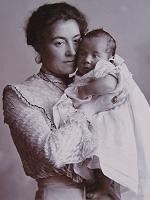 |
|
Fanny (Plumbe) Fensom
photo from David Morris
|
1873, in Islington, Middlesex,
England
James Plumbe
Velebeth
(Chibnall) Plumbe
John
Thomas Fensom in 1902, in Maidenhead
district, Berkshire, England
Drapers Dressmaker (1901)
1 May 1915, in Bedford
district, Bedfordshire, England, aged 42
FENSOM
Fannie of North End Farm Stagsden Bedfordshire
(wife of John Thomas Fensom) died 1 May 1915 Probate Northampton
9 June to Charles James Plumbe undertaker. Effects £700.
known as "Flo"
1881:
Box
End, Kempston, Bedfordshire
1901: New Windsor district, Berkshire: Fanny Plumbe is aged 28, born in
Islington, London and is a Drapers Dressmaker
1911: Bedford district, Bedfordshire: Fannie Fenson is aged 38
1915: North End Farm, Stagsden, Bedfordshire (probate)
- England Birth Index
(1Q1873 vol 1b p238); exact place from 1881 census
- England Marriage Index
(4Q1902 vol 2c p1051)
- 1901 census
- England Death Index
(2Q1915 Bedford vol 3b p364); exact date from probate notice
Florence Plumbe
about 1891, in Watford,
Hertfordshire, England
Arthur
Victor Plumbe
Fanny
(Meagher) Plumbe
Frances (Plumbe) Sanders
3 March 1771, in Wantage, Berkshire,
England
27 March 1771, in SS Peter &
Paul, Wantage, Berkshire, England
Samuel
Plumb
Mary
(Goff) Plumb
William
Sanders on 2 February 1796 in SS Peter & Paul, Wantage, Berkshire,
England.
Witnesses at marriage were Samuel Plumbe, Hannah A. Plumbe, L. G. Whitfield.
10 August 1834, in Wantage,
Berkshire, England
It was around this time that the
surname changed from Plumb to Plumbe. Frances' baptism record still uses
Plumb.
George Plumbe
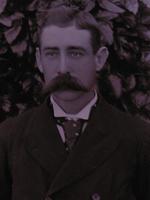 |
|
George Plumbe
photo from David Morris
|
1861, in Islington, Middlesex,
England
James Plumbe
Velebeth
(Chibnall) Plumbe
Dairy Farmer
16 February 1900, killed in action at
Dordrecht, in South Africa during the Boer War. George was in A Squadron,
2nd Regiment, Brabant's Horse.
Papers in the deceased estate of George Plumbe, filed 18 May 1901
Final Liquidation and Distribution Account
Personal effects, clothing, nicknacks sent to England (relatives) in terms
of the last will of the deceased valued at £26/5/-
Sold cream from cattle held on shares with Messrs F & B Ainslie £6/12/3
since death
Sale of shares in certain stock in hands of Messrs F and B Ainslie £140
Share of profits of dairy at Emerald Hill from January up to part of May
1900 £84/16/10
Out of hand sales of various items inc horses, ox, guns, cart, saddle,
butter washer, gun cartridges, cheese presses, etc
Value of estate £1022/10/10
Amount available for distribution £814/18/4
The following disbursements were made in accordance with the will
William Plumbe, brother
£116.1.2
Annie Robinson, sister
£116.1.2
Ellen Plumbe, sister
£116.1.2
Alice Plumbe, sister
£116.1.2
Velabeth, sister
£116.1.2
Fannie, sister
£116.1.2
Charles James Plumbe, brother
£116.1.2
The sum of £2/6/6, being 2% succession duty, was deducted from each of the
above sums.
The difference between the value of the estate and the amount available for
distribution is accounted for by the settlement of numerous small debts,
mostly to traders in the areas or towns of Port Elizabeth, Bedford,
Adelaide, Cradock, Grahamstown.
- England Birth Index
(3Q1861 vol 1b p210)
- Military death notice
for Trooper G. Plumbe (Cape Town Archival Repository MOOC 6/9/401 ref
1651)
- Death notice
- Estate: Cape Town
Archival Repository MOOC 13/1/1005 ref 102
Harold Plumbe
known as "Harry"
Samuel Plumbe
Caroline
(Payne) Plumbe
Probably around 1825. Although Philip
and Annie are mentioned often in , no mention is made of Harold except as an unnamed
younger brother who died when Rolls was about four.
from p8
When (Rolls) was about four years old...
Some time after this, his little brother, less than he, died. He was very
much affected by his death and would look frequently into the coffin and
weep. His mother consoled him by saying, "Your brother is gone to
heaven."...
- David Morris at www.steelbreeze.net
- p9
Harriet Charlotte (Plumbe) Whitfield
24 April 1861 in Maidenhead,
Berkshire, England
8 July 1861, in Maidenhead Chapel,
Maidenhead, Berkshire, England
The christening sponsors were Mrs Venables, Charlotte Hulke and Fred Hulke
(Deal); the latter two are presumably her uncle Frederick Thomas Hulke and
his wife Charlotte (Backhouse) Hulke.
Samuel Alderson
Plumbe
Louisa
Burton (Hulke) Plumbe
George
Sydney Whitfield on 30 June 1886, in Cookham
district, Berkshire, England
In June 1869, Harriet is recorded as attending day school at Miss Brown's in
Maidenhead.
Harriet travelled quite extensively - in October 1879 she went to Paris, and
in October 1881 she went to New Zealand for two years, returning in November
1883.
Harriet's outward trip to Australasia was aboard the SS
Orient, leaving London on 27 October and arriving in Melbourne on 7
December 1881. The passenger list records "Misses Plumbe (two)" indicating
that Harriet was probably travelling with one of her sisters,or perhaps a
cousin.
The
Australasian (Melbourne, Victoria) 10 December 1881 p24
DEC. 7.
Orient, s.s. (Orient line), 5,386 tons, W. F.
Hewison, commander, from London Oct. 27, Plymouth Oct. 29, Naples 4th
ult., Port Said 8th ult., Suez 11th ult., Aden 14th ult., and Adelaide
5th inst. Passengers— saloon: For Melbourne—Captain W. H. Bradley, Mrs.
Bradley, and child, Mr. and Mrs. F. J. Coote, Miss Coote, Mr. and Mrs.
William Swayne Fleetwood and child, Mr. and Mrs. H. M. Herrold, Mr. and
Mrs. Howgate and Miss Howgate, Mr. and Mrs. James Macfarlane, family
(five), and servant, Mr. and Mrs. J.G. Parker, Mrs. and Miss Sanders and
servant, Mdme. Pauline Rita, Mr. and Mrs. J. K. Anderson, Miss Banner,
Miss Chitty, Miss Johnson, Miss King, Misses M'Mullen, Misses Phillips
(two), Misses Plumbe (two), Miss Segar, Misses Swayne (two), Miss Terry,
Misses Tripp (three), Miss Weekes, Messrs. S. Ambler, Arthur Banner, Wilfred Banner, S. Godfrey, T. Harden, D. C.
Howat, Edwin Johnson, J. K. Lawrence, Thos. Manley, Dudley F. Milner,
Alex. Morrison, Kenneth Morrison, Rawson (two), Wm. Rennie, H. G.
Rogers, W. G. Simmons, F. Uppili; and
71 second saloon, also 137 in the third cabin and steerage. For
Sydney—Mr. and Mrs. J. B. Browne, Mr. and Mrs. John Deans and child, Miss Edwards, Miss Boriase, Miss Leckie,
Miss Pearce, Miss Reinhard, Dr. Robt. Colquhoun, Captain T. Bowyer
Bower, Messrs. Alfred H. Aitkin, H. J. Barnes, F. W. Bourne, J. O. Cox,
W. Gilchrist and son, Algernon Grenfall, S. T. Heard, Jas. H. Howard,
Edward Lacomme, Thos. K. Legge, C. H. Rendell, G. A. Thompson, H. A.
Traill, John R. Wilson, Gilbert Wood ;
also 64 second saloon, and 102 in the third cahin and steerage. Mr.
Fred. J. French, purser. Gibbs, Bright, and Co., agents.
Harriet's onward journey to Wellington, New Zealand, where she arrived on
the Rotomahana on 16 December 1881, was on her own, without her Plumbe
companion from London.
Evening Post (Wellington, New Zealand) 17
December 1881 p2
The s.s.
Rotomahana, which arrived from Melbourne via the South just as we were
going to press yesterday, brought the following passengers:—Cabin—Misses
Terry, Plumbe, Tripp (3), Phillips (2), Young, Leckie and Tulloch,,
Mesdames Pearce, Young, Cowlishaw, Higginson, Kirby, Ward, Rapley,
Marshall and child, Fleetwood and child, Russell and 5 children,
Hutchison, Pen and family (6), Hon Mr and Mrs Haddington and maid,
Messrs Penn, Weston, Field, Pearce, Rawson (2), Robertson, Hebbert,
Blake, Waddell, Webb, Mackie, Rous Marten, Campbell, Bainberger, Rapley,
Hutchison, Cook M'Pherson (2) Lees, Brown, and Young, Masters Pearce
(2), Barnett and M'Kiltrick; 37 steerage. She left again to-day for
Auckland via the East Coast.
Harriet had two uncles living in New Zealand - William King Hulke was a
dairy farmer in New Plymouth and Charles Hulke was teacher at Foxton School
until 1882 when he returned to Europe for a two year visit. It is likely
that Harriet spent at least some of her time ion New Zealand visiting these
uncles. We find further mention of Harriet's travels in passenger lists
indicating that she left Nelson aboard the Wanaka
for Taranaki and Manukua on 30 June 1882 (Colonist (Nelson, New Zealand) 1 July 1882 p3),
and arrived back in Nelson aboard the Rotorua
from "Picton, Wellington and South" on 31 August 1883 (Colonist (Nelson, New Zealand) 1 September 1883
p3), only to sail again for "Picton, Wellington and South" on the Wanaka on 25 September 1883 (Nelson Evening Mail (Nelson, New Zealand) 25
September 1883 p2), arriving in Lyttelton on the Rotorua in 4 October
1883 (Press (Canterbury, New Zealand) 5 October 1883
p2). Harriet returned to England in November 1883.
9 December 1937, at 6 Richmond Ave.,
Bexhill-on-Sea, East Sussex, England, aged 76
1871: Maidenhead,
Berkshire
1891: Bushey, Hertfordshire: Harriet Char Whitfield, wife, is aged 29, born
in Maidenhead, Berkshire
1901: Watford Urban, Hertfordshire: Harriet C. Whitfield, wife, is aged 39,
born in Maidenhead, Berkshire
1911: Watford Urban, Hertfordshire
Helen Louisa (Plumbe) Fetherstonhaugh
19 August 1905, in Torbolton,
Ontario, Canada
Samuel Henry
Plumbe
Henrietta (Maclaren) Plumbe
Claude Arnold Fetherstonhaugh
Claude was born on 12 June 1899 in Leduc, Alberta, the son of Richard
Fetherstonhaugh and Ruth Draycott. He died on 23 February 1961 in Burnaby,
British Columbia.
Census:
1906:
Township 49, Strathcona district, Alberta
1911:
Richmond riding, New Westminster, British Columbia
Helen's aunt, Helen Elizabeth Maclaren married Richard D. Fetherstonhaugh,
presumably of the same family as Claude Arnold Detherstonhaugh, but I have
not determined the exact relationship.
1911:
62 Government Street, Victoria, British Columbia
Henry Plumbe
7 June 1830, in St. George
Bloomsbury, Middlesex, England
Samuel Plumbe
Emma
(Lloyd) Plumbe
Caroline Straford on 17
December 1857, in Belton, Rutland, England. Henry is recorded as aged 27,
the son of Samuel Plumbe. Caroline is recorded as aged 23, the daughter of
Joseph Cooper Straford. Caroline was born in 1835/6, in Charlton Kings,
Gloucestershire, and died on 2 January 1871, in Winchcomb
district, Gloucestershire, aged 35.
Mary Louisa Newman in 1872,
in Winchcomb
district, Gloucestershire, England.
Mary was born in 1844, in Winchcombe, the daughter of Thomas Newman and Mary
Susanna Fisher. She died in 1919, in Isle
of
Wight district, Hampshire, aged 75.
Census:
1861: High Street, Winchcombe,
Gloucestershire (next door to Henry Plumbe and family)
1871: High Street,
Winchcombe, Gloucestershire (next door to Henry Plumbe and family)
1881:
Abbey
Terrace, Winchcombe, Gloucestershire
1901: Bedford St Peter, Bedfordshire: Louisa Plumbe is aged 57, born in
Windecombe, Glos.
1911: Cheltenham, Gloucestershire: Mary Louias Plumbe is aged 67
Solicitor. In the 1851 census,
Henry is listed as an articled clerk. He was admitted as a solicitor in 1852
(The Law Times 31 August 1878 p310),
then went into partnership with Joseph Cooper Straford in Cheltenham, doing
business as Straford and Plumbe. The partnership was dissolved on 15 July
1854 (London Gazette 18 July 1854 p2246), but not
all was lost - Henry married Joseph's daughter, Caroline, three years later.
In 1861 he is listed as "Attorney Registrar of County Court". When he witnessed
the marriage of his sister, Emma, in Neuchâtel, Switzerland, on 2 July
1863, he is described as a "solliciteur" and the 1871 census, and probate
records for his brother in 1877 also list him simply as a solicitor.
Slaters Commercial Directory for
Cheltenham, Gloucester, 1858-1859 lists:
Attorneys:
Plumbe Henry, Essex place, and at Winchcomb
5 August 1878 in Winchcombe,
Gloucestershire, England, aged 48
The Law Times 31 August 1878 p310
H. PLUMBE, ESQ.
THE late Henry Plumbe, Esq., solicitor, of Winchcombe,
Gloucestershire, who died on the 5th inst., suddenly, at his residence in
that town, in the forty-eighth year of his age was the last surviving son
of the late Samuel Plumbe, Esq., surgeon, of Southampton-street,
Bloomsbury, and was born in the year 1830. He was admitted a solicitor in
Easter Term 1852, and was in practice at Winchcombe and Cheltenham; he was
Registrar of the County Courts, Clerk to the Justices for the Winchcombe
division of Gloucestershire and also Clerk to the Commissioners of Taxes
for the district of Ford.
1851: "The Elms", Bray,
Berkshire
1861: Abbey Terrace, Winchcombe,
Gloucestershire
1871: Terrace, Winchcombe,
Gloucestershire
- 1851 census; exact
date from Claire Freestone
- England
Marriage Index (4Q1857 Uppingham vol 7a p537); exact date and place from
England
Marriages
batch I04949-8; Caroline birth from age at death, with place from
1861 census; Caroline death from England Death Index (1Q1871 Winchcomb
vol 6a p291) with exact date from Rootsweb
WorldConnect
(martingough)
- England
Marriage Index (2Q1872 Winchcombe vol 6a p711); Mary birth from England
Birth Index (1Q1844 Winchombe vol 11 p551) with exact place from 1861
census; Mary parents from 1861 census with mother's surname from England
Marriage Index (1Q1843 Evesham vol 18 p363); Mary death from England
Death Index (4Q1919 I. Wight vol 2b p771)
- 1851, 1861, 1871
census; probate records for Samuel Alderson Plumbe (1877)
- England Death Index
(3Q1878 Winchcomb vol 6a p228); exact date and place from The Law Times 31 August 1878 p310
Henry Martyn Plumbe
25 September 1836, in Bishopsgate,
City of London, England
12 February 1837, in Wycliffe
Chapel Philpot Street Independent, Stepney, Middlesex, England Samuel Plumbe
Ann
Serena (Payne) Plumbe
Louisa Walker on 4 July 1865,
in Christ Church, Islington, Middlesex, England
Louisa was born in 1834/5, in Hackney, Middlesex, and died on 19 December
1886 at Denbigh Villa, 118 Lower Addiscombe Road, Croydon, Surrey, aged 49.
She was buried on 23 December 1886 at Crystal Palace cemetery, London.
Arrowroot Merchant. Henry was
also an Officer in the 10th Tower Hamlets Rifle Volunteers.
Henry is shown in the 1875 Post Office Directory as operating the South Sea
Arrowroot Company which his father had operated before him and then, after
his father's death, his mother had run.
Advice to a wife and advice to a mother on the
management of her own health p25 (Chavasse, 1907)
Genuine arrow-root of first rate quality, and at a reasonable price, may
be obtained of H. M. Plumbe, arrow-root merchant, 8 Alie Place, Great Alie
Street, Aldgate, London, E.
Henry was commissioned as Lieutenant in the 10th Tower Hamlets Rifle
Volunteers on 13 December 1860 (London Gazette 18 December 1860 p5103). In
the Croydon Guardian of 16 December 1899, he is referred to as Major H. M.
Plumbe. In the 1881 census, his occupation is listed as "Houses Dividends
Etc" and in 1901 he is shown as living on his own means
1 May 1915, at Denbigh Villa, 118
Lower Addiscombe Road, Croydon, Surrey, England, aged 78
PCC Wills for 1915 gives death on 1
April 1915, leaving £438 11/- with probate to daughter Alice May Plumbe.
1841:
Green End, Aylesbury, Buckinghamshire
1881:
11
Tilson Road, Tottenham, Middlesex
1891: Henry M. Plumbe is aged 54, born in Bishopsgate, London
1899: Denbigh Villa, 118 Lower Addiscombe Road, Croydon, Surrey (1899
Croydon Directory)
1901: Croydon, Surrey: Henry M. Plumbe is aged 64, born in London City EC
Bishops Gate, living on own means
1911: Croydon, Surrey: Henry Martyn Plumbe is aged 74
Henry Frederick Shepherd Plumbe
7 June 1855, at "Monkendons",
Maidenhead, Berkshire, England
Samuel Alderson
Plumbe
Louisa
Burton (Hulke) Plumbe
17 November 1858, at "Monkendons",
Maidenhead, Berkshire, England, of diptheria,
aged 3 years and 5 months
British Medical Journal 27 November 1858
p994
DEATHS.
PLUMBE. On November 17th, at Maidenhead, Henry Frederick
Shepherd, second son of Samuel Plumbe, M.D., aged 3 years.
Henry Shepherd Plumbe
known as "Harry"
5 June 1860, in Winchcombe,
Gloucestershire, England
Henry Plumbe
Caroline (Straford) Plumbe
Cheltenham College
Cheltenham college register 1841-1889 p299
Plumbe, Henry Shepherd, son of
Henry Plumbe, Esq., Solicitor, Winchcombe; born 5th June, 1860. 3b
J-. Teighmore.
Died 13th May, 1879.
13 May 1879, in Gloucester
district, Gloucestershire, England, aged 18
1861: Abbey Terrace, Winchcombe,
Gloucestershire
1871: Terrace, Winchcombe,
Gloucestershire
Henry Plumbe
known as "Harry"
27 November 1861, in Ashton Keynes,
Wiltshire, England
John Plumbe
Elizabeth
Jane (Richards) Plumbe
1881: Church Road, Ashton Keynes,
Wiltshire
- England Birth Index
(4Q1861 vol 5a p28); exact date from Claire Freestone; exact place from
1881 census
Henry Martyn Baird Plumbe
31 October 1903, in Atlin, British
Columbia, Canada
Samuel Henry
Plumbe
Henrietta (Maclaren) Plumbe
22 September 1920, in North
Vancouver, British Columbia, Canada, aged 16
1911:
62 Government Street, Victoria, British Columbia
Irenie Plumbe
1893, in West Green, Edmonton
district, Middlesex, England
Thomas
Plumbe
Susan
(Argent) Plumbe
1913
1901: named as Irene; living in Leyton, Essex; Age: 8; Place of Birth: West
Green, Middlesex
- England Birth Index
(1Q1893 vol 3a p394); 1901 census
- Claire Freestone
James Plumbe
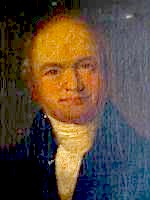 |
|
James Plumbe
portrait from David Morris
|
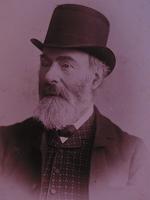 |
|
James Plumbe
photo from David Morris
|
10 July 1829, in Henley on Thames,
Oxfordshire, England
4 September 1829, in St. Mary's,
Henley on Thames, Oxfordshire, England
William Plumbe
Anne
(Outhwaite) Plumbe
Velebeth
Chibnall on 24 December 1857, in All Saints, Kempston, Bedfordshire,
England. James was aged 28 at his marriage.
Ironmonger
1894, in Bedford
district, Bedfordshire, England
1876: 230 Upper Street, Islington, Middlesex (London Gazette 18 February 1876 p783)
1891: 18 Gery Street, Bedford St.
Cuthbert, Bedfordshire
- 1891 census; exact date
from Keith Hazell
- Keith Hazell
- IGI marriage
extracts (Batch M005054); Keith Hazell
- Keith Hazell
- England Death Index
3Q1894 vol 3b p168
James Ashton Plumbe
1893, in Ashton Keynes, Wiltshire,
England
John Plumbe
Alice
Jane (Leaker) Plumbe
1901: Ashton Keynes, Wiltshire Age: 8; Place of Birth: Ashton Keynes,
Wiltshire
1945
The Gloucester records office has
numerous items of miscellania from James's youth such as school report cards
at Cirencester Grammar School (D4128/F11/7) and cricket fixture cards
(D4128/F11/8)
- England Birth Index
(1Q1893 vol 5a p57); exact place from 1901 census
- Gloucester Records
Office: D4128/F8/1
John Plumbe
12 January 1764
25 January 1764, in SS Peter &
Paul, Wantage, Berkshire, England
Samuel
Plumb
Mary
(Goff) Plumb
Sarah
Simmons on 8 February 1792, in Turville, Buckinghamshire, England
Draper. In 1778 John was
apprenticed to Robert Rathill of Henley upon Thames, Oxfordshire, a tailor
and salesman. This seven year indenture contains terms that seem astonishing
when viewed from a modern point of view. In 1792 John became a Burgess of
Henley and became an Alderman in 1812. In 1812 and 1824 he was the Mayor of
Henley.
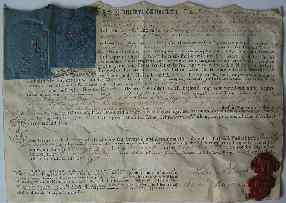
THIS Indenture Witnesseth,That John Plumb
Son of Samuel
Plumb
of Wantage in the County of Berks Clothier By and
with the approbation and consent of his said Father
testified by
his executing these presents
doth put him
self Apprentice
to Robert
Rathill of Henley upon Thames
in
the County of Oxford Taylor and Salesman
to
learn his Art, and with him
after the manner of an Apprentice to serve from the Twelfth
day of January last
past - - - - -
- unto
the full End and Term of
Seven Years from thence next ensuing, and
fully to be compleat and ended, during which Term the
said
Apprentice his Master
faithfully shall serve, his Secrets
keep, his lawful
Commands
every where gladly do ; he shall do no
Damage to his said Master
nor see it be done
of
others, but to his Power shall let or
forthwith give notice to his said Master of the same.
The
goods of his said Masterhe shall not waste, nor the same without
Licence of his to
any
give or lend. Hurt to his said Master
he will not do, cause, or procure to be
done ;
he
shall neither buy nor sell without his Masters
Licence. Taverns, Inns, or Alehouses he
shall not haunt. At Cards, Dice,
Tables, or any other
unlawful Games he shall not playMatrimony he shall not contract
~ nor from the Service of his
said Master Day nor Night absent himself, but in all things as an honest and
faithful Appren-
tice shall and will
demean and behave himself
toward
his said Master
and all his during all the said Term. And
the said
Robert Rathill in Consideration of the Sum of Six pounds to
him in hand paid by the Said
Samuel Plumb before the Execution hereof the Receipt whereof
the said Robert
Rathill doth hereby acknowledge -
- - - - the
said Apprentice in the Art of
Taylor & Salesman
which he now useth shall teach and
instruct, or cause to be instructed, the best Way and Manner that he
can, finding and
allowing unto his said Apprentice
sufficient Meat, Drink, Apparel,
Washing, Lodging, and all other Necessaries
during the said Term
And for the true
Performance of all and every the Covenants and Agreements aforesaid, either
of the said Parties bindeth himself
&
themselves firmly by these Presents. In witness whereof
the Parties abovesaid to these Indentures interchangeably have set their
Hands and Seals, the
Second Day of March in the EighteenthYear of the Reign of our
Sovereign Lord George the third by
the Grace of God of Great Britain,
France, and Ireland,
King, Defender of the Faith,
and in the year of
our Lord 1778
John Plumb
Saml
Plumb
N. B. The Indenture, Covenant, Article, or
Contract, must bear Date the Day it is executed ; and what
Money or other Thing is given or
contracted for with the Clerk or Apprentice, must be inserted in
Words at Length ; and the Duty paid to
the Stamp Office, if in London,
or within the Weekly Bills of
Mortallity, within one Month after the
Execution; and if in the Country, and out of the Bills of Mor-
tality, within two Months, to a
Distributor of the Stamps, or his Substitute; otherwise the Indenture will
be void, the Master or Mistress forfeit
Fifty Pounds, and another Penalty, and the Apprentice to be disa-
bled to follow his Trade, or be made
Free.
23 August 1840
29 August 1840, in St. Mary, Henley
on Thames, Oxfordshire, England
- Claire Freestone;
Keith Hazell; also recorded as aged 76 at burial
- IGI Batch C021982
- Oxfordshire parish
registers researched by Keith Hazell
- David Morris at www.steelbreeze.net
- England Death Index
3Q1840 vol 16 p11_; exact date from David Morris at www.steelbreeze.net
- Henley parish
registers researched by Mike Strange; parish registers researched by
Keith Hazell
John Simmons Plumbe
5 December 1792, in Henley on Thames,
Oxfordshire, England
11 January 1793, in St. Mary's,
Henley on Thames, Oxfordshire, England
John Plumbe
Sarah
(Simmons) Plumbe
Charlotte
Aldworth on 14 December 1815, in SS Peter and Paul, Wantage,
Berkshire, England
14 February 1854
3 March 1854, in Holy Trinity,
Henley on Thames, Oxfordshire, England
Draper, JP and Alderman. From
1833 to 1834, John Simmons Plumbe was the Mayor of Henley
- David Morris at
www.steelbreeze.net
- Oxfordshire parish
registers researched by Keith Hazell
- IGI Batch M021983
- Oxfordshire parish
registers researched by Keith Hazell
- David Morris at www.steelbreeze.net
John Plumbe
3 January 1797, in Wantage, Berkshire
(now Oxfordshire), England
30 January 1797, in SS Peter and
Paul, Wantage, Berkshire, England
Samuel Plumbe
Molly
(Aldworth) Plumbe
Elizabeth
Neate on 29 August 1822, in Cherhill, Wiltshire, England.
Matilda
Draper and Coal Merchant. John
is described as a draper at the baptism of his first two children and by the
baptism of the third he is an "agent". In the census of 1841 and 1851, and a
bond issued by his son in 1851, he is a coal merchant.
1851: Mill Street, Wantage, Berkshire
1868, in Wantage, Berkshire, England
- IGI Batch C021982; 1851
census
- IGI Batch C021982
- 1851 census; Keith
Hazell
- England Death Index
1Q1868 v2c p186
John Philip Plumbe
29 May 1823, in Holborn, London,
Middlesex, England
Samuel Plumbe
Caroline
(Payne) Plumbe
Probably known as Philip. The boy is
referred to many times in Rolls
Plumbe:
An
Authentic
Memoir of a Child in A Series of Letters to a Child, but is
always referred to as Philip.
- Birth recorded at Dr.
Williams Library (researched by Keith Hazell)
John Plumbe
27 February 1825
8 April 1825, in St. Mary's, Henley
on Thames, Oxfordshire, England
John Simmons
Plumbe
Charlotte
(Aldworth) Plumbe
November 1825
2 November 1825 in Henley,
Oxfordshire, England
- David Morris at
www.steelbreeze.net
- Oxfordshire parish
registers researched by Keith Hazell
- Aged 8 1/2 months at
death
- Henley parish
registers researched by Mike Strange
John Plumbe
31 May 1826, in Wantage, Berkshire,
England
28 June 1826, in SS Peter &
Paul, Wantage Berkshire
John Plumbe
Elizabeth
(Neate) Plumbe
Elizabeth
Jane Richards on 21 July 1851
Farmer. John farmed the Ashton
Fields
farm, in Ashton Keynes, Wiltshire. Many of the records of this farm
are held in the Gloucestershire Record Office (Reference: D4128).
In 1840, John had been apprenticed to "Jos. Plowman, Oxford, ironmonger,
brush factor, oil and colour merchant, tinman, smith and cooper", but we
have no further record of how John came from this apprenticeship to farming
the large Ashton Field farm. A bond issued in 1851 "from Jn. Plumbe jnr.,
Ashton Keynes, yeoman, to Jn. Plumbe snr., Wantage, coal merchant, to secure
£1000 and interest" does provide a clue!
In 1863, John Plumbe was given a
"Testimonial presented with a 'handsome purse to Mr. John Plumbe of Ashton
Keynes for the trouble and expense...that he has given to the prosecution of
a gang of South Cerney thieves'"
John Plumbe's family was clearly close to the family of Charles Hobbs of
Meysey Hampton in Gloucestershire. Not only did two of his daughters marry
two of Charles's sons, but we see in the 1871 census that Robert Hobbs is
visting the Plumbes at the Westham farm and that two of the young Plumbe
boys (ages 7 and 4) are visting at the Hobb's farm in Meysey Hampton. Both
families appear to have sent at least some of their boys to King
Alfreds
College in Wantage.
1871, in Cricklade district,
Wiltshire, England, aged 44
- Keith Hazell
- Keith Hazell
- from family Bible,
researched by Claire Freestone
- Keith Hazell;
Apprenticeship indenture at Gloucestershire Record Office (Reference
Code: D4128/F11/1); Bond D4128/A1; Testimonial D4128/F11/2. John Plumbe
is listed as a farmer in Ashton Keynes in the 155 Post Office Directory
of Wiltshire, the 1859 Post Office Directory of Wiltshire, and the 1867
Kelly's Directory of Wiltshire. Records in the Wiltshire and Swindon
Record Office pertain to further financial dealings on the farm
(Catalogue Ref. 1696)
- England Death Index
(1Q1871 vol 5a p26)
John Plumbe
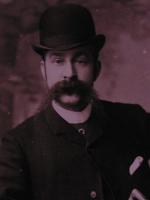 |
|
John Plumbe
photo from David Morris
|
12 September 1852, in Henley,
Oxfordshire, England
27 October 1852, in St. Mary's,
Henley on Thames, Oxfordshire, England
William Plumbe
Ann
Richardby (Strange) Plumbe
Draper
3 January 1898, in New Windsor,
Berkshire, England, aged 45
6 January 1898, in St. Mary's,
Henley on Thames, Oxfordshire, England
1881: Market Place, Henley on
Thames, Oxfordshire
- England Birth Index
4Q1852 vol 3a p441; exact date from Keith Hazell
- Henley baptism
registers researched by Mike Strange
- 1881 census
- England Death Index
1Q1898 vol 2c p305; exact date and place from Keith Hazell
- Keith Hazell
John Plumbe
20 July 1854, in Ashton Keynes,
Wiltshire, England
John Plumbe
Elizabeth
Jane (Richards) Plumbe
Alice
Jane Leaker in 1891 in Sandhurst, Gloucestershire, England
Farmer
20 May 1927, aged 72, at Ablington Manor, Bibury,
Gloucestershire
written 1895, proved 1927
1871: Westham Farm, Ashton Keynes,
Wiltshire
1881: Church Road, Ashton Keynes,
Wiltshire
1901: Ashton Keynes, Wiltshire Age: 46; Occupation: Farmer; Place of Birth:
Ashton Keynes, Wiltshire
John farmed Ashton
Fields
farm near Ashton Keynes from his father's death in 1871 until 1915.
(In the 1871 census, John and his mother are recorded on "Westham farm" but
since they are surely on Ashton Fields at this point, either Westham was an
earlier or alternative name for Ashton Fields, or there is an error in the
1871 census). In 1915, John moved to Manor Farm in Ablington, Bibury,
Gloucestershire which he farmed as a tenant of the Sherborne estate. Farm
records (Gloucester Records Office: D4128/F11/4) contain correspondence
congratulating John Plumbe on proving the guilt of a shepherd and receiver
of stolen lambs in 1892.
According to a short obituary in the "Gloucestershire Graphic" for May 28
1927, he was Chairman of the Parish Council and a prominent Freemason.
- England Birth Index
(3Q1854 vol 5a p27); exact date from Claire Freestone
- England Marriage Index
(2Q1891 vol 6a p517); exact place from Gloucester Records Office:
D4128/F11/3
- Gloucester Records
Office: D4128/C3; 1881 census
- Gloucester Records
Office: D4128/F11/9; exact date and place from Claire Freestone
- Gloucester Records Office:
D4128/F5/1
- Giving up Ashton Fields:
Gloucester Records Office: D4128/C3; Obituary from Claire Freestone
John Hulke Plumbe
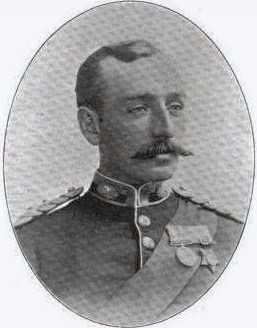 |
|
Major John Hulke Plumbe
|
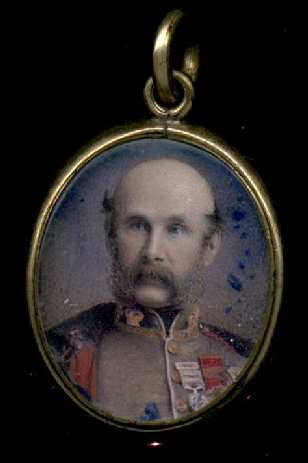 |
|
Portrait Miniature, possibly of Major John
Hulke Plumbe
The
miniature above, and the one of his wife, below, were found
amongst the effects of my grandfather, Ken Gosnell (John Plumbe's
nephew), with a note dated 2 Oct 1977 that reads "possibly Major
John Plumbe, brother of Annie Plumbe, and John Plumbe's Wife".
Some family members have expressed doubt that these minatures are
in fact John and Florence Plumbe. To me it looks like an older
version of the man in the photograph above, but John died aged 42,
and the miniature may be of a man older than 42. I do have another
likeness of Florence, so I really cannot say one way or the other.
|
2 June 1858, in Maidenhead,
Berkshire, England
8 July 1858, in Maidenhead Chapel,
Maidenhead, Berkshire, England
Samuel Alderson
Plumbe
Louisa
Burton (Hulke) Plumbe
John went to Philberds School on
27 January 1873. Later he attended the Kensington School of Art. On 6
September 1876 he went to Oxford
Military College, Cowley, and later trained at the Royal
Military College, Sandhurst.
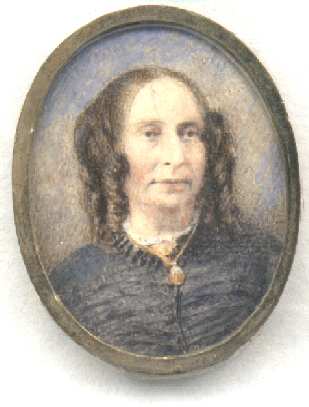 |
|
Portrait Miniature, possibly of Florence
(Hodgson) Plumbe
|
Florence Hodgson on 15 October 1889
at The Minster, Beverley, Yorkshire East Riding, England
London St James Gazette 17 October 1889 p14
MARRIAGES.
PLUMBE—HODGSON.--At The Minster, Beverley, Captain John H. Plumbe,
R.M.L.I., son of the late Samuel Alderson Plumbe, M.D., of Monkendons,
Maidenhead, to Florence, daughter of Colonel Hodgson, of Westwood Hall,
Beverley, Yorks, Oct. 15.
Florence, who was known as "Florrie", was born in 1860, in Beverley,
Yorkshire East Riding, and baptised on 26 April 1860 in St Mary and St
Nicholas, Beverley, the daughter of Richard Hodgson and Maria Helen Holden.
Florence died in 1946, in Dover
district, Kent, aged 85.
Census:
1861: Beverley St Mary: Florence Hodgson, daughter, is aged 1, born in
Beverley, Yorkshire
1881: Westwood
Road, Beverley St. Mary, Yorkshire
1891: Deal, Kent: Florence Plumbe, wife, is aged 30, born in Beverley,
Yorkshire
1911: Deal, Kent: Florence Plumbe is aged 51, born in Beverley, Yorkshire
Officer, in the Royal Marine
Light Infantry. John was commissioned as a lieutenant in the Royal Marine
Light Infantry on 19 September 1877 (London Gazette 26 October 1877 p5804).
According to his diary, he was hospitalised at the Royal
Hospital Haslar in 1879, with scarlet fever. John was a highly
qualified officer, being a specialist in gunnery, fortification, torpedoes,
and other subjects. He joined the flagship Duncan,
stationed at Sheerness in Kent, as a marine lieutenant on 18 August
1880 (Navy List January 1881 p163).
The first major action in which John participated was in the Anglo-Egyptian
War of 1882. This war was a suppression of a nationalist revolt led by
Ahmed 'Urabi
in February 1882. John sailed for Egypt with the Royal Marine Battalion on
29 June 1882. He joined the Alexandra, flag ship in the
Mediterranean, with seniority of 30 June 1882 and was present at every
action in which the Marines were engaged in during that expedition. On 11
July 1882 the navy began a bombardment
of Alexandria and a month later a large force of British troops under
General Wolseley occupied Alexandria as a staging location to secure the
Suez Canal and continue attacking 'Urabi. John participated in Royal Marine
actions at Tel-el-Mahuta near Kassassin in the Suez Canal zone on 28 August
and "Urabi's counterattack at Kassassin on 9 September 1882.
The
Royal Navy: A History from the Earliest Times to the Present, vol
7 p344
Preparations for a general movement from Ismailia along the Fresh Water
Canal towards Cairo went on steadily, until, at the end of the first
week in September a considerable British force was concentrated at
Kassassin, where on the morning of the 9th, the Egyptians attacked
again. On that occasion the Marines were on the left of the British
line, and with the King's Royal Rifles, soon began to drive the enemy
back. After the Egyptian artillery, which was posted on a ridge, had
been shelled, Captain Roger Pine Coffin, R.M.L.I., and Lieutenant
Herbert Cecil Money, R.M.L.I., led a successful charge of Marines up the
slope, and captured two Krupp guns, whereupon the enemy retired within
his earthworks.
Four days later John participated in the culminating battle
at Tel-el-Kebir, where he was slightly wounded in the hand and hip. He
received the medal
with clasp and bronze
star.
The
Royal Navy: A History from the Earliest Times to the Present, vol
7 pp345-6
For
three days longer the concentration at Kassassin continued. Then, on the
night of September 12th, Sir Garnet Wolseley moved forward the bulk of
his army over the intervening six and a quarter miles, marching in the
gloom of a moonless night; and early in the morning of the 13th he
surprised Arabi's army in its positions eastward of Tel el Kebir, and,
attacking it at once, defeated it with great slaughter.
The Naval Brigade on that day moved along the railway A battalion
of Royal Marine Artillery, under Lieut.-Colonel Henry Brasnell Tuson,
and another of Royal Marine Light Infantry, under Lieut.-Colonels Howard
Sutton Jones, and Samuel James Graham, also took part in the action, the
latter especially distinguishing itself. It formed the left of Major
General Graham's (2nd) brigade of Lieut.-General Willis's (1st)
division. After a long march, the brigade, as dawn was breaking, found
itself 1200 yards from the front of the northern portion of the Tel el
Kebir lines, but, having mistaken its way in the darkness, it was facing
in the wrong direction. While a change of front was being effected the
enemy opened fire, and ere the brigade was properly formed the fire had
become heavy. Lieut.-Colonel Jones sent forward three companies into the
firing line, and kept three in support, and two more in reserve, and so
attacked over ground which afforded absolutely no cover. But the men
moved forward with extraordinary steadiness, mounted the glacis, and
reserved their fire until they were within little more than 100 yards of
the ditch. The reserves, under Lieut.-Colonel Graham, then came up, and
the whole force dashed into the ditch with a cheer, scrambled over the
eight foot parapet on the other side, and engaged the Egyptians at hand
grips. The enemy, after a brief resistance, broke and fled and was
pursued for about four miles. The casualties in the Light Infantry
battalion were; killed, Major Henry Harford Strong, Captain John Charles
Wardell, one non-commissioned officer, and 10 men; wounded, Captains
Roger Pine Coffin, and Leaver Henry Gascoyne Cross, Lieutenants John
Hulke Plumbe, and Edwin Loftus McCausland, and 43 men. Lieutenant Wyatt
Rawson, R.N., who was acting as naval A.d.C. to Sir Garnet Wolseley, was
mortally wounded. He had undertaken to guide part of the force during
the night by means of the stars. "Did I not lead them straight?" he
asked the commander-in-chief, who rode back to visit him. He was
specially promoted to the rank of Commander, but died on the 21st.
The Naval Brigade was withdrawn to the ships on September 16th
and the gallant Marines saw no more fighting, for Tel el Kebir had been
the decisive battle of the campaign.
John returned to England from Egypt on 23 October 1882. John sailed for Hong
Kong on 29 April 1883, joining the Audacious, returning to be flag
ship on the China Station after a re-fit on 27 June 1883 (Navy List September 1883 p196). There he
transferred to the Victor Emanuel,
a receiving ship in Hong Kong with service effective 25 April 1883 (Navy List 1884 p250). John was promoted to
captain on 5 March 1886 (London Gazette 16 March 1886 p1281) and
returned to England in October 1886. In 1891, John was the instructor of
gymnastics at the depôt in Walmer (Navy List 1891 p181). John was promoted to
major on his appointment as paymaster on 22 January 1895 (London Gazette 25 January 1895 p487).
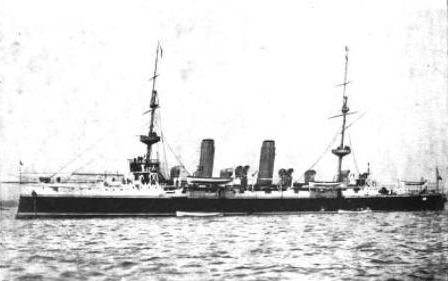 |
H.M.S. "DORIS."
The "Doris" the flagship of
Rear-Admiral Harris at the Cape, supplied the commander and some
of the men who fought under Lord Metheun, and in the Admiral's
cabin Cronje was confined after his surrender.
|
John sailed from Southampton to South Africa on the Union Steamship
Company's steamer Norman on 23
September 1899 (The London Times 22 September 1899 p8a), to
join his ship Doris, as British
forces in South Africa were being built up as tensions rose in the area. At
the outbreak of the Boer
War on 11 October 1899, the mobile Boer forces quickly attacked the
towns of Ladysmith, Kimberley and Mafeking. One of the immediate British
responses was to establish a Naval Brigade from ships presently in
Simonstown with orders to escort two 12-pounder guns up the railway toward
Kimberley although this expedition, after moving close to the front, did not
see action and the brigade eventually retreated to Queenstown, handed over
the guns to the Royal Artillery and returned to their ships in Simonstown
where a new Naval Brigade was already being organised. John was also part of
this new brigade going to join Lord Methuen's column for the relief of
Kimberley. I have quoted an extensive part from early in the book Naval Brigades in the South African War, 1899-1900
by Thomas T Jeans. Much of the account was written by Captain A. E. Marchant
of the R.M.L.I. and detail the activities of the Naval Brigade, of which
John was second in command, in the weeks before his death.
Naval
Brigades in the South African War, 1899-1900 pp2-18 (Thomas
T. Jeans, 1901)
On October 12
commandoes poured across the Natal frontier, and, on the other side,
Boers derailed and destroyed an armoured train patrolling the line south
of Mafeking.
Troops were but few in number; some were hurried up to Kimberley
just in time, and with the enemy arrogantly proclaiming their
determination to drive every Britisher into the sea by Christmas time,
the Navy was asking to be allowed to furnish a brigade to stem the tide
of invasion. On the 13th, orders came down to Simonstown for two
12-pounders with full field guns' crews of bluejackets to be held in
readiness to proceed to Cape Town. The Royal Marines began to think that
they were to be left out, but happily this was not to be for on the
following day the orders were amended and as many marines as could be
spared were to form the gun escort of the first Naval Brigade.
Then commenced a general bustle all round. Time was short and
many things had yet to be done.
The two senior officers detailed to land—one in command of the
whole Brigade and the other of the Marines—were ordered by the G.O.C. to
attend at Cape Town, to arrange details and receive confidential
instructions.
Khaki clothing, not then supplied to the Navy, was obtained from
the Ordnance Stores at Cape Town, piled into and on top of cabs, hurried
to the station and sent down by rail to Simonstown.
The officers met to discuss final matters and arrange personal
business, khaki was issued, also military great coats, to the
bluejackets, all equipment was got ready, and marines' belts, pouches,
and rifle slings were scrubbed and dyed a colour meant to be khaki, but
not quite, with permanganate of potash.
Some stout men, for whom no khaki could be found large enough,
tried the experiment of dyeing their white clothing a coffee colour. The
result may best be left to imagination. However, everything eventually
was arranged, and on October 20 the Naval Brigade landed from H.M.S.
'Doris' (flag), 'Monarch' (guardship), 'Powerful' (from China, homeward
bound), and 'Terrible' (to China, outward bound). There was tremendous
enthusiasm in the fleet. All hands on board manned and cheered ship, and
a hearty reply was given from every boat as it pulled ashore laden with
its khaki-clad bluejackets, stokers, and marines. Inside the dockyard
the Brigade was formed up for inspection by the Rear-Admiral Commanding
the Station, who made a short address, and specially confided the care
of the guns to the marines, saying, 'The corps must prevent them at all
hazards from being captured. With such an escort, I rest assured that if
the guns don't come back, no bluejackets or marines will come back
either.'
There were many dismal faces among those left behind, nothing but
cheerful smiles on the faces of those chosen as they formed 'fours' and
wheeled through the dockyard gates on their way to the station.
The Brigade was composed as follows:
Commander Ethelston of H.M.S. 'Powerful' in command.
Major Plumbe, R.M.L.I., of H.M.S. 'Doris' 2nd in command
9 Naval officers.
58 bluejackets.
7 Marine officers.
290 N.C.O.'s and men of the Royal Marines.
The guns were two 12-pounder 8-cwt. guns on ordinary field
mountings.
The road to the railway station was packed with an enthusiastic
cheering crowd of friends, and well-wishers. At the station the Brigade
entrained for Cape Town, and so well had the secret been kept, no one
knew what was to be the destination of this force. There were many
conjectures; not a few men said, in sorrowful tones, that they were only
going to Cape Town, to be stationed in the Castle for garrison duties,
and so release some soldiers for duty up country. The scene all along
the line was splendid. Thousands of people turned out and waved and
cheered vociferously. At Cape Town (Salt River Junction) a staff officer
boarded the train gave orders, printed and otherwise, the engine
whistled and started for——where?
All necessary precautions were taken against surprise, and orders
issued in case of being attacked, blown off the line, or otherwise
rudely interfered with. After proceeding for many miles it gradually
became known that the destination might
be De Aar. The trip went along splendidly and smoothly with
little or no excitement. Arrangements had been made for the issue of
rations, &c., and, to the joy of every one, RUM was to be issued
daily. It required some tact and patience on the part of all concerned
to shake the men together, comfortably and well, and it speaks well for
their discipline that no man had to be pitched into for any fault. Keen
to do their duty to the utmost and thoroughly and sincerely loyal to
their officers, it was very difficult to find fault with them, though
naturally the unusual conditions under which they found themselves
tended to get them a little 'out of hand' at first. On the route we got
occasional items of war news. The telegram announcing the victory at
Glencoe met us at one station and was received with round after round of
cheering and much enthusiasm.
The country until the Great Karroo is reached was very
picturesque, but there are no words to describe the desert. A
never-ending tract of waterless and treeless country, with an occasional
house, apparently put there by mistake. Beaufort West, a town of
importance, with many sympathisers of the Republics, was passed, and
eventually De Aar was reached. A large depôt was being formed here, and
one could not help being struck with the fact that it was a place very
exposed, and open to attack and capture. One amusing incident occurred
on the train. It was reported that a man speaking with a foreign accent
was seated on the engine, and would give no satisfactory account of
himself or of his movements, nor would he produce his pass or permit to
travel on the line. It soon became known amongst the men that he was a spy. There couldn't be a doubt of
it, &c., &c.
An officer interviewed him, could get no explanation from him,
and promptly had him placed in a luggage van, handcuffs on, and a sentry
mounted with orders to shoot him if he attempted to escape. Eventually
it was discovered that the foreign spy was a German boasting of an
English name, who was travelling up and down a certain section of the
line as railway and traffic superintendent.
Staff officers on the line could not give us any information as
to our destination, and all conversation with civilians was forbidden
and men kept in the train.
From De Aar the train was sent eastwards with a pilot engine to
look out for pitfalls. The Commander attached himself for duty as
amateur engine-driver and look-out man to this pilot engine, and at the
end of the journey when we reached camp it was hard to distinguish him.
He was as black as a chimney-sweep. The experience had been a trying
one.
It was reported that we might be attacked or blown up, and there
was great keenness amongst the men to be ready and under fire and get in
their first shot at 'they Bo-ers.'
On the way to Stormberg Junction, which was now known to be the
Naval Brigade's destination, we passed through Naauwpoort Junction, an
important place held by half a battalion of the Berkshire Regiment, and
which the Boers ought to have occupied at once.
We saw a number of refugees at Naauwpoort, who had been sent out
of the Orange Free State, and they looked very miserable and depressed,
and asked many awkward questions as to our doings, movements, and
destination. Secrecy was the order of the day, and even then it was hard
for the men not to talk.
Stormberg, an important railway junction, about fifty miles south of the
Free State border, was eventually reached on Sunday evening, October 23,
and it was a great surprise and pleasure for the Naval Brigade and
Marines to have so especially cheery a welcome from the Berkshire
Regiment—old friends and comrades of McNeill's zareba days in the
Soudan. The manner in which the officers and men of this regiment
treated us was beyond description. Nothing could possibly be kinder, and
it was a sad parting when good-byes had to be said later on.
Every one was very glad to get into camp at last and put in a
satisfactory sleep, for we had been working at tension during this train
journey, and what with the crowding and jolting had got very little.
Now that camp was formed the hard work of daily routine camp life
began.
The weather was bitterly cold at night and very hot by day. Every
morning we stood to arms at four o'clock, shivering with cold and
excitement, waiting for an attack by the Boers at dawn, but it never
came. But we could not slack up a little bit. It was always present in
one's mind how necessary it was to keep the men aware of the fact that
they were on active service—conditions very different from those of
peace. After the outposts were relieved, and mounted infantry sent out,
a good deal of necessary shaking-together drill had to be done, working
parties went away to dig and work on defences, washing parades were held
as often as possible, if water and time permitted, and before dusk the
night outposts marched away. These outpost duties fell very heavily on
the officers and men, but were always performed cheerfully, willingly
and intelligently. The men were generally away from camp for twelve
hours, and on arriving in camp were immediately detailed for other
duties, and there was no taking off of boots and clothes except for
washing, and even all parties sent away for washing took their arms with
them and had a covering party on the look-out for the slim Boer, who is
an expert in the art of sniping from safe cover.
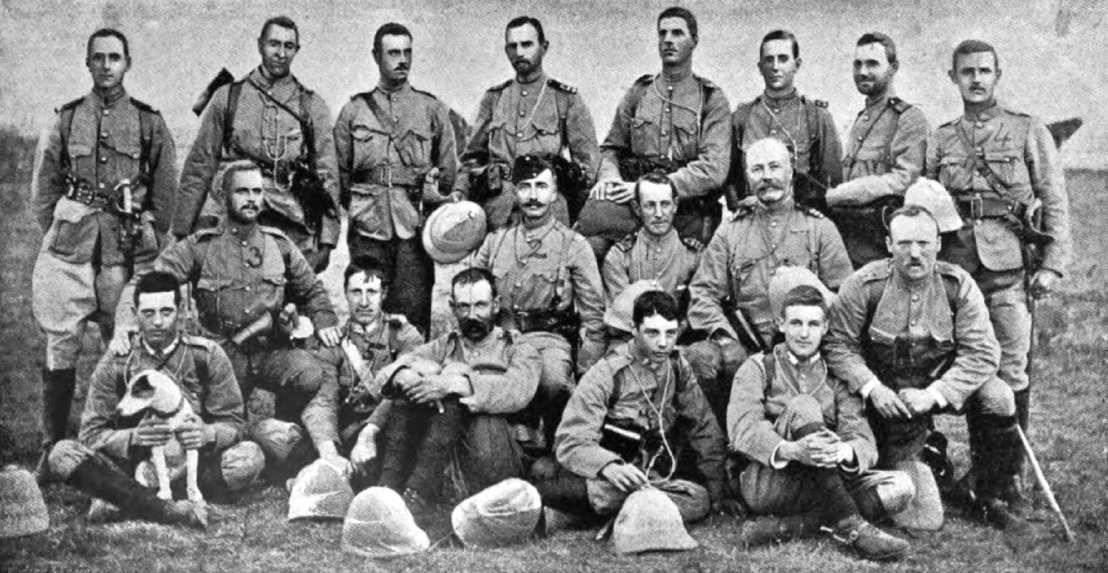 |
Officers landed with the Naval Brigade
to defend Stormberg, and who afterwards took part in the Action
at Graspan
John Hulke Plumbe is in the
center of the photo, marked #2
|
The Naval Brigade camp at Stormberg was
pitched on a plain surrounded by high kopjes (or rocky hills), fairly
well put into defence by Berkshires and the Naval Brigade. It is
difficult for those who know the place to realise how the disaster to
General Gatacre's force on December 11 occurred. The Berkshire Mounted
Infantry and infantry, from their experience of the country for some
months, must have known every inch of the ground.
The country south of the Orange River is of very peculiar
formation, and admirably suited to Boer tactics—Boers possessing, as
they do, that most important qualification, mobility. Boers were known
to be moving south near Norval's Pont and Bethulie, armoured trains were
busily occupied, and the men of the Naval Brigade had many exciting
times careering about with their mule guns. Probably this is the first
time in the history of the Navy that muleteers have been borne on ships
books.
The excitement at Stormberg began to increase as soon as General
Buller arrived at the Cape, and the Naval Brigade expected to be moved
forward and take a part—a very prominent part too we fully intended it
should be—in the general advance. Stores and provisions were piled into
the place as quickly as possible, ready for expected troops. We now
heard that the first Boer prisoners were to be put on board the
'Penelope,' and others on the cricket ground at Simonstown. One day in
camp we had a general alarm, turned out hurriedly, and then found out
that it was only for practice—very necessary, of course, but
disappointing, as we thought we were in for a fight.
After being in camp for nearly a fortnight, the Naval Brigade got
sudden and hurried orders to strike camp and prepare to move. Now was
our time, we thought, and every one worked his hardest to get things
together quickly, and take them to the station as ordered. We felt
certain that we were to move forward to fight some Boers who were known
to have crossed the Orange River, and were supposed to be marching on
Naauwpoort and Stormberg. Preparations had previously been made to
provision the various fortified places round about, as we expected to be
attacked at any moment.
On arriving at the station, we were grievously disappointed to
hear that our movement was to be by train to the rear, probably to
Queenstown, and when it was whispered that General Sir Redvers Buller
had, for strategic reasons, decided to withdraw the troops from
Stormberg, there was much regret expressed, and men were actually seen
to be weeping from disappointment. Never was disappointment more plainly
written on men's faces. It was some considerable time before the news
leaked out that our destination was Queenstown,
and we heard eventually that probably the disaster at Nicholson's Nek
was the primary cause of this hurried evacuation of Stormberg.
Chapter II.
QUEENSTOWN was reached at 7 P.M. on November 2, and a large and
enthusiastic crowd of inhabitants welcomed us. They seemed to look upon
the arrival of the Naval Brigade as their salvation. Camp was pitched
that night and next day the remainder of the Stormberg garrison arrived
and all necessary precautions for defence immediately taken in hand.
Before leaving Stormberg all stores were loaded up and those burnt for
which no room was available, and the defences destroyed. The Naval
Brigade had their first experience of the real discomfort of camp life
on active service soon after their arrival here, for suddenly a gale (or
dust storm) sprang up and blew most things away.
News of the progress of the campaign was very hard to get,
especially from Natal; the wildest rumours flew round, and very sinister
were some of these. We were much amused at getting letters from
Simonstown saying that the Naval Brigade at Stormberg was surrounded on
all sides, and likely to be cut up. We also heard of the Naval Brigade's
doings in Ladysmith and the death of poor Egerton.
A remount depôt had been formed at Queenstown, and the officers
of the Brigade were promptly fitted out with all necessary horse
equipment, and occasional riding parties did much to pass the time.
Cutlass drill on horseback as tried by two of the officers one day led
to a most amusing, and quite unintended, cavalry charge into the middle
of the tents, their frightened steeds not being used to such treatment.
Though we begged them to go through their interesting performance again,
they were much too modest to do so.
Queenstown itself is a charming little town lying on a plain with
a range of hills to the north. The inhabitants treated us well, and we
were eventually very sorry to leave. The Berkshires' band used to play
inspiriting tunes, and the fair inhabitants, many of them Boer
sympathisers, no doubt, enjoyed the unusual treat, and often were to be
seen in our camp, as guests. But we were very suspicious of everybody,
and the men were instructed never to give any information whatever to
strangers, and taxed their imaginations to give ingenious and misleading
replies. To one visitor, who, on being shown the guns, asked: 'What do
they fire?' the private of marines, remembering his orders, had a
brilliant inspiration, and replied: 'Oh, them there guns? Well, you see,
when our fellers 'ave to go away from camp on dooty we fires biscuits
after 'em. It saves a deal of trouble.'
The duties at Queenstown were very heavy for our men, and there
was plenty of digging and building for them to do; the weather being
bitterly cold at night, and exceedingly hot during the day. Sometimes
there was as much as forty-five to fifty degrees variation in
temperature, varied by occasional gales of wind, and dust storms, quite
enough to spoil one's 'stretch off the land' and temper. It was very
amusing on one night, when the top-gallant halyards of the mess tent
carried away, to see officers in varicoloured night garments running
about trying to keep the marquee from travelling heavenwards. However,
by dint of hard work, hard language, and a number of strong men the
situation was saved.
Some reinforcements were sent up to this garrison, but when the
railway west of Queenstown was cut it was decided to withdraw the
garrison altogether, and with bitter expressions on all sides, and much
sympathy from the Berkshires, the Naval Brigade was entrained for East
London. This disappointment was awful to us, as we quite thought that
all our chances of being in action had gone. We returned horses,
saddlery, water-cart, and all army stores, and actually handed over the
guns to a second lieutenant of Royal Artillery. To return without their
guns was an exceedingly great blow to our men, and the night before we
left it is vouched for that two of the gun's crew approached an officer,
and, after a good deal of scratching of heads and shuffling of feet,
asked permission to disable their guns. When asked 'what the devil they
meant?' they answered, 'Well, sir, seeing as how we can't take 'em back
ourselves, we don t want 'em to fall into the hands of nobody else.'
There were heavy hearts when the good-byes were said to our
friends in the garrison. The Berkshire band played us away, and a big
crowd assembled at the station to see the last of the Naval Brigade, who
during their short stay in garrison had become exceedingly popular.
Every one hoped to meet us again, and still hoped to meet us fighting.
At East London we were met by the senior naval officer, who said
it was quite true that we were to rejoin our ships. We had fondly hoped
that Natal might be our goal. Here the 'Terrible's' men of the Naval
Brigade embarked on board a transport for passage to rejoin their ship,
and to see some fighting in Natal, and the remainder embarked on board
the 'Roslin Castle,' and left immediately for Simonstown. Champagne to
drown one's sorrows and quench one's thirst was the order of the night,
and after a good dinner, a smoke and sing-song, we, to a certain extent,
forgot our sorrow and took a more cheerful view of the situation; but
the disappointment and disgust at being sent back, bloodless, to our
ships may be better imagined than described. At East London we heard how
well the Natal Naval Brigades had been doing, and wished and hoped for
our chance to come.
On the way round to Simonstown there was deep-seated anger at the
thought of being on the point of rejoining the fleet without having a
chance of fighting, and we wondered if we should be badly chaffed.
Imagine our joy on arriving on Sunday, November 19, to see men in khaki
parading on board the ships, and to receive a signal that a new Naval
Brigade was being organised, that we were to form part of it, that we
were to be entrained at four o'clock that same afternoon, all under the
command of Flag Captain Prothero, and that we were going to join Lord
Methuen's column for the relief of Kimberley. Round after round of
cheering rent the air, and there was a good deal of hand-shaking and
congratulations. Those of us whose wives were living at Simonstown were
lucky enough to be able to get ashore for a few hours, and then off to
the front again.
Chapter III.
THE force was reconstituted, more guns and more bluejackets were
taken, the whole of the force being made up to something like 400 of all
ranks—half of these being marines; four 12-pounder 12-cwt. guns on
improvised mountings (Scott's), with guns' crews, stokers for
stretcher-bearers, and a medical staff.
The same tremendous enthusiasm was shown on this day as on
October 20. The Rear-Admiral inspected us on the lawn of Admiralty House
and wished us God-speed; a south-easter blowing with unaccustomed vigour
gave us a final send-off, and we left to join Methuen's Kimberley relief
force in the highest spirits.
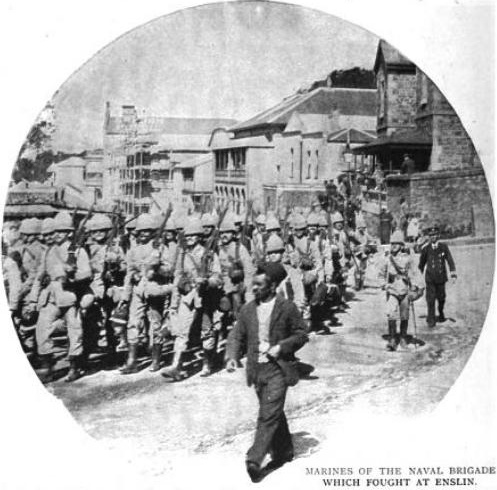 |
MARINES OF THE NAVAL BRIGADE WHICH
FOUGHT AT ENSLIN
The detachment is here
represented marching out of Simonstown on it way to the front.
|
The whole town and dockyard turned out,
and with drums beating and colours (if we had them) flying we marched
gaily to the station, entrained for Cape Town, being cheered all along
the route, and left at 9 P.M. that night for De Aar. Shortly after
leaving Beaufort two trains collided and blocked the line, and as our
Commanding Officer had orders to get on to Lord Methuen as quickly as
possible, he decided to transfer all our train load into another train
about half a mile ahead. It was a tough job, but the men splendidly
helped by a squadron of South African Light Horse, worked with a will
from 10 P.M. till 2 A.M. and did it, and we proceeded. The collision
looked a suspicious affair, but it was quite impossible to apportion the
blame. Probably Boer sympathisers were about. All necessary precautions
were again taken to guard against surprise, or to resist an attack, and
we arrived at De Aar without further incident. RUM was again regularly
issued, and was a very cheering addition to our mid-day meal.
Lord Methuen waited for the arrival of the Naval Brigade at
Witteputs before making his advance on Belmont, where a hard fight took
place on November 23, in which the Guards and Northumberland Fusiliers
behaved splendidly and suffered heavily, and the Naval Brigade came
under fire for the first time during the war. The Naval Brigade was
delayed marching with the force on account of the late arrival of its
transport, and the night march that followed was a particularly trying
one. All baggage of officers was cut down to 35 lbs., swords were left
behind, and much of the men's gear packed in a railway truck as base
luggage. One officer's horse, with brand-new saddlery, &c., bolted
and was never seen again. The horse was loot, so probably it was a
judgment. At 8.30 P.M. the Naval Brigade column, somewhat resembling a
long gipsy caravan, was finally mustered and got under way, the mules
being very troublesome, wagon loads heavy, and drivers not quite
experienced yet in their work. After some time two wagons got hopelessly
stuck in the heavy going, and the rear guard of one company of marines
was left to bring them along as well as possible. It seemed a hopeless
and endless task, but by dint of hard work and perseverance the column
did eventually reach the camp at Belmont, where water was very welcome.
A night march with obstinate mules is a very trying experience. The
Naval Brigade was fortunate enough to come into action and under fire,
but did not have very much to do in the fight. The going was very heavy
and in places very rocky for the 12-pounder guns on improvised,
dockyard-built wooden mountings. The weather was very hot; and mules and
men were much distressed and dead beat after this trying night march and
fight.
A. E. Marchant
More details of the Naval Brigade's actions at Belmont can be found
in Captain Prothero's dispatches:
The London Gazette 30 March 1900 pp2125-6
H.M.S.
"Doris," Simon's Bay,
SIR,
4th December, 1899.
IN accordance with your orders I left Simon's Bay on Sunday
the 19th November, and arrived with the Naval Brigade at Lord Metheun's
Headquarters at about 1 o'clock on the 22nd. On reporting myself to Lord
Metheun I received orders to accompany him that afternoon to Belmont.
Having to wait for transport from Orange River, which arrived very late
in the evening, I could not manage to leave until the brigade had
already marched some hours. Having packed waggons and harnessed mules I
marched at 8.30 to Belmont. Being a long column it was necessarily a
very slow march, and the mules were troublesome.
2. On arriving within one mile of Belmont I received orders
through a staff officer to go back along the road, and to be in Belmont
by 3 o'clock next morning to report myself to the General. On arriving
at headquarters at 3 A.M., I received orders to communicate with Colonel
Hall, commanding Royal Artillery; having met him, I marched out of
Belmont by road in company with Colonel Hall's battery of Field
Artillery. After clearing Belmont kopjes, we turned off the road on the
open veldt; day was just dawning, and we could see the top of the line
of kopjes held by the enemy. We were then advancing towards the centre
of his position, over very rough ground intersected with dykes. This
tried our gun-mountings very severely.
Unfortunately, one gun capsized, but was soon righted, and I was
relieved to find that there was no damage done, and that the dockyard
work stood the test so well.
On proceeding to higher ground, a view of the Boers position was
then obtained. A long line of kopjes, which looked very much higher at
dawn of day than they really were, the light being very bad indeed, and
the sun coming up behind the kopjes cast dark shadows, which made it
very hard to distinguish any objects. In addition to this there was a
mist round the lower part of the kopjes.
3. Firing was now going on in our front, the Boers evidently
having been repulsed. Colonel Hall here turned away to his left, and to
the left of the Boer position, on the understanding that I should take
up a position across the railway line on higher ground, and he would
soon communicate with me. This I did, but had great difficulty in taking
my heavy ammunition waggons and guns across the railway-line, finally
succeeding. I here brought the battery into action to try the range of
the extreme depth of the Boer position, but after firing a range-finding
shot, and not seeing it pitch, I limbered up.
4. Hearing heavy firing on the right of the position, and not
having had any communication from Colonel Hall, I determined, if
possible, to get the battery in range of the large kopje, which a
battery of the Royal Artillery were shelling. The guns not being mobile,
and having to cover heavy ground I was unfortunately too late to take
part in shelling the top of the kopje, which the guards carried.
5. I then turned to the left between two kopjes, and found the
Boers on the rear kopje, firing upon advancing infantry. I immediately
got the battery into action, and at 1,700 yards shelled the Boers, who
were firing on our troops, the practice being excellent. The Boers were
very soon silenced and retreated.
6. I received orders from the General to take my guns, if
possible, on to a low kopje, about 800 yards from my front, so as to
shell the retreating Boers from their position. I limbered up, and
advanced as quickly as possible over very rough ground, and advancing
well ahead myself to survey the kopje. I found, when I arrived on top,
that it was impossible to take wheels over it, so reluctantly had to
give it up. Here my officers, men, and mules were almost dead beat, and
the battle over. Having watered my mules, I returned to the camp with
the remainder of the troops.
After the victory at Belmont, Metheun's column continued up the railway line
towards the next Boer entrenchment at Graspan, near Enslin station.
Naval
Brigades in the South African War, 1899-1900 pp20-34 (Thomas
T. Jeans, 1901)
CHAPTER IV
THE general advance along the railway was recommenced at 1.30 P.M., the
armoured train moving abreast of the Division, and being followed by
another train with the naval-12 pounders on trucks. Lieutenant Dean was
in command of these, and their mule teams had been lent to the field
batteries, in order that the exhausted horses might reserve their
strength till actually in contact with the enemy.
Our destination was two shallow dams, about seven miles north of
Belmont, and as it was expected that their possession would be
contested, the advance was exceedingly slow to allow of very careful
scouting ahead. However, the Boers were good enough not to give any
trouble, and at sunset a final halt was called, and the Division
bivouacked for the night, between two small kopjes on either flank, the
Naval Brigade occupying the post of honour on the extreme right, and
throwing out a company of marines to hold a narrow 'nek' of rising
ground in the right rear.
The local topography of this narrow 'nek' became tolerably well
known that night, for on the opposite side lay the two dams from which
water had to be obtained.
The men, carrying water bottles and mess tins, were taken across
a company at a time, and will not readily forget these excursions. The
night was extremely dark, except for the occasional treacherous light of
a quarter moon; great boulders brought them up with a 'round turn' and
barked shins; loose stones tripped them and spilt the water they
carried; and deep holes, concealed by long grass, laid pitfalls for
those who had managed to steer clear of other dangers.
These dams were only three-quarters of a mile away, yet the
double journey occupied two hours, and as they were very shallow, with
about twelve inches of mud and three of water, more mud than water was
brought back. However, we tried to imagine it was rum.
By the time water was obtained and fires burning brightly it was
reported that our commissariat wagons had dragged themselves up, so the
gunner went off in the dark to hunt for them, and after a long search
returned with sufficient tinned meat and ship's biscuit to issue a small
ration to all. As a great luxury, the officers opened a tin of preserved
kidneys, and these, biscuits and muddy water, eaten round the fires,
formed our supper.
The fact, however, that this was 'real soldiering' made the fare
seem luxurious, and in the circumstances, the 'sardine, beer, and onion'
suppers after a long 'coal-ship' day could not stand comparison.
Supper being finished we smoked round our fires and discussed the
situation generally, the chances of getting some sleep and the probable
events of to-morrow.
'We must get the
chance of a "show" before reaching Kimberley,' was the general opinion,
and the 'show' we meant was a little infantry work in addition to our
long-range artillery business.
Almost as this opinion was expressed, out of the darkness into
the light of our fire stepped the good fairy we had invoked, a somewhat
dust-grimed A.D.C., inquiring 'Is this the Naval Brigade?'
'Yes, old chap. Sorry we can't give you a drink.'
'I want the officer commanding.'
We directed him to Captain Prothero, and heard him say as he
handed the captain some orders, 'You will have a nice job to-morrow,
sir, something more to your liking.'
Immediately the officers were summoned, and the captain read the
laconic order, 'The enemy, about four hundred strong, hold a hill on our
line of advance two miles to the north. The Naval Brigade will lead the
attack, supported by the K.O.Y.L.I. and a field battery. . . .' Then
followed precise instructions as to movements and dispositions.
'Good night, sir,' said the A.D.C., and disappeared.
At last the Navy was to have a 'show' all to herself; the news
seemed almost too good to be true, and it was some short time before we
could believe it and realise our luck.
The officers went to their companies, and told them there would
be work for them next day, though the actual arrangements were kept
secret. A thrill of excitement ran through the Brigade. 'By Jove, what
sport!' said a midshipman. 'What luck!' said an officer of marines. 'Is
it really true, sir?' asked a company sergeant, radiant with the
anticipation of an infantry job; every one felt a sense of subdued joy
and satisfaction that something was
going to happen to-morrow. The only people that night who did not share
equally in the good news were the fifty bluejackets manning the guns on
the railway, who would have to stay with them, and would not be able to
take part in the infantry attack.
The men lay down by their arms and the officers in groups of two
and three, but sleep was long in coming, fitful and but little
refreshing when it came.
The night was very cold; the wagon with our blankets, great
coats, and waterproof sheets had lost its way in the darkness and could
not be found; it was impossible to find a spot where we could lie down
without resting on the sharp corner of some rock, and in our thin cotton
khaki we shivered through the night. It was our first experience of a
very cold night after a hot day, and without our blankets we did not
enjoy it.
The picket in the right rear was relieved at 11 P.M.
Saturday, November
25.—The picket was withdrawn at 2.30 A.M. and the Brigade stood to arms
at 3 A.M. Magazines were charged and rifles carefully examined. This
being done we marched silently down to the place of assembly and were
joined by the cavalry, mounted infantry, and the K.O.Y.L.I., the
remainder of the 9th Brigade forming up in rear and the Guards in charge
of the baggage. At 3.45 A.M. an advance was made in mass of
quarter-column, the spaces between companies being slightly opened out.
The mounted troops bore away to the flanks, and in the growing daylight
we could just make out a hill ahead of us which we imagined was our
objective and on which we could see a few figures moving against the
sky-line. As we drew nearer a murmur of disappointment ran through the
ranks, for these moving figures turned out to be our own scouts and we
were afraid our chance had gone.
However the Boer position was not nearly reached yet.
The whole Division advanced parallel to and about a mile on the
right of the railway, the cavalry well away on the flanks, the two field
batteries well to the front, and the Naval Brigade proudly leading the
infantry. Slowly puffing along the line on our left was the armoured
train, with the naval 12-pounders on trucks behind it, and away on our
right the sun was just appearing over the horizon.
The air was delightfully cool and bracing, and we marched over
the veldt at a steady pace, the 'going' being very good. Occasionally we
halted for a few minutes.
After marching for a couple of hours the scouts came in touch
with the enemy and found their main body strongly posted in a position
very similar to that at Belmont, except that the line of kopjes they
held was broken in their left centre and the kopjes themselves did not
run so high. The extent of the position was about three miles from flank
to flank, running eastwards at right angles to the railway. The right
flank was beautifully drawn back, and the field of fire commanded was,
if possible, more nearly approaching the ideal than even that at
Belmont, with splendid opportunities for posting and concealing guns
amongst the rocks, whilst attacking artillery had no commanding
positions to seize and would have to unlimber in the open. There was not
the slightest cover for an attacking force except for an occasional
ant-hill dotted here and there over the veldt, which extended for
thousands of yards round the front and flank and was covered with rank
brown grass about eighteen inches high.
Away on the enemy's extreme left stood a boulder-strewn kopje,
higher than the rest, a fortress in itself. It appeared to be almost
isolated, but we found later that a low lying spur, covered with great
rocks, ran out towards and a little in front of it from the central
kopje, and gave splendid cover for a deadly cross-fire as we advanced to
the attack.
Its strength and size were such that it evidently formed the key
of the position, and it was against it that the attack was ultimately
pushed home.
A field battery now galloped out and commenced shelling it at a
range of about 2,500 yards. On our left the naval guns and the other
battery were also in action and were being vigorously replied to by two
Boer guns.
Thus about seven o'clock — we had already marched for three hours
it must be remembered—
the general position was as follows. The Naval Brigade, extended
to single rank, leading, and the 9th Brigade, similarly extended in
support, were opposite the right centre of the Boer position and distant
about 3,500 yards. The Guards' Brigade was guarding the baggage on the
railway, the cavalry were hovering round the enemy's right to intercept
their retreat, one battery and the naval guns were busy on our left, and
the second battery far away on our right flank was pouring shrapnel over
that isolated kopje on the Boer left.
At this point the intended attack on the Boer left flank
commenced to develop. The Naval Brigade, now extended to four paces, the
K.O.Y.L.I. and the half-battalion of Royal North Lancasters were ordered
to move away to the right, and the remainder of the 9th Brigade,
consisting of the Northumberlands and Northamptons, pushed on, straight
ahead, for the centre of the enemy's position, to demonstrate against
this point and to act as a containing force.
Slowly we laboured across the front of the kopjes whilst the guns
merrily pounded away, and extended as we were in a line about eight
hundred yards long, perhaps longer, this diagonal march of nearly two
miles was very tedious.
Not quite certain why this movement was taking place, for only
the commanding officers knew exactly what we were intended to do, we
trudged along through the coarse grass, keeping our left shoulders well
up to avoid the ugly rocky kopjes in our immediate front. The sun was
beginning to be very hot and we were becoming somewhat 'droopy,' as no
one had had any breakfast, except a few who had been wise enough to save
a little biscuit or bread from their supper over night, and we had been
marching already for three hours and a half. The men were taking
frequent 'pulls' at their water bottles, and the advice to 'Save your
water, men, you'll want it presently,' had not much effect. Lucky were
those who still had a little two hours later.
Now and then a greis-buck would get up and scamper down the line;
and sometimes a covey of frightened partridges would remind us that we
had rifles in our hands, not shot-guns.
We glanced at the kopjes and almost wondered why the guns poured
such a tempest of shrapnel over them; rarely did we catch sight of a
figure moving among the rocks, and with the exception of the enemy's
guns on their right, vigorously replying to our own, the whole position
looked harmless and untenanted.
At 7.45 we were some seven hundred yards from the base of the
isolated kopje on the Boer left, and the field battery ceased filing.
Almost immediately from the rocks, which a moment before seemed
lifeless, there opened the wild crackle of Mausers.
Bang! Bang! the battery commenced again, firing over our heads.
Even now our firing line was continuing its diagonal march, but at the
moment we heard the crackle of musketry and the whistling of bullets
each man instinctively turned to his front and the line paused.
Captain R. C. Prothero, R.N., led the advance, and Major J. H.
Plumbe, R.M.L.I., Captain A. E. Marchant, R.M.L.I., and Colour-Sergeant
Dyson were in advance of the various marine companies.
Midshipman T. F. J. L. Wardle acted as A.D.C. to Major Plumbe and
accompanied that officer. In some places the line was somewhat crowded
and 'bunched,' but the average extension was about four paces.
As supports, there were seven companies of the K.O.Y.L.I., which
later on reinforced the right of the firing line, and in reserve, the
half-battalion of the Royal North Lancasters.
The composition of the firing line from right to left was as
follows:
1 Company of Bluejackets {Comm. A. P. Ethelston, Lieut. Hon E. S.
H. Boyle, Gunner E. E. Lowe, Midship. C. A. E. Huddart, Midship. W. W.
Sillem} 55
{'A' Company R.M.A. Captain Guy Senior
'B' Company R.M.L.I. Lieut W. T. C. Jones
'C' Company R.M.L.I. Lieut F. J. Saunders } 190
1 Company of K.O.Y.L.I. 85
Total strength of firing line 330
The Brigade paused and half wondered what all this crackling
going on in front meant; there was a sound of whistling in the air, and
instinctively we raised our left arms as if to protect our faces from a
hail storm.
Advance! Advance! And on we went at the 'quick'; the crackling
grew fiercer and we looked anxiously to see if any one was hit.
Down dropped three men, falling forward; 'Get up!' shouted an
officer, but only one rose and he was dazed and bleeding from the back
of the neck—a shrapnel had burst overhead.
A few paces forward and the line sank down; officers shouted the
distance—600 yards; non-commissioned officers gave, 'Volleys! Ready!
Present! Fire!' and those of the men who heard obeyed. Fire control was,
however, almost impossible; the men were too far apart and the noise of
the enemy's fire drowned all orders.
Officers and men quickly grasped the situation and used their
rifles independently. This was our first halt after coming under fire,
and from here onwards the attack took the form of a succession of short
rushes.
The line worked automatically, firing rushing on and dropping
down to fire again. Men advanced, crouching low, some holding their
water bottles in their left hands, ready to moisten their lips at the
next halt; the scorching heat and overwhelming excitement had parched
our throats, and each drop of water gave us strength for another spring.
As the line halted each man threw himself at full length on the
ground, drew himself to a tuft of grass, loaded his rifle, adjusted his
sight and fired at the top of the kopje. Only an occasional head was
visible there, and it is an extraordinary fact that, though under fire
for the first time, many men, in order to make their aim more accurate,
actually lowered their sights frequently as they advanced, disregarding
the rule laid down of fixed sights below 500 yards, and thus displaying
a most unexpected coolness during a period of intense excitement.
The Boer fire was hottest between 500 and 200 yards—a short-range
fire in front from the crest of the hill sending down a continual stream
of bullets—ploughing up the ground all round us, splashing against
stones and rocks, and flying by with a shriek, or whistling past us with
a noise like the crack of a whip. But a far more deadly cross-fire swept
the line from our left. This came from the before-mentioned rocky spur
jutting out from the central kopjes, and down to which the Boers had
poured, to reinforce their left, and to get away from the fire of the
guns near the railway.
Here they were unmolested, except for an occasional shell, and
could use their rifles with deliberation.
Most of our casualties took place whilst dashing on; some were
shot as they lay firing, all remained helpless where they were struck
down on the open veldt and frequently were hit again and again as they
lay. Those who could do so dragged themselves to an ant-heap or tuft of
grass and waited for the next bullet to hit them. Others, regardless of
wounds, struggled on till brought down by another.
The officers lost heavily. Commander Ethelston, Major Plumbe and
Captain Senior were shot dead, Captain Prothero, R.N., and Lieut. Jones
were both severely wounded, and Midshipman Huddart was mortally wounded
whilst struggling to advance after being twice hit.
Nearly all the petty officers and non-commissioned officers were
killed or wounded, but the line still advanced without the slightest
wavering. One may well ask how the men were led?
Drill books have taught that men should not lie down during the
last 500 yards of the attack, because of the supposed impossibility,
once they had laid down, of making them rise and face a short-range
magazine fire.
It is certain, however, that the whole attack would have been
swept away if they had remained on their feet continually, and there was
no difficulty whatever in making them 'rise up' again. They wanted no
leading; they were only too anxious to close with the enemy and get it
over; many, in fact, had to be restrained to prevent the line losing its
cohesion. If an officer sprang up, all his men followed like clockwork;
there was no hesitation, and so it continued till the foot of the kopje
was reached.
Here we were to a great extent sheltered by the very steepness of
the kopje, and paused to take breath in this 'dead space,' the bullets
flying past well overhead. Whilst we waited, our supports of the
K.O.Y.L.I. rushed across the fire-swept belt we had just crossed and
reinforced our right, bayonets were fixed, and on we went again.
Climbing was difficult and we had in places to haul ourselves up
on hands and knees, painfully and slowly. The frontal fire never ceased
till we were within twenty-five yards of the top, and then we knew the
Boers thought it was time to quit. With a last scramble and rush we
gained the crest only to find the enemy flying down the other side.
We still had to keep under cover, for they gained the shelter of
some rocks a few hundred yards in rear of the kopje they had just
vacated, and opened fire. We were also again enfiladed from the left,
but two companies of supports, swinging round their right and manning
the left of the kopje, completely commanded the rocky spur to which the
Boers were still clinging and quickly drove them out. The only thing now
to be done by infantry was to dislodge the few Boers who remained to
cover the main retreat. This was done by men of various corps, but
luckily for the enemy they were partially screened in this retreat by
the smaller kopjes, and as they had already jumped on their horses and
obtained a good start, they got away almost unscathed until they were at
long range, when a few probably useless volleys were sent after them.
They had purposely galloped through the dam (pond)—the only water
supply—to stir up the mud and spoil it for drinking.
Officers and men were terribly disappointed at not closing with
them, and still more so when their wagons and baggage could be seen
trekking northwards across the open veldt as fast as they could go, and
we were powerless to stop them. The batteries galloped round and fired a
few shrapnel, but did little damage, and the cavalry horses were in such
poor condition that they had to give up the pursuit.
Meanwhile the remnant of the Naval Brigade assembled under
Captain Marchant R.M.L.I., the senior unwounded officer present, and the
work of collecting the wounded and burying the dead commenced.
Many were the anxious inquiries for those who no longer answered
to their names. They lay in little brown patches, dotted over the veldt
at the foot of the dearly-won kopje, some dead, others with life fast
ebbing most of them helpless with wounds. Looking down from the top of
the kopje we could see the surgeons and their orderlies already moving
amongst them, stopping at each prostrate khaki figure to give first aid,
or turning it over to make certain that life was extinct and passing on
to the next. Many that day owed their lives to Fleet Surgeon Porter and
his stoker stretcher-bearers, who had followed close in rear of the
firing line, and had done their work under the hottest fire.
Already the collecting place for the wounded had been formed, and
backwards and forwards toiled the stretcher men, in the terrible heat,
with their human burdens.
Now, down from the kopje, came the survivors to look after their
messmates and lend a hand in getting them to the ambulance. 'For God's
sake, a drop of water!' was each man's cry; one, mortally wounded and
with one arm smashed, unable to pull out the stopper, had bitten off the
metal neck of his water-bottle in the agony of thirst and pain.
As they found a messmate they would ask, 'What's up, Towney?'
'They've got me' would be the reply, and the injured part proudly
pointed out.
The number of marvellous escapes had been very great. There was
scarcely an officer or man who had not had his clothes or accoutrements
shot through; one officer, over six feet high and very broad, had four
bullets through his uniform without being even scratched.
The marines of the Brigade added that day yet another leaf to the
laurel wreath, the badge of their corps. They had lost two officers, and
nine men killed, and one officer and seventy-two men wounded (including
eleven non-com.'s) out of a strength of five officers and 190 men: or a
percentage loss of 44.
... W. T. C. Jones.
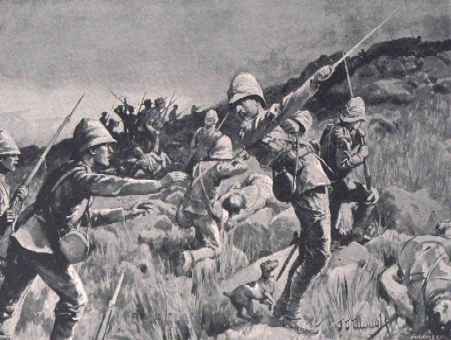 |
|
DEATH OF MAJOR PLUMBE AT THE BATTLE OF
ENSLIN.
His
little
terrier followed him up the hill and kept watch by him for hours
after he had been mortally wounded, until he was picked up by the
ambulance.
|
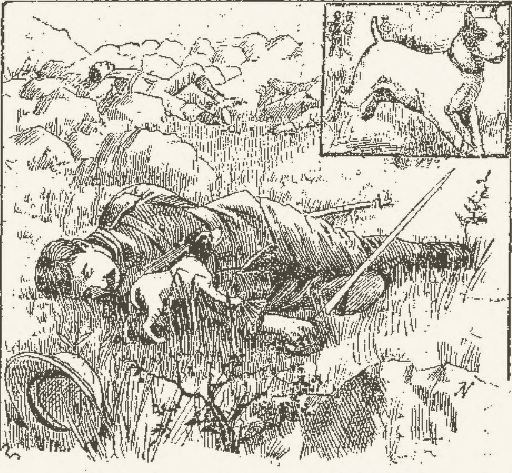 |
|
PATHETIC INCIDENT OF THE AFRICAN WAR
The picture here presented was sketched by Lester Ralph, special
correspondent of London Black and White with Lord Metheun's
forces. He calls it "The Faithful Terrier, " and explains that at
the battle of Graspan Maj. J. H. Plumbe, of the royal marine light
infantry, was among the many killed while storming the main kopje.
He had a pet dog, a terrier, which ran up the hill with him under
the fiercest fire imaginable. When he fell the dog sat down and
guarded his body until the ambulance removed it six hours later.
The pathos of the situation baffles description.
|
25 November 1899, in Graspan, Cape
Colony, South Africa, shot through the heart.
John died in the Battle
of
Graspan, in the Boer War. This battle is sometimes known as the Battle
of Enslin, or Rooilaagte. In H. W. Wilson's With the Flag to Pretoria pp150-2, there is
a more general account of the battle, including this description of the
Naval Brigade's frontal assault on the kopje, and the loss of Major Plumbe:
The Naval
Brigade led the storming force, extended in a single line, each man six
paces apart from his neighbour on either hand. "As the line passed me,"
writes Colonel Verner, "I noted how each hard, clean-cut face was from
time to time anxiously turned towards the directing flank, so as to
satisfy each individual that the interval and dressing were properly
kept. . . . No better kept line ever went forward to death or glory." As
they began the ascent, advancing by brief rushes in very open order, the
hill suddenly appeared to swarm with enemies; from the crest, from
behind every boulder, poured a murderous fire. The naval officers of the
brigade still carried swords and could be readily distinguished; they
were the target of every Boer rifle. "In the breathing time between the
rushes of the assailants," says Colonel Verner, "one conspicuous figure
was to be seen standing erect, and marking the station taken up by the
Naval Brigade. This was their commanding officer, Captain Prothero,
R.N., a man of great stature and immense physique, who elected thus to
stand leaning on his walking-stick while his men, lying prone, gathered
breath for another rush. . . . Eventually the inevitable occurred and he
was seen to drop, happily only wounded and out of action for a time." It
was at this point that Commander Ethelston of the Powerful
was hit half-a-dozen times and killed, and that Major Plumbe of
the Marines, who was gallantly leading in front of his men, closely
followed into the storm of battle by his little terrier, staggered,
shouting to his superb soldiers not to mind him, but to advance. He
never rose again.
... Throughout the advance of the Naval Brigade the naval officers
behaved with the most reckless and devoted courage. "Your fellows are
too brave," said a soldier-officer of famous gallantry to a
sailor-officer. "It is utterly useless for you to go on as you do, for
you will only all get killed in this sort of warfare. I saw your
officers walking about in front of their men, even when the latter were
taking cover, just as if they were carrying on on board ship." "Did you
watch the Naval Brigade?" said Colonel Barter to a staff officer. "By
Heaven, I never saw anything so magnificent in my life."
John's last words, after his wounding, were encouragement to his troops to
keep going..."Forward! never mind me."
John's death with his faithful terrier was the subject of a poem by Baroness
D'Anethan.
Black and White Budget 26 May 1900 p230
THE LAST WATCH.
Baroness d'Anethan, of the Belgian Legation at Tokyo, Japan, who
is one of our readers, having been much struck by tlie incident in the
battle of Graspan, when Major Plumbe's pet terrier dog followed him
through the fiercest fire, and was found six hours after the fight,
guarding his master's dead body, has written the following verses :—
"Good-bye, my dearest dog, my faithful Tip."
He faltered—as in accents low and kind,
And swimming eye, and pale and trembling lip,
Before he left—he gave one look behind.
"Good-bye, good-bye, old dog," he breathed again,
"For where I go, old friend, you must not come."
And with these words, he strode across the plain,
Dreaming his last sad dream of love and home.
'Mid cannon's roar, and rifle's deaf ning crack,
One has but little thought of woe or weal;
But once Tip's master gave a quick glance back,
And smiled to see Tip trotting at his heel.
The kopje's stormed, fierce raged that dreadful fight.
They gain the top at last with British yell!
With one last piercing cry for "Queen and Right,"
One prayer—one thought—one groan—Tip's
master fell !
The battle's o'er; while there, beneath the skies,
The hero's life blood stains the dark earth red.
In death's grim agony Tip's master lies;
But trusty Tip is watching by his head.
Ah ! loving, faithful Tip! he licks the hair
That clotted lies upon the noble brow;
And raises on those features once so fair,
A wan faint smile in that dark hour of woe.
He feebly strokes Tip's round and silky head;
The effort's great, and with a last low groan,
The hero murmurs—as he sinks back dead,
"I thank Thee, God—I do not die alone."
The hours drag on, and midst the broken cries
Are mingled raging wind and beating rain.
Yet when at length dawn glimmered in the skies,
The terrier still stood guard beside the slain !
26 November 1899, near Enslin Station, Cape Colony, South
Africa
Naval
Brigades in the South African War, 1899-1900 pp38 (Thomas T.
Jeans, 1901)
The men killed
were buried near the foot of the kopje, but the three officers were
buried next morning at Enslin, a little east of the siding there, on a
bare, red plain; a pity almost that they should not have remained with
the men who had fallen with them and beneath the shadow of the hill they
had laid down their lives to gain.
Our men put up a rough, wooden cross, and the Australian Light
Horse fenced the grave in, a deed for which the Navy will be for ever
grateful.
A memorial to John Hulke
Plumbe can be found at the West End Cemetery in Kimberley, South
Africa. The memorial reads:
In memory of the Officers of the Royal Navy and
Royal Marines of the Naval Brigade who fell at the battle of Graspan, 25
November 1899, Commander A.P. Ethelston, R.N. H.M.S. 'Powerful' Major J.H.
Plumbe, R.M.L.I. H.M.S. 'Doris' Captain G. Senior, R.M.A. H.M.S.
'Monarch''
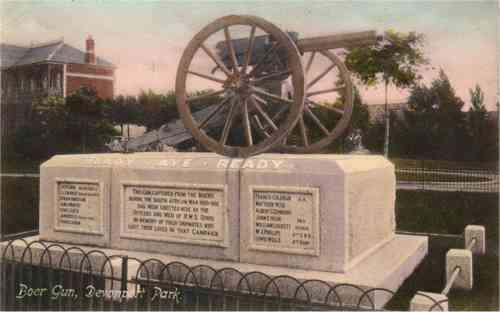 |
|
HMS Doris "Gun" Memorial in Devonport,
Devon
|
The HMS
Doris
"Gun" Memorial in Devonport, Devon has an inscription that reads:
READY - AYE - READY
This gun captured from the Boers during the South African War 1899-1902
has been erected here by the Officers and Men of HMS Doris in the memory
of their shipmates who lost their lives in that campaign.
J H Plumbe, Major, HMLI; C A E Hubbart, Midshipman, RN; John Boyle,
Private, HMLI; Francis Doran, Private, HMLI; Francis Coleman, AB; Matthew
Wise, AB; Albert C Edwards, AB; John E Hook, Ord; William Lockett, Stores;
W J Phillips, 2nd SBS; Lewis Wills, 2nd (Dom)
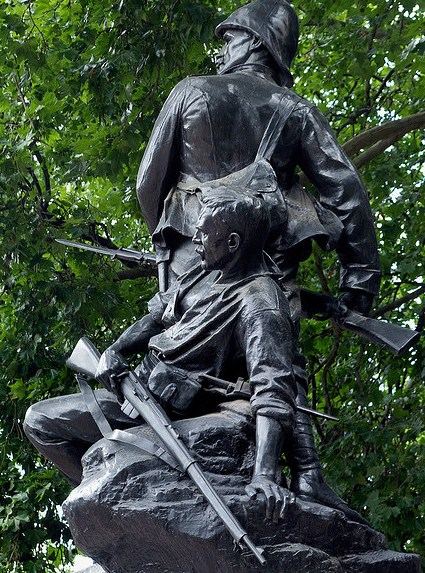 |
|
Royal Marines Graspan Memorial on The
Mall, London
|
Another plaque to Major Plumbe can be found in St Mary Church in Upper
Walmer, Kent, and his name is inscribed on the Royal
Marines Graspan Memorial in the Cambridge enclosure, St. James's Park,
London.
DEATH ON OR
AFTER 1st JANUARY, 1898
BE IT KNOWN that John Hulke Plumbe of
Ladywell Herschell Road Walmer in the County of Kent
died on the 25th Nove
day of November 1899 at Graspan Cape Colony South Africa intestate
AND BE IT FURTHER KNOWN that at the date hereunder written Letters of
Administration of all the Estate which by law devolves to and vests in
personal representative of the said intestate were granted by Her
Majesty's High Court of Justice at the District Probate Registry thereof
to Florence Hulke Plumbe of Ladywell aforesaid the lawful Widow and Relict
of the said intestate.
Resworn July 1902 £1104-19-7
Dated the 20th day of January 1900
Gross value of Estate ... £500.17. 6 .
Net value of Personal Estate
£
Officers who died in the Boer War 1899-1902 extracted
from The "Last Post" being a roll of all officers (Naval, Military or
Colonial) who gave their lives for Their Queen, King and Country, in the
South African War, 1899-1902. p306 (Mildred G. Dooner):
Plumbe. - Major
John Hulke Plumbe, Royal Marine Light Infantry, was killed in action at
Graspan, Nov. 25th, 1899. The third son of the late Dr. S. A. Plumbe, of
Maidenhead, he was born in 1858, and educated at the Oxford Military
College. He entered the Royal Marines in 1877, was promoted capt. 1880,
and major 1885, and is stated to have been a highly qualified officer,
being a specialist in gunnery, fortification, torpedoes, and other
subjects. He served in the Royal Marine Batt. in Egypt in 1882, and was
present at every action in which it was engaged from the occupation of
Alexandria to the actions of Tel-el-Mahuta, Kassassin, Aug. 28th,
Kassassin, Sept. 9th, and Tel-el-Kebir, where he was slightly
wounded in the hand and hip. He received the medal
with
clasp and bronze
star. In the battle of Graspan Major
Plumbe was in command of the Royal Marines belonging to the Naval
Brigade. In this action their losses amounted to forty-three per cent.,
due to the "unflinching and self-sacrificing heroism of the troops that
led the assault." Three officers and 72 men of the Royal Marines were
killed or wounded out of a total of 5 officers and 190 men. In the Naval
Brigade Major Plumbe, Commander Ethelston, Captain Senior, and
Midshipman Huddart were killed, and almost all the petty and
non-commissioned officers were struck down. Just before he was killed
Major Plumbe said, "Rush for the hill, men," and when mortally wounded
his last words were, "Forward! never mind me." A pet dog he took into
action with him watched by his body for six hours, until the arrival of
the ambulance. Major Plumbe was at first buried on the battlefield, but
on the morning of Nov. 26th his body was moved, and he now lies close to
Enslin Station beside Commander Ethelston and Capt. Senior. Their graves
are marked by a large cross. Major Plumbe's servant, Private Doran, died
of his wounds. The names of Major Plumbe and his servant are inscribed
on the monument erected in the Cambridge enclosure, St. James's Park, by
the officers and men of the Royal Marine Artillery and Light Infantry,
in memory of their comrades who fell in South Africa and China.
John was the "Berger Master" of Deal,
Kent. In 1889 we find him playing cricket for Maidenhead (The Slough, Eton and Windsor Observer, 29 June
1889 p4 col 4).
1861: Cookham, Berkshire: John H. Plumbe, son, is aged 2, born in
Maidenhead, Berkshire
1871: Maidenhead,
Berkshire
1881: Vessel "Duncan", Minster In
Sheppey - Sheerness, Kent
1891: Deal, Kent: John H. Plumbe, head, is aged 32, born in Maidenhead,
Berkshire
- England Birth Index
(4Q1848 Cookham vol 2c p335); exact place from 1871 census; exact date
from Navy List January 1883 p77
- Rootsweb
WorldConnect (martingough I235)
- 1871 census
- : Officers who died in the Boer War 1899-1902
extracted from The "Last Post" being a roll of all officers (Naval,
Military or Colonial) who gave their lives for Their Queen, King and
Country, in the South African War, 1899-1902. p306
(Mildred G. Dooner); Diary in possession of Claire Freestone
- England Marriage
Index (4Q1889 Beverley vol 9d p209); exact date and place from London St James Gazette 17 October 1889 p14;
Florence birth from England Birth Index (2Q1860 Beverley vol 9d p104);
1881 census; Florence baptism from England
Births and Christenings batch C10658-1; Florence parents from England Births
and Christenings batch C10658-1 with mother's name from England
Marriage Index (1Q1848 Sculcoates vol 22 p388); Florence death from
England Death Index (1Q1846 Dover vol 2a p2063)
- : Officers who died in the Boer War 1899-1902
extracted from The "Last Post" being a roll of all officers (Naval,
Military or Colonial) who gave their lives for Their Queen, King and
Country, in the South African War, 1899-1902. p306
(Mildred G. Dooner); The Royal Navy: A History from the Earliest Times
to the Present, vol 7 pp345-6; Naval Brigades in the South African War, 1899-1900;
With the Flag to Pretoria
pp150-1; diary in possession of Claire Freestone
- : Administration granted
20 January 1900 (resworn July 1902); With the Flag to Pretoria pp150-1
- Naval Brigades in the South African War, 1899-1900
pp38
John Chapman Plumbe
1867, in Whitechapel
district, Middlesex, England
Henry
Martyn Plumbe
Louisa (Walker) Plumbe
1870 in Tamworth
district, Staffordshire and Warwickshire, England, aged 2
John Cecil Plumbe
known as "Cecil"
1888, in West Green, Edmonton
district, Middlesex, England
Thomas
Plumbe
Susan
(Argent) Plumbe 1920
1901: (named as Cecil) living in Leyton, Essex; Age: 13; Place of Birth:
West Green, Middlesex
- England Birth Index
(1Q1888 vol 3a p328); 1901 census
- Claire Freestone
John Leaker Plumbe
1892, in Ashton Keynes, Wiltshire,
England
John Plumbe
Alice
Jane (Leaker) Plumbe
with the Railways. Retired in
1956.
1961, in Ablington, Bibury, Gloucestershire
1901: Ashton Keynes, Wiltshire Age: 9; Place of Birth: Ashton Keynes,
Wiltshire
The Gloucester records office has
numerous items of miscellania from John's youth such as school report cards
at Cirencester Grammar School (D4128/F11/7) and cricket fixture cards
(D4128/F11/8)
- England Birth Index
(1Q1892 vol 5a p52); exact place from 1901 census
- Claire Freestone
- Claire Freestone; in
Gloucester Records Office (D4128/F9/1), reference is made to an
executor's final account in 1962
Joseph Plumbe
27 June 1800, in Wantage, Berkshire,
England
25 July 1800, in SS Peter &
Paul, Wantage, Berkshire, England
Samuel Plumbe
Molly
(Aldworth) Plumbe
Hannah _____. Hannah was born about
1794, in Wick Rissington, Gloucestershire, England
Landed Proprietor
in Shipton under Wychwood,
Oxfordshire, England, of "softening of the brain"
9 April 1867, in Shipton under
Wychwood, Oxfordshire, England
Said to have gone abroad to South
America, came home married but with no children.
1841: Mill Street, Wantage,
Berkshire
- : IGI Baptism extract
Batch C021982; Keith Hazell
- IGI Baptism extract
Batch C021982; Keith Hazell
- Keith Hazell
- Keith Hazell
- Claire Freestone
- Oxfordshire parish
registers researched by Keith Hazell
- Claire Freestone
Kate Plumbe
31 July 1831
Samuel Plumbe
Emma
(Lloyd) Plumbe
Died young
- Claire Freestone
- Claire Freestone
Kate Plumbe
23 November 1864, in Ashton Keynes,
Wiltshire, England
John Plumbe
Elizabeth
Jane (Richards) Plumbe
1894
1881: Farm House, Bampton,
Oxfordshire
- Claire Freestone; 1881
census
- Records of the Ashton
Fields Farm held in the Gloucestershire Record Office (Reference:
D4128/F2/1)
Kitty Plumbe
7 September 1825
5 October 1825, in St. Pancras,
Middlesex, England
Kitty is recorded as being born on 7 September 1825, the daughter of Samuel
and Emma Plumbe. Samuel is a surgeon of Gt Russell St, Bloomsbury
Samuel Plumbe
Emma
(Lloyd) Plumbe
25 March 1826, in St. John at
Hackney, Middlesex, England
Kitty is recorded as 6 month old, resident at Great Russell Street
Bloomsbury
- Parish registers of St
Pancras, Middlesex (Baptisms 1825 p334 #1176)
- Parish registers of St
Pancras, Middlesex (Baptisms 1825 p334 #1176)
- Parish registers of St
Pancras, Middlesex (Baptisms 1825 p334 #1176)
- Parish registers of St
John Hackney, Middlesex (Burials 1826 p49 #385)
Laura Kate (Plumbe) Mason
21 December 1865, at 37 Lower St,
Deal, Kent, England
Samuel Alderson
Plumbe
Louisa
Burton (Hulke) Plumbe
Charles
Arthur Mason on 15 February 1890, in All Saints, Malabar Hills,
Bombay, India
Charles Arthur Mason is recorded as the son of Francis John Mills Mason.
Laura Kate Plumbe is recorded as the daughter of Samuel Alderson Plumbe.
Colonies And India 5 March 1890 p30
MARRIAGES.
Mason—Plumbe.—Feb. 15, at All
Saints', Malabar Hill, Bombay, by the Rev. A Goldwyer Lewis, Senior
Presidency Chaplain, the Rev. Charles Arthur Mason, M.A., chaplain of
Nowshera, Punjab, youngest son of Major Mason, J. P., The Firs, Warwick,
to Laura Kate, fifth daughter of the late Samuel Alderson Plumbe, M.D., of
Maidenhead.
Laura and Charles were engaged in June 1889.
Laura travelled to the United States with her husband and youngest child,
Ada, then 15, aboard the Columbia
(manifest)
which sailed from Glasgow on 24 November 1919, arriving in New York on 4
December 1919. Laura Kate Mason is recorded as 53 years and 11 months old,
born in Deal, England, last resident in Kingsley, England. She is
described as 5' 4½" tall, of fair complexion, with light brown hair and
blue eyes, with a mark on her chin.
Laura Kate is also recorded entering the United States on 2 January 1930,
aboard the Arcadian (manifest)
which sailed from Hamilton, Bermuda on 31 December 1939. Kate Mason is
recorded as aged 65, born in Deal, England. She is listed as a national of
Canada, living at 11 Admiral Road, Toronto, Ontario, Canada, and is in
transit in New York for three days. Kate is described as 5' 9" tall, of
fair complexion, with brown hair and blue eyes.
3 April 1937, in York, Ontario,
Canada
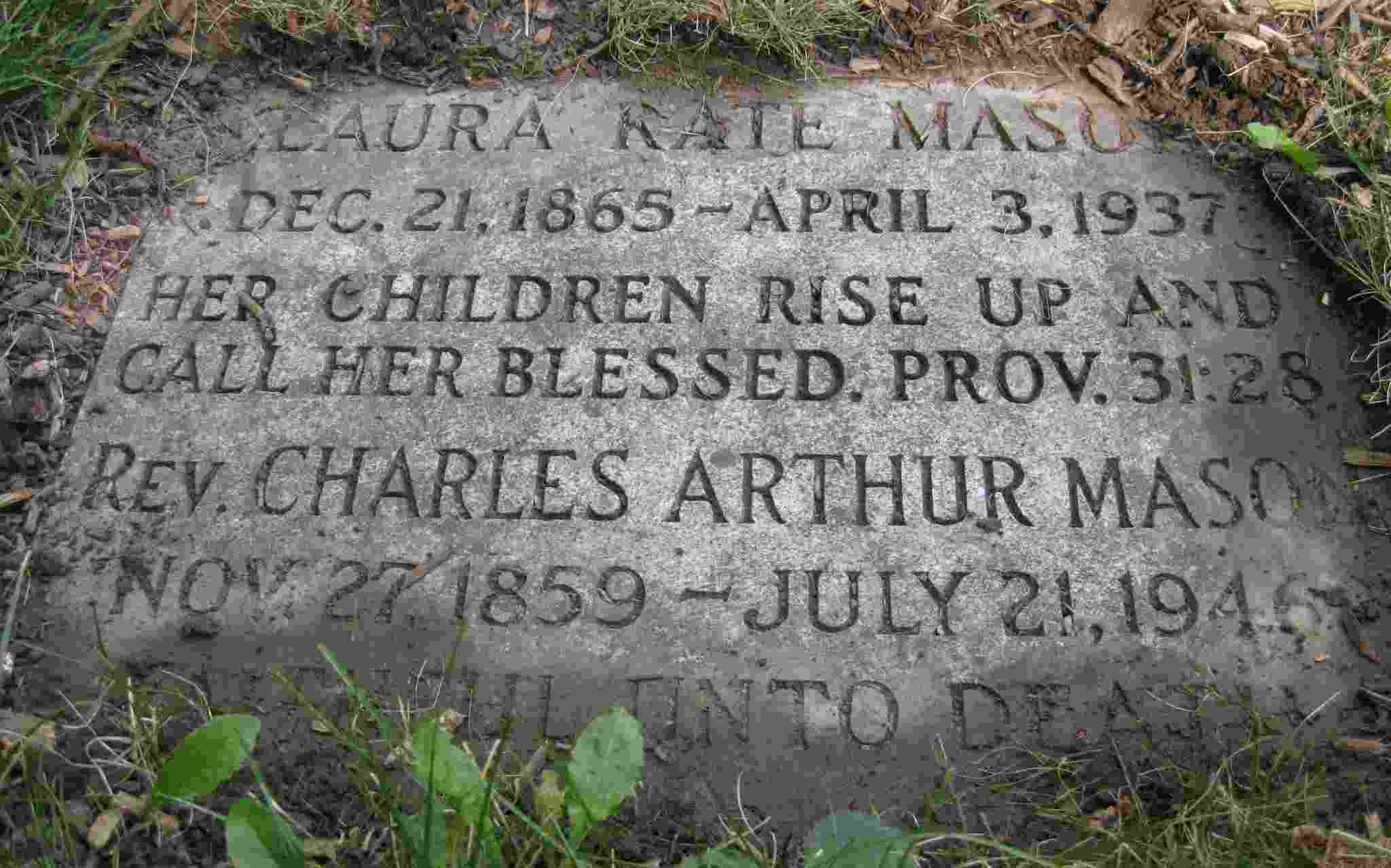 |
|
Gravestone of Laura Kate (Plumbe) Mason
and Charles Arthur Mason in Mount Pleasant cemetery, Toronto,
Ontario, Canada
|
Mount Pleasant cemetery, Toronto,
Ontario, Canada
1871: Maidenhead,
Berkshire
1881: High Street, Cookham,
Berkshire
1901: High
Street, Maidenhead, Berkshire
1911: Otterbourne, Hampshire: Laura Kate Mason, wife, is aged 45, born in
Deal, Kent
1920:
Mitchell Street, Rockledge, Brevard county, Florida
1929: 11 Admiral Road, Toronto, Ontario (manifest
of the Arcadian)
Lillian Mary Plumbe
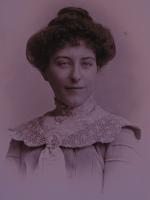 |
|
Lillian Mary Plumbe
photo from David Morris
|
1877, in Henley on Thames,
Oxfordshire, England
31 October 1877, in St. Mary's,
Henley on Thames, Oxfordshire, England
Charles Strange
Plumbe
Frances
Elizabeth (Gosling) Plumbe
Edward
Strange Lang 1928
At the 1881 census, Lillian, aged 3,
is with her grandparents. Her mother had just had another baby.
1881: Market Place, Henley on
Thames, Oxfordshire
- 1881 census
- Henley parish
register, researched by Mike Strange
- David Morris at
www.steelbreeze.net
- Claire Freestone
Louisa Elizabeth (Plumbe) Thomson
11 September 1856 in Maidenhead,
Berkshire, England
Samuel Alderson
Plumbe
Louisa
Burton (Hulke) Plumbe
George
Osmond Lees Thomson on 30 December 1884, in St Luke, Maidenhead,
Berkshire, England
Guardian 31 December 1884 p30
MARRIAGES.
Dec. 30, at St. Luke's, Maidenhead, by the Rev. E. C. Lowe, D.D., Canon of
Ely, and Provost of Denstone, assisted by the Rev. W. G. Sawyer, Vicar,
the REV. GEORGE OSMOND LEES THOMSON, Head Master of the King's College,
Taunton, to LOUISA ELIZABETH, eldest daughter of the late SAMUEL ALDERSON
PLUMBE, M.D., of Maidenhead.
George and Louisa were engaged to be married in August 1884.
known as "Lily"
1900, in Bicester
district, Oxfordshire, England, aged 4416 October 1900, in Merton, Oxfordshire, England
1861: Cookham, Berkshire: Louisa E. Plumbe, daughter, is aged 4, born in
Maidenhead, Berkshire
1871: Maidenhead,
Berkshire
1881: High Street, Cookham,
Berkshire
1891: Kings College, Taunton
St Mary Magdelen, Somerset
- England Birth Index
(4Q1856 Cookham vol 2c p357); exact date from Claire Freestone; exact
place from 1871 census
- 1871 census
- England Marriage
Index (4Q1884 Cookham vol 2c p880); exact date and place from Guardian 31 December 1884 p30;
engagement from Claire Freestone
- England Death Index
(4Q1900 Bicester vol 3a p513)
- Keith Hazell
Louisa Jane (Plumbe) Hobbs
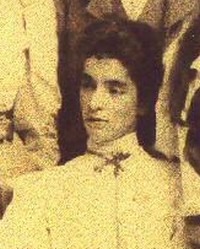 |
|
Louisa Jane (Plumbe) Hobbs c1905
(click for full photo)
photo courtesy of Peter Duffill
|
5 May 1859, in Ashton Keynes,
Wiltshire, England
John Plumbe
Elizabeth
Jane (Richards) Plumbe
Charles
Hobbs
1881: Farm House, Bampton,
Oxfordshire
- England Birth Index
(2Q1859 vol 5a p25); exact date from Claire Freestone; exact place from
1881 census
- 1881 census
Louisa Elizabeth Ann (Plumbe) Chappell
1872, in Whitechapel, Middlesex,
England
Henry
Martyn Plumbe
Louisa (Walker) Plumbe
William Henry Chappell on 14 May
1902, in Addiscombe, Surrey, England. William Henry Chappell is recorded as
aged 30, single, the son of John Chappell. Louisa Elizabeth Ann Plumbe is
recorded as aged 29, single, the daughter of Henry Martyn Plumbe.
William was born in 1872 in Croydon, Surrey, and baptised on 29 September
1872, in Croydon, the son of John Chappell and Abigail Drake Chappell. He
was a veterinary surgeon, and a Member of the Royal College of Veterinary
Surgeons. William died on 1 February 1927 in Kings
Lynn
district, Norfolk, aged 54. He died intestate and his estate letters
of administration were granted on 1 March 1927 to Fanny Abigail Fulcher and
Louisa Wicks.
Kelly's Directory of Norfolk,
1912 p248
NORFOLK KING'S LYNN
Chapell Wm. Henry, veterinary surgeon, 8 Railway rd
Census & Addresses:
1881:
34
Surrey Street, Croydon, Surrey
1901: Croydon, Surrey: William H. Chappell is aged 28, born in Croydon,
Surrey. He is a Veterinary Surgeon
1911: King's Lynn district, Norfolk: William H. Chappell is aged 39
1927: Seafordhaven, Avenue Road, King's Lynn, Norfolk (London Gazette 11 March 1927 p1659)
1926 in Kings
Lynn
district, Norfolk, England, aged 54
1881:
11
Tilson Road, Tottenham, Middlesex
1901: Croydon, Surrey: Lucy E. A. Plumbe is aged 29, born in London St Marks
E, Whitechapel
1911: King's Lynn district, Norfolk: Louisia Elizabeth Ann Chappell is aged
40
1912: 8 Railway Road, King's Lynn, Norfolk (may be business address) (Kelly's
Directory of Norfolk, 1912 p248)
Mabel Gertrude (Plumbe) Tillett
1869, in St Pancras, Middlesex,
England
Rowland Plumbe
Fanny Payne (Russell) Plumbe
Pedro
Juan Tillett on 22 July 1896 in St Andrew, Wells Street, St.
Marylebone, London, England
Musical Courier 6 August 1896 p12
A
Brilliant Wedding.
THE genial and
highly-esteemed Mr. Pedro J. Tillett, a partner with Mr. N. Vert in the
well-known Cork Street firm, must be a happy man. Not only has he won
the affections of a beautiful and accomplished young lady, Miss Mabel
Gertrude Plumbe, but the large number of people who gathered at the
wedding to bid the young couple God-speed was certainly representative,
and showed how many friends Mr. Tillett has already made. Nor did these
friends come empty-handed. They brought upwards of 200 gifts, embracing
such a wide variety of useful and ornamental presents that these young
people will have plenty of souvenirs of this happy occasion through
life.
We are unable for want of space to give a complete, list of the
presents, but take pleasure in recording here a few of the names of the
donors. The marriage ceremony took place at St. Andrew's, Wells Street,
on July 22nd, at 2 o'clock. The service was fully choral, and very
impressive. Afterwards a reception was held at Queen's (small) Hall,
when several hundred people proffered their congratulations and best
wishes.
Most of the presents were arranged on the stage of the hall in
such a manner as to make an effective display. We noticed a complete set
of table-glass and decanters by Mr. and Mrs. Edward Lloyd; a case of
silver spoons and sugar-tongs by Mr. and Mrs. Watkin Mills; a brass lamp
and shade by Mr. and Mrs. Bantock Pierpoint; an inlaid writing-table by
Miss Ella Russell; a corner cabinet and Japanese cabinet by Mr. N. Vert;
an ivory silver mounted paper knife by Mr. C. A. E. Harris, of Montreal;
dining-room and bedroom suites by Mr. Rowland Plumbe, father of the
bride; a full service of cutlery by Mrs. Plumbe; inlaid table by Sir
John and Lady Hutton; silver muffineer by Mr. Frank Dicksee, R.A.; two
cloisonné vases by Mr. T. H. Watson, F.R.I.B.A.; bas relief by Mr.
Frampton, A.R.A.; silver dessert spoons by Mr. W. Cutler, F.R.I.B.A.;
plated fruit dish by Dr. Percy Down; case of silver spoons by Professor
and Mrs. Bannister Fletcher; a pair of silver vases by Mr. and Mrs. J.
Hunter Donaldson; a Satsuma vase by Dr. and Mrs. Gwynn; photo screen by
Dr. Gollum; oak salad bowl, various dishes, and a chair by Miss Russell;
piece of old china by Professor and Mrs. A. H. Church; pair of brass
candlesticks and afternoon tea stand by Mrs. Tillett; wrought iron and
copper flower stand by Mr. J. H. Tillett; Limoges china tea service and
picnic tea basket by Mr. R. Leigh Ibbs.
Among other musicians who contributed to the handsome array of
presents were :—
Mr. and Mrs. Franklin Clive, Mr. and Mrs. W. S. Hoyte, Mr. G. B.
J. Aitken, Mr. Charles Copland, Miss Louise Nanney, Mr. Arthur Barlow,
Mr. and Mrs. W. Kuhe, Mr. Dan Price, Miss Meredyth Elliott, Mr. and Mrs.
Archibald Ramsden, Mr. and Mrs. Maybrick, Mr. and Mrs. Douglas Powell,
Mr. and Mrs. Rose (Mme. Clara Samuell), Mr. George Bell, Mr. George
Holmes, Meister Glee Singers, Miss Carlotta Desvignes, Miss Florence
Hoskins, Mr. F. Lewis Thomas, Mr. and Mrs. Basil Tree, Mr. and Mrs.
Ambrose Austin, Mr. and Mrs. Norman Salmond, Mr. Turner Lloyd, Miss
Greta Williams, Mr. Ernest Meads, Mr. and Mrs. Fred Walker, The Misses
Conway, Mr. George Clutsam, Mons. Jonannes Wolff, Miss Macintyre, Miss
Hilda Wilson, Messrs. Réne and F. Payne, Mr. and Mrs. Fischel (Mme.
Zippora Monteith), Mr. Kennerley Rumford, Miss Mabel Berrey, Mr. Braxton
Smith, Mr. Douglas Beaufort, Mr. J. Berren (manager, Pleyel Wolff's),
Queen's Hall staff, Mr. Barton McGuckin, Mme. Belle Cole, Mme. Alice
Gomez, Mr. John Gill, and Mons. Joseph Hollman.
Mr. and Mrs. Tillett have gone to Cornwall to spend their
honeymoon, and will return about the first of September.
1941, in Willesden
district, Middlesex, England, aged 71
Highgate cemetery, London, England.
Mabel is buried in the same grave as her father and grandmother.
1881:
13
Fitzroy Square, St. Pancras, London
1891: 13 Fitzroy Square, St.
Pancras, London
1901: Hampstead, London: Mabel G. Tillett is aged 31, born in London St
Pancras.
1911: Willesden, Middlesex: Mabel Gertrude Tillett is aged 71 (! - must be a
typo for 41)
1918: 62 Cranhurst Road, Willesden Green, London (Commonwealth
War
Graves Commission)
- England Birth Index
(4Q1869 Pancras vol 1b p41); exact place from 1901 census
- England Marriage Index
(3Q1896 Marylebone vol 1a p1229); exact date and place from Musical Courier 6 August 1896 p12
- England Death Index
(1Q1941 Willesden vol 3a p855)
- Gravestone photo at flickr.com
(claireyfairy)
Margaret (Plumbe) Thomson
29 December 1826, in London,
Middlesex, England
29 January 1827, in Old Church, St.
Pancras, London, England
Samuel Plumbe
Emma
(Lloyd) Plumbe
John
Buck Thomson on 11 December 1851, in St Georges, Ramsgate, Kent,
England
Margaret received a legacy of £250 from her uncle, Robert Plumbe, in January
1874.
1874, in Thanet
district, Kent, England
1871:
Ramsgate, Kent
- 1871
census; exact date from IGI Batch C047932; Keith Hazell
- IGI Batch C047932
- England Marriage Index
(4Q1851 Thanet vol 5 p738); exact date and place from information
provided by Paddy Neville with kind permission of Keith Eve
- England Death Index
(3Q1874 vol 2a p466)
- Claire Freestone
Margaret Shepherd (Plumbe) Waddy
1864, in Winchcombe,
Gloucestershire, England
Henry Plumbe
Caroline (Straford) Plumbe
Edward
Waddy in 1888, in Cheltenham
district, Gloucestershire, England
1918, in Aston
district, Warwickshire, England, aged 54
1871:
Terrace, Winchcombe, Gloucestershire
1881:
4
Bassett Road, London, Middlesex
1901: Bournemouth, Winchester: Margaret Waddy is aged 37, born in
Winchester, Gloucestershire; Occupation: Lady Matron
- England Birth Index
(1Q1864 Winchcomb vol 6a p396); exact place from 1871 census
- England Marriage Index
(3Q1888 Cheltenham vol 6a p707)
- England Death Index
(1Q1918 Aston vol 6d p429)
Marian Charlotte Plumbe
17 March 1851, in Henley,
Oxfordshire, England
28 May 1851, in St. Mary's, Henley
on Thames, Oxfordshire, England
William Plumbe
Ann
Richardby (Strange) Plumbe
28 August 1920, in St. Mary's,
Henley on Thames, Oxfordshire, England
1881: Market Place, Henley on
Thames, Oxfordshire
1891:
Robinson Road, Mitcham, Surrey: Marion C Plumbe, sister-in-law, is
aged 40, born in Oxfordshire. She is living on her own means.
- Date from David Morris;
place from 1881 census
- Oxfordshire parish
registers researched by Keith Hazell
- Oxfordshire parish
registers researched by Keith Hazell
Martha Plumbe
9 April 1810, in Wantage, Berkshire
(now Oxfordshire), England
4 May 1810, in SS Peter & Paul,
Wantage, Berkshire (now Oxfordshire), England
Samuel Plumbe
Molly
(Aldworth) Plumbe
8 August 1887, in Wantage, Berkshire
(now Oxfordshire), England
1841: Mill Street, Wantage,
Berkshire
1851: Mill Street, Wantage, Berkshire
1881: Mill Street, Wantage,
Berkshire
- : IGI Batch C021982;
Oxfordshire parish registers researched by Keith Hazell; 1851 census
- IGI Batch C021982;
Oxfordshire parish registers researched by Keith Hazell
- Claire Freestone
Martha Plumbe
Samuel Plumbe
Caroline
(Payne) Plumbe
From clues in Rolls Plumbe we
conclude that Martha died young. It is noted on p47 that two siblings of
Samuel Rolls', born after him, had died young (and before his death in
1832). Since Philip and Annie are alive at Rolls' death, the conclusion is
that Harold and Martha were the ones who died young.
- David Morris at www.steelbreeze.net
Mary (Plumbe) Aldworth
26 October 1798, in Wantage,
Berkshire, England
28 November 1798, in SS Peter &
Paul, Wantage, Berkshire, England
Samuel Plumbe
Molly
(Aldworth) Plumbe
Joseph
Aldworth on 4 August 1823, in Wantage, Berkshire (now Oxfordshire),
England
School Mistress
1851: Lock House, Latton, Wiltshire
1881: Mill Street, Wantage,
Berkshire
- IGI Batch C021982;
Oxfordshire parish registers researched by Keith Hazell; aged 52 in 1851
census gives 1798 or 1799, and must be prior to the baptism.
- IGI Batch C021982;
Oxfordshire parish registers researched by Keith Hazell
- IGI Batch M021983
- 1851 Census
Mary (Plumbe) Payne
21 July 1800, in Henley on Thames,
Oxfordshire, England
20 August 1800, in St. Mary's,
Henley on Thames, Oxfordshire, England
John Plumbe
Sarah
(Simmons) Plumbe
Samuel
Payne on 8 October 1831, in St. Mary's, Henley on Thames, Oxfordshire,
England. The marriage was witnessed by John Simmons Plumbe, Mary's elder
brother.
1881: 1 Premier Place, Exeter,
Devon
- Oxfordshire parish
registers researched by Keith Hazell
- Oxfordshire parish
registers researched by Keith Hazell
- Henley marriage
registers researched by Mike Strange
- David Morris at
www.steelbreeze.net (Sarah C. from 1881 census)
Mary Plumbe
11 December 1827, in Henley on
Thames, Oxfordshire, England
9 January 1828, in St. Mary's,
Henley on Thames, Oxfordshire, England
William Plumbe
Anne
(Outhwaite) Plumbe
20 December 1833, in St. Mary's,
Henley on Thames, Oxfordshire, England, aged 6
- Oxfordshire parish
registers researched by Keith Hazell
- Oxfordshire parish
registers researched by Keith Hazell
- Oxfordshire parish
registers researched by Keith Hazell
Matilda (_____) Plumbe
1801/2, in Wantage, Berkshire (now
Oxfordshire), England
John Plumbe
1851: Mill Street, Wantage, Berkshire
Murray Kinnock Plumbe
1837
Samuel Plumbe
Elizabeth
(Perkins) Plumbe
1837
Died 7 weeks
- Keith Hazell
- Keith Hazell
- Claire Freestone
Nina Fanny Elizabeth (Plumbe) Ross
1890, in West Green, Edmonton
district, Middlesex, England
Thomas
Plumbe
Susan
(Argent) Plumbe Alfred Ross1925
1901: living in Leyton, Essex; Age: 10; Place of Birth: West Green,
Middlesex
- England Birth Index
(3Q1890 vol 3a p317); 1901 census
- Claire Freestone
- Claire Freestone
Nora Beatrice (Plumbe, Dicksee) Butler
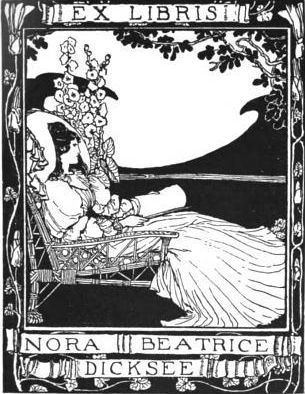 |
|
Bookplate of Nora Beatrice (Plumbe)
Dicksee by R. Anning Bell
|
1873, in Pancras
district, Middlesex, England
Rowland Plumbe
Fanny Payne (Russell) Plumbe
Lawrence
Robert Dicksee in 1894, in Marylebone
district, London, England
Leonard Butler in 1934, in Kensington
district, London, England
1881:
13
Fitzroy Square, St. Pancras, London
1891: 13 Fitzroy Square, St.
Pancras, London
1901: Hampstead, London: Norah B. Dickson is aged 28, born in London
1911: Hampstead, London: Nora Beatrice Dicksee is aged 38
1916: 153 Haverstock Hill, London (Commonwealth
War Graves Commission)
- England Birth Index
(1Q1873 Pancras vol 1b p34)
- 1881 census
- England
Marriage Index (3Q1894 Marylebone vol 1a p1236)
- England Marriage
Index (2Q1934 Kensington vol 1a p321)
Percival Charles Plumbe
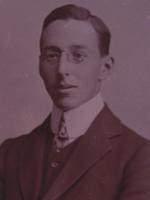 |
|
Percival Charles Plumbe
photo from David Morris
|
1881, in Henley on Thames,
Oxfordshire, England
11 July 1881, in St Mary's, Henley
on Thames, Oxfordshire, England
Charles Strange
Plumbe
Frances
Elizabeth (Gosling) Plumbe
Missionary.
Percival was initially apprenticed to Debenham and Freebody, in London.
While there he took up religious work in his spare time amongst the poor in
London's East End. He later became a full time missionary with the Chinese
Inland Mission and, when based there was "three months bullock-cart ride
from Peking".
1910, in Henley district,
Oxfordshire, England, aged 28
24 January 1910, in St Mary's,
Henley on Thames, Oxfordshire, England
1881: Market Place, Henley on
Thames, Oxfordshire (in the 1881 census, Percival is the unnamed
infant, aged 1 month)
- 1881 census
- Henley parish
register, researched by Mike Strange
- Claire Freestone.
David Morris at www.steelbreeze.net
- England Death Index
(1Q1910 vol 3a p527)
Philip Algernon Plumbe
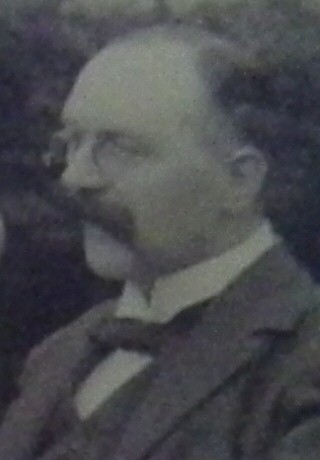 |
|
Philip Algernon Plumbe
circa 1915
(click for full photo)
photo from Alison Wreyford
|
24 February 1863 in Maidenhead,
Berkshire, England
Samuel Alderson
Plumbe
Louisa
Burton (Hulke) Plumbe
Attended school at
Hurstpierpoint, Sussex (1877). Philip's brother-in-law, and uncle of his
future wife, Rev. George Thomson, was Second Master at the school at the
time.
Ethel
Mary Thomson on 4 November 1903 in St Peters, Southsea, Hampshire,
England
The reception appears to have been held back at Ethel's then home, being 84
St Andrew's Road, Southsea.
Ethel was the step-daughter of Philip's younger sister, Caroline Ada Plumbe,
who married Henry John Phipps Thomson after the death of Ethel's mother,
Sarah Wagstaff.
- John Philip Hubert Plumbe (1904 - ? )
- Marjorie Gwendoline Plumbe (1905 - ? )
- Brian Henry Plumbe (1907 - 1967)
- Alison Elizabeth Plumbe (1910 - ? )
- Katharine Margaret Plumbe (1911 - ? )
Bank Clerk; Philip worked solely
for the Bank of England: he was elected as unattached Clerk aged 18 on 5 May
1881. Gradual progression through the ranks, to final high office by
1911 as Principal of the Power of Attorney office. He was pensioned 23
February 1928 aged 65.
29 September 1929, at 54 Dorset Road,
Bexhill-on-Sea, Sussex, England, of heart trouble
Oxhey, Hertfordshire, England
1871: Maidenhead,
Berkshire
1881: High Street, Cookham,
Berkshire
1891: Northumberland House, New Kings road, Fulham, London. Philip is
renting one furnished room on the third floor, paying 10 shillings per week.
(London
Electoral Registers, 1891)
1891: "The Firs", Harefield,
Uxbridge, Middlesex
1896: 10 Napier Avenue, Hurlingham, London. Philip is renting two furnished
rooms on the first floor, paying £1 per week. (London
Electoral Registers, 1896)
1901: 8 Napier Avenue, Hurlingham, London (Rootsweb
WorldConnect (martingough I455) citing a letter dated 14 March 1901)
1901: Merton,
Oxfordshire [Philip was staying with George Osmond Lees Thomson, the
widower of Philip's elder sister, Louisa who had died the previous autumn.
Also staying there at this time was Ethel Mary Thomson, George's niece, whom
Philip would marry two years later.]
1903: "Trehearne" Chalk Hill, London Road, Oxhey (Rootsweb
WorldConnect (martingough I455)
1911: Watford Urban, Hertfordshire: Philip Algernon Plumbe is aged 48, born
in Maidenhead, Berkshire
Robert Plumbe
Dr. 19 November 1803, in Wantage, Berkshire, England
27 December 1803, in SS Peter &
Paul, Wantage, Berkshire, England. The IGI has the baptism date as 16
December 1803.
Samuel Plumbe
Molly
(Aldworth) Plumbe
Louisa
Mary Davies
Surgeon. Robert was admitted
M.R.C.S. in 1825, and served initially in the Indian Army. He was surgeon on
the 'Countess of Harcourt' 1825-26, surgeon mate on the 'Bombay' from
1827-28 and surgeon on the 'Moira' from 1828-29. After this he joined the
East India Company, and was selected by the EIC Board of Examiners for
Madras in 1829. He was appointed Assistant Surgeon on 10 October 1829 and
Surgeon on 31 January 1846. Robert retired on 30 September 1849.
19 December 1873, in Kensington
district, London, England, aged 70. Living at the last at 11 Leonard
Place, St Mary Abbotts, Kensington.
Dr Robert's sisters Mary Aldworth, Widow, and spinster Martha Plumbe, (both
stated to be of Wantage) were provided annuities, together with his nieces
Mary and Ann Aldworth (Mary's daughters). He settled £1142-17-2d in July
1873 on brothers Dr Samuel A. Plumbe and Col. Thomas Plumbe of Bath, to give
a 3.5% annuity to the above poorer relatives.
Robert's will was proved on 16 Jan 1874, principally in favour of his
widow, with £200-250-300 legacies to his nephews Dr Samuel A. Plumbe,
Henry Plumbe (solicitor), and his nieces Grace, and Margaret (Thomson).
Rosa Louisa (Plumbe) Chalmers
29 July 1856, in Henley on Thames,
Oxfordshire, England
22 October 1856, in St. Mary's,
Henley on Thames, Oxfordshire, England
William Plumbe
Ann
Richardby (Strange) Plumbe
John
Chalmers on 6 September 1887, in St. Mary's, Henley on Thames,
Oxfordshire, England
The baptism and marriage records show
Rosa Louisa. The 1881 census has Rose L., and the 1901 census has simply
Rose, indicating that she probably used Rose rather than Rosa.
1936
1881: Market Place, Henley on
Thames, Oxfordshire
1901: living in Newport, Shropshire; Age 40, born in Henly on Thames, Oxon
- Date from David Morris
at www.steelbreeze.net; place from 1881 census
- Henley baptism
registers researched by Mike Strange
- England Marriage
Index (3Q1887 vol 3a p1043); exact date from Keith Hazell
- Keith Hazell
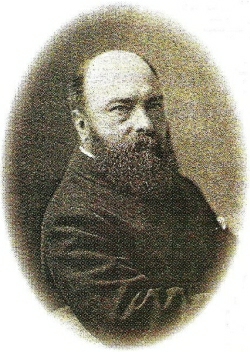 |
|
Rowland Plumbe (1890)
photo from Building
News 6 June 1890 p798
|
Rowland Plumbe
2 February 1838, in Whitechapel
district, Middlesex, England
Samuel Plumbe
Ann
Serena (Payne) Plumbe
Fanny Payne Russell on 14 May
1867, in St Nicholas, Brighton, Sussex, England. Rowland Plumbe is recorded
as aged 29, the son of Samuel Plumbe. Fanny Payne Russell is recorded as
aged 38, the daughter of William Russell.
Fanny was born on 29 March 1829, in Brighton, Sussex, the daughter of
William Russell. She died on 13 January 1910, at 29 Brondesbury Park Road,
Willesden, Middlesex, aged 80. She is buried in Highgate cemetery, London.
Census:
1901: Saint Pancras, London: Fanny P. Plumbe is aged 62, born in Brighton,
Sussex
Architect.
Rowland was elected an Associate of the Royal Institute of British
Architects (A.R.I.B.A.) on 1 December 1862 and elected a Fellow (F.R.I.B.A.)
on 19 April 1869. He was President of the Architectural Association, an
architecture school, from 1871-2.
Rowland designed many public buildings, churches, hospitals and housing
estates in and around London. Prominent buildings designed by Rowland Plumbe
include the Woodford Congregational Church in Essex, built in 1874 and the Noel Park housing estate
of 2200 properties for which he was the Consulting Architect in 1881. Plumbe
designed Woodlands
Park
House in 1885 for which:
Plumbe was commissioned 'with a free
hand, unfettered in the slightest degree by economical considerations' to
design a mansion in the Gothic Style. The most modern innovations were
incorporated and Woodlands Park became one of the first country houses
with electric light, renowned for the grandeur of its oak panelled Grand
Hall.
Rowland Plumbe was Consulting Architect for the rebuilding of London
Hospital in 1897 and designed the Middlesex
County Asylum in 1900 as well as the Y.M.C.A. building on Tottenham
Court Road (1911) which was described in The New international year book 1912 p67 as
the largest and most complete structure of its
kind in the kingdom, constructed largely of concrete and steel, and
comprising a college, clubrooms, and lodgings for 1000 men, besides the
usual association meeting and reception-rooms. The cost was $1,000,000.
Directory of British Architects 1834-1914 p383
Plumbe, Rowland, 1838-1919
Date of Birth: 2 Feb 1838
Date of Death: 2 Apr 1919
Place of
Death: Ashleigh, 29 Brondesbury Park, London NW
Address:
5 Highbury Park South, London, England (1862)
13 Fitzroy Square, London W (1869, 1914)
34 Bloomsbury Square, London
Education
and training:
Articled to Nockalls Johnson Cottingham
(1823-1854) and Frederick Peck (1827 or 8-1875). University College,
London. In America 1858-60 in office of Frederick Clark Withers
(1828-1901)
Professional
qualifications:
ARIBA 1 Dec 1862: proposed by T L Donaldson, R Kerr, J Edmeston; FRIBA 19
April 1869: proposed by J P Seddon, J Edmeston, R W Edis.
Professional
and
practice information:
Commenced independent practice in the City of
London 1860.
District Surveyor of South Islington from 1875, and of West Hamstead until
1891. Partner of Frank Morrish Harvey 1903-8, and of Charles Lionel
Fleming-Williams (d. 1919) and John Charles Stephen Mummery (1862-1949)
from 1913.
Works:
No list on RIBA Nomination papers
See RIBA Journal obit
Other
information:
President AA 1871-2. Past Master of the Painter-Stainers' Company. FSI.
Obituaries:
Builder v116, 11,18 Apr 1919, p358,381
RIBA Journal v26, 1919, p140-1
References:
General sources:
Avery obit
Builder illustrations index
Dixon & Muthesius
Graves
Pike London
RIBA Drawings Catalogue
Thieme-Becker
Ware
Who's who in architecture (1914)
Articles:
Building News v58, 6 June 1890, p793
Builders' Jnl 20 May 1896, p227
Location
of unpublished material:
BAL Drawings Collection
Portraits:
Building News v58, 6 June 1890, p798
Pike London, p276
RIBA Nomination Papers A v3 p151
F v4 p71
RIBA
Nomination Papers fiche reference: 6/E1, 82/D4
BAL
Biography File
The Flooring of Sanitoria by Rowland
Plumbe F.R.I.B.A., Consulting Architect to the London Hospital, in The British journal of tuberculosis January 1907
p314
Rowland visited the United States for two years from 1858 to 1860, where he
worked in office of Frederick Clark Withers. Rowland arrived in New
York in May 1858, aboard the City
of Baltimore from Liverpool (New York Times 13 May 1858).
Rowland was commissioned as a Lieutenant in the 38th Middlesex Rifle
Volunteer Corps on 14 June 1871 (London Gazette 30 June 1871 p3006) and
resigned that commission on 21 October 1874 (London Gazette 20 October 1874 p4792)
2 April 1919 at Ashleigh, 29
Brondesbury Park, Willesden, Middlesex, England, aged 81
Highgate cemetery, London, England.
Rowland is buried in the same grave as his mother and eldest daughter.
1862: 5 Highbury Park South, London (Directory of British Architects 1834-1914 p383)
1868-1909: 13 Fitzroy Square, London ('Fitzroy
Square',
Survey of London: volume 21: The parish of St Pancras part 3: Tottenham
Court Road & neighbourhood (1949), pp. 52-63)
1881:
13
Fitzroy Square, St. Pancras, London
1891: 13 Fitzroy Square, St.
Pancras, London
1901: Saint Pancras, London: Rowland Plumbe is aged 63, born in London
1911: Willesden, Middlesex: Rowland Plumbe is aged 73
Rowland Richards Plumbe
1886, in West Green, Edmonton
district, Middlesex, England
Thomas
Plumbe
Susan
(Argent) Plumbe Drapers Warehouseman
1901: (named as Roland) living in Leyton, Essex; Age: 14; Occupation:
Drapers Warehouseman; Place of Birth: West Green, Middlesex
- England Birth Index
(3Q1886 vol 3a p301); 1901 census
- 1901 census
Samuel Plumbe
29 November 1764
14 December 1764, in SS Peter &
Paul, Wantage, Berkshire, England
Samuel
Plumb
Mary
(Goff) Plumb
Molly
Aldworth on 19 November 1794, in SS Peter & Paul, Wantage,
Berkshire, England.
Wool Merchant and Clothier
16 January 1852, in Wantage,
Berkshire, England Wantage churchyard
dated 28 November 1848. Proved 11 May
1852 Court of Archdeacon of Berkshire
Samuel Plumbe was a wool merchant and
clothier of Mill Street, Wantage. He owned cloth mills and held contracts
for the supply of cloth for army greatcoats.
1841: Mill Street, Wantage,
Berkshire
1851: Mill Street, Wantage, Berkshire
Samuel Plumbe
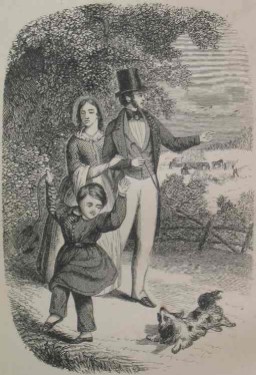 |
This
illustration in Rolls
Plumbe does not explicitly state that it is of the
Plumbe family (Samuel as the father) but it seems likely to be
from the context, and if not is at least indicative of the era. |
25 March 1794, in Henley on Thames,
Oxfordshire, England
23 April 1794, in St. Mary's,
Henley on Thames, Oxfordshire, England
John Plumbe
Sarah
(Simmons) Plumbe
Caroline
Payne on 20 May 1818 in St. Botolph Without Aldersgate, London,
England
Ann
Serena Payne on 23 June 1834 in St. Dunstan, Stepney, London, England.
Marriage to the sister of a deceased wife was prohibited
by the Marriage Act in 1835, although marriages that had already taken
place (such as that of Samuel and Ann Serena) were explicitly authorised.
The prohibition was lifted in 1907.
Arrowroot merchant.
Samuel founded and operated the "South Sea Arrowroot Company", an importing
business
Caroline Payne and Ann Serena Payne
were sisters. Samuel Plumbe first married Caroline, and went to live in
Tiverton, Devon, in about 1827. They had "a pretty cottage out of the town,
that they might fully enjoy the country" (Rolls
Plumbe p13). Caroline became ill and her sister Ann Serena
Payne went to Tiverton and stayed with them, apparently to look after the
children during her sister's illness. In November 1831 the family moved back
to London, where first Samuel Rolls, and then Caroline died.
Samuel joined the church of Dr. Andrew Reed, and became a close associate of
the minister.
Memoirs of the life and philanthropic labours of
Andrew Reed, D. D. pp293-4 (ed. Andrew Reed, 1863):
This help came in the form he most desired it, and in the accession to the
church of an eminently godly man, Mr. Samuel Plumbe. This gentleman came
from Tiverton to reside in London, and he at once took a prominent
position in Dr. Reed's church. He possessed a cultivated mind, an amiable
character, and ready gifts for Christian usefulness. He was a favourite
alike with young and old, rich and poor. He had singular quickness and
activity of body and of mind. He was in truth a most ready man. He could
deliver a good religious address, prepare a scientific lecture, write a
capital letter, compose an anniversary hymn, utter a good impromptu
speech, visit acceptably the sick and dying, converse well with religious
inquirers, bring harmony in place of strife by his tact and love, and fill
with cheerfulness the dullest and most timid society. Such qualities,
crowned with sterling and devout piety, were a rare treasure to both
pastor and church. With all these gifts to win the people, he was no rival
to the minister, was never spoilt, but always to be trusted. This new
association afforded Dr. Reed unspeakable relief and invaluable help.
15 February 1840, in Whitechapel
district, Middlesex, England, of paralysis.
Samuel suffered a long illness before his death. In the spring of 1839, Dr.
Reed visited "his friend and deacon, Mr. Plumbe, who was lying ill at
Aylesbury" (Memoirs p313). On 14 February 1840, Dr.
Reed wrote in his journal (Memoirs p315):
"Dear Samuel Plumbe is taken from us. I must not trust myself to
add another word at present: 'Aaron held his peace.' How I shall fulfil
the last duties to his memory, I know not. My prayer is, that it may be
for the glory of God."
and again on 3 March 1840, Dr. Reed writes (Memoirs p316):
"Dear Plumbe is gone! He endured great suffering for eight months.
All that time I have felt bereaved; but the issue is a grievous stroke. We
interred his remains on Friday. I improved the occasion on Sabbath
evening. The chapel was crowded to the ceiling. My subject was, 'Weep not
for me, but for yourselves.' We held a prayer-meeting afterwards, at which
full two thousand persons remained. I have been much affected and humbled,
in going over his papers, to discover the strength of his attachment to
me."
28 February 1840
1832: Richard Street, in St. George's in the East, London (Bunhill
Fields Burial Index entry for Samuel Rolls Plumbe)
Samuel Plumbe
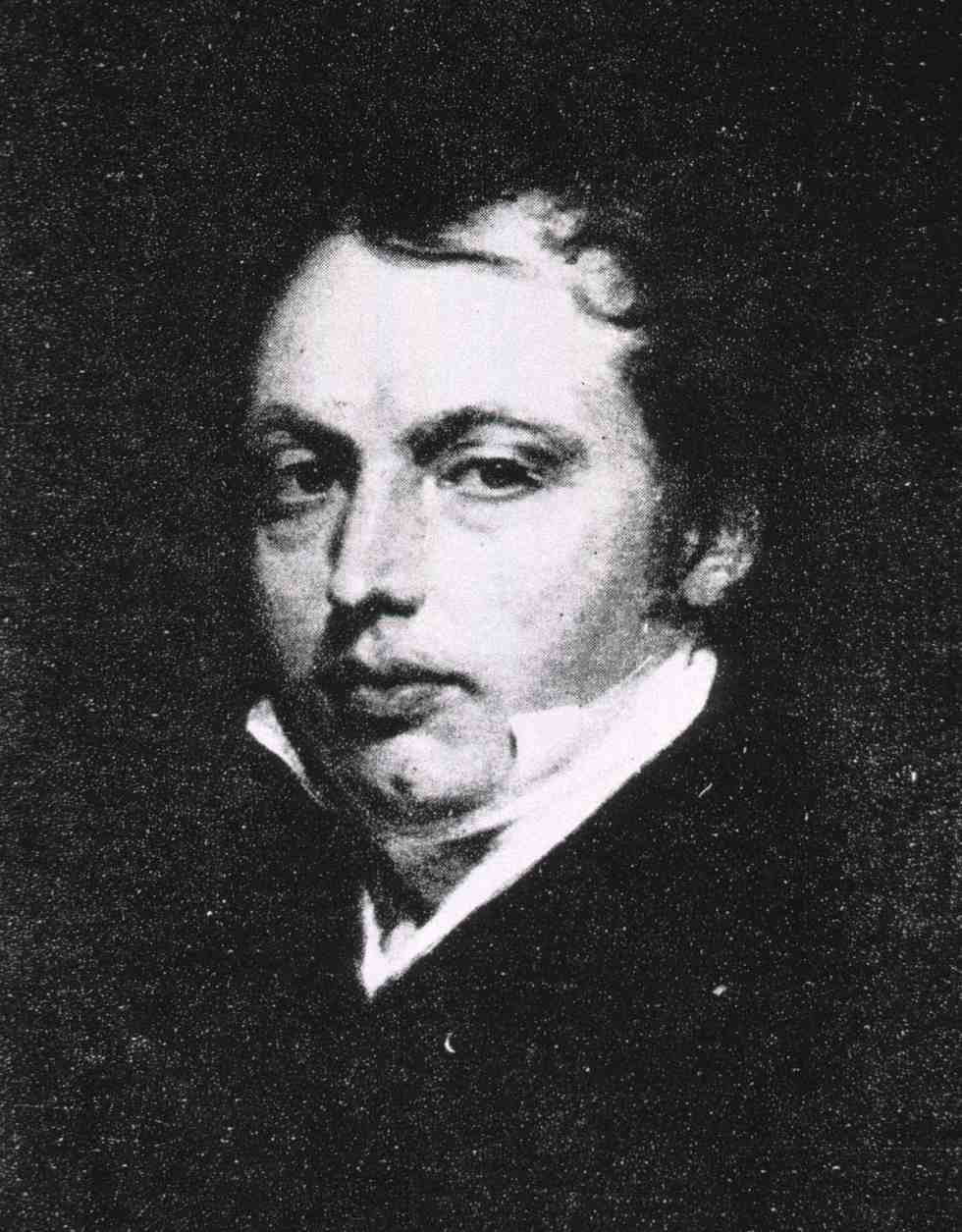 |
|
Samuel Plumbe circa 1830
|
8 October 1795
4 November 1795, SS Peter and St.
Paul, Wantage, Berkshire, England
Samuel Plumbe
Molly
(Aldworth) Plumbe
Anne
Clarissa Perkins on 18 Jan 1820 in St. Martin in the Fields,
Middlesex, England
Samuel Plumbe is recorded as a bachelor, resident in St Martin in the
Fields. Anne Perkins is recorded as a spinster, resident in Chertsey,
Surrey. The marriage, by license, was witnessed by James ???, Eliza Watten
and Mary Watten.
Emma
Lloyd on 26 January 1824 in Old Church, St Pancras, London, England
Samuel Plumbe is recorded as a widower, of the parish of St George
Bloomsbury, Middlesex. Emma Lloyd is recorded as a spinster, of St Pancras.
The marriage, by license, was officiated by Henry Shepherd, minister, and
witnessed by Philip Charretie and ??? Perkins.
The New Monthly Magazine 1 April 1824 p183
Marriages.—
At St. Pancras, S. Plumbe, esq. of Russell-street, to Miss Emma Lloyd.
Elizabeth
Perkins on 31 December 1832, in Broadwater by Worthing, Sussex,
England
Surgeon and Dermatologist.
Samuel was one of the first physicians to make a clear description of the
skin disease psoriasis. This
disease, at one time known as Willan-Plumbe syndrome, was first described by
Willan in 1808, and then by Samuel Plumbe in his book A
Practical Treatise on Diseases of the Skin, published in London by
Underwood in 1824. Samuel was the senior surgeon at the Royal Metropolitan
Infirmary for Children.
In 1814 Samuel entered St. Thomas's Hospital, apprenticed to Mr. Stephen
Wentworth of Oxford. The next year he was admitted as M.R.C.S. at the Royal
College of Surgeons of London. From 1816 to 1820 he served in the East India
Company's Navy. During this time he evidently became interested in skin
diseases, and in the following years he started publishing results of his
research. In 1821 he published A Practical Essay on
Ringworm of the Scalp and the next year published On
Diseases of the Skin which won him the Jacksonian Prize from the
Royal Colege of Surgeons. In 1824 he published his landmark study "A
Practical Treatise on Diseases of the Skin: arranged with a view to
their constitutional causes and local characters : including the substance
of the essay to which the Royal College of Surgeons awarded the Jacksonian
prize, and all such valuable facts as have been recorded by continental
authors on these subjects to the present time". Samuel also published A popular and impartial estimate of the present value of
vaccination as a security against Small Pox in 1830 and An
Address to the Governors of Christ's Hospital on the causes, and means of
prevention of the disease called Ring-worm in that establishment.
From 1824 to 1830, Samuel was a member of the Medico-Chirurgical Society and
from 1827 to 1830 was a surgeon at the Royal Metropolitan Infirmary for
Children, becoming senior surgeon by 1830.
In December 1836, Samuel was resident at Southampton Street, Bloomsbury
Square, London.
1837
1822: Great Russell Street, Bloomsbury (The Monthly Magazine 1822 Part 1 p179)
1824: Great Russell Street, St Pancras, Middlesex (baptism of
son Samuel)
1836: Southampton Street, Bloomsbury Square, London
Samuel Rolls Plumbe
 |
This
illustration in Rolls
Plumbe does not explicitly state that it is of the
Plumbe family (Rolls as the child) but it seems likely to be from
the context, and if not is at least indicative of the era. |
known as "Rolls"
20 April 1821, in Holborn, London,
Middlesex, England
1 July 1821, in Haberdashers Hall Independent, London,
England
Samuel Plumbe
Caroline
(Payne) Plumbe
26 April 1832, in London, England.
The death is recorded in Rolls
Plumbe p51...
"His aunt said, "My dear, you are very ill, and you are about to leave us:
is Jesus still precious to you?"
He smiles sweetly, and said, "Yes!"
"Where," he asked, "is mamma, and Philip and Annie!"
They were by his bedside, but they were too much affected to speak
His papa said, "Are you happy, dear?" His voice failed, and he could not
answer.
"If you are quite happy, dear,"
his papa said, "squeeze my hand."
He did so.
His father repeated to him the words of David, "Though I walk through the
valley of the shadow of death, I will fear no evil: for thou art with me;
thy rod and thy staff they comfort me."
Rolls took his hand and drew it towards him, and placed it on his mouth to
kiss it; but his powers failed, and without a struggle or a sigh, and with a
kiss of filial love on his lips, he expired!"
30 April 1832 at Bunhill
Fields
Burial Ground The burial index, has "Samuel Rolls Plume (sic) age 11,
brought from Richard Street, St George in the East and buried Monday 30 May
1832 at 3 o'clock". The month is presumably a typo for April (especially
since 30 April was a Monday, 30 May a Wednesday)
Rolls was the subject of a book Rolls Plumbe:
An Authentic Memoir of a Child in A Series of Letters to a Child,
written by Dr. Andrew Reed, the minister at his church. The book records the
spirituality of the boy who was ill for most of his life, and died young.
- IGI Batch C097061;
birth recorded at Dr. Williams Library (Keith Hazell); date also in Rolls
Plumbe p7
- IGI Batch C097061
- Rolls Plumbe p51
- Bunhill Fields Burial
Index researched by Miriam Smith
Samuel Alderson Plumbe
29 October 1824, in Bloomsbury
London, Middlesex, England
26 November 1824, in Old Church,
St. Pancras, London, England
Samuel Alderson Plumbe is recorded as born on 20 October 1824, the son of
Samuel, a surgeon, and Emma Plumbe, of Great Russell Street.
Samuel Plumbe
Emma
(Lloyd) Plumbe
Louisa
Burton Hulke on 30 September 1852, in St. Andrew's, Deal, Kent,
England
Samuel Alderson Plumbe is recorded as a physician, a bachelor, resident in
London, the son of Samuel Plumbe, surgeon. Louisa Burton Hulke is recorded
as a spinster, resident in Deal, the daughter of William Hulke, surgeon. The
marriage was witnessed by Henry Plumbe, Margaret Thomson, J. W. Hulke and
Emma Plumbe.
Observer 4 October 1852 p8
MARRIED.—
30th, at St Andrew's Church, Deal, Samuel Alderson Plumbe, M. D.,
Maidenhead, Berks, eldest son of the late Samuel Plumbe, Esq.,
Southampton-street, Bloomsbury, to Louisa Burton, second daughter of
William Hulke, Esq., Deal, Kent
Morning Chronicle 4 October 1852 p8
MARRIED.
On the 30th ult., at Deal, Samuel Alderson Plumbe, M. D., surgeon, of
Maidenhead, Berks, to Louisa Burton, second daughter of William Hulke,
Esq., surgeon, of Deal, Kent.
Doctor of Medicine
From the Provincial Section of the London and Provincial Medical Directory
for 1858:
Samuel Plumbe: Maidenhead, Berks, (Bellis and Plumbe) MD, Kings Coll. Aberd.
1850; MRCS, Eng. 1849; LSA, 1850." (LSA is Licenciate of the Society of
Apothecaries)
From the Post Office Directory of Berkshire, 1854
PHYSICIANS: Bellis & Plumbe, High st. Maidenhead
Maidenhead: TRADERS: Bellis & Plumbe, surgeons, High street
1864 Mr Samuel A Plumbe, Surgeon, Union Workshouse
Samuel A Plumbe, MD, Physician, High Street
From Harrod & Co.'s Directory of Berkshire, 1876 for Maidenhead:
Private Residents:
Plumbe Samuel A., Esq., M.D., High street
Professions and General Trades
Plumbe Samuel A., physician, High st.
Samuel came to Maidenhead in 1852
(obituary of son Samuel Thompson Plumbe)
Extract from an article called Victorian
Maidenhead in The Maidenhead
Advertiser, Wednesday, April 24th, 1935
Monkendons - This large Georgian mansion, better known to many generations
of Maidonians as "Dr. Plumbe's", etc....
The Doctors - In Victorian times the place became notable as the residence
and dispensary of Dr. Benjamin Bellis and Dr. Samuel Plumbe. Dr. Bellis took
up municipal service as his recreation and relief from arduous professional
duties and became Mayor of the town in 1847-1860-61. Dr Plumbe senr., seems
to have indulged in musical accomplishments; his sudden decease whilst
attending a rehearsal of the old Philharmonic Society when under the
conductorship of the late Mac Schultz, must yet be as fresh in the memory of
my contemporaries as of my own. My father and sister were present at
that rehearsal which would be about the years 1872-4. The late Dr. E.C.
Montgomery, father of Dr. E. Cecil Montgomery, became associated with Dr.
Plumbe senior, and afterwards with his son who succeeded his father.
The succession of Dr. E. Cecil Montgomery and his work in conjunction with
Dr. Plumbe until the latter's lamented removal by death and the transference
of the "Monkendons" dispensary to the Marlow-road - Castle Hill corner,
belongs partly to a period later than the Victorian era.
A query on "Monkendons" has been posted on www.curiousfox.com for
Maidenhead:
"Monkendens" was situated at 151 High St
where, I'm told, its roof had a landmark copper dome or cuppola. On the
land now, I am told a mere supermarket stands! Dr SA Plumbe served the
area in a joint practice from about 1863 till his death in 1876, while his
son Dr ST Plumbe took over and must have made his mark till his own early
demise in 1909. About 1910 the house-contents were sold, and we think the
site was cleared at that time.
A Catalogue of Sale for the house-contents dated 1 September 1909 shows that
the house had 5 bedrooms, 2 maid-rooms, Billiard room, Drawing room, Morning
room, Library, Dining room, Entrance Hall, Kitchen, Scullery and Larder.
6 December 1876, whilst attending a
rehearsal of the old Philharmonic Society, in Maidenhead, Berkshire,
England, aged 52
Guardian 13 December 1876 p10
On Wednesday Alderman Plumbe, a
well-known physician at Maidenhead, died suddenly in the British
School-room, whilst conversing with Herr Schultz, the conductor of a
concert, in which Miss Plumbe was to assist. Dr. Plumbe, who leaves eleven
children, was fifty-two years of age.
This is the last Will and
Testament of me Samuel
Alderson Plumbe of Maidenhead in the County of Berks Doctor of
Medicine I revoke all former Wills by me heretofore made I
bequeath the household goods furniture plate linen china books
pictures wines liquors and provisions which may be in or about the house
in which I may reside at my decease to my dear Wife Louisa Burton Plumbe
for her absolute use I also bequeathto my said
Wife the sum of Fifty pounds which sum I direct my Executors to pay to her
within one month after my decease in order to supply her immediate
occasions I bequeath to Henry Plumbe of Winchcomb in the County of
Gloucester Gentleman and my said Wife Louisa Burton Plumbe All my personal
estate and effects whatsoever not herein specifically disposed of And
also all my messuages lands tenements hereditaments and real
estate whatsoever and wheresoever (except estates vested in me as a
Trustee or Mortgagee) To hold the said real and
personal estates to the said Henry Plumbe and Louisa Burton Plumbe their
heirs executors administrators and assigns according to the nature thereof
upon trust that they or the survivor of them their his or her assigns or
his or her heirs executors or administrators (my Trustees or Trustee for
the time being) shall with all convenient speed after my decease sell
dispose of and convert into money so much of my personal estate as shall
be in its nature saleable and collect get in and retain and receive the
residue thereof And also make sale of all or any part of my real estate by
Public Auction or Private Contract altogether or in lots at any time or
times and subject or not to any conditions or stipulations as to title or
otherwise with power to buy in the same at any such Auction and to rescind
or vary any Contract for sale without being subject to make good any loss
in price occasioned thereby and shall convey assign and dispose of the
property sold to the purchaser or purchasers thereof or as they or he may
direct And I declare that the Trustees or Trustee
for the time being shall stand possessed of such part of my residuary
personal estate as shall consist of money or retained securities and of
the monies to arise from the sale or conversion of my real and personal
estate Upon the trusts hereinafter declared (that is to say) In the first
place to satisfy the costs and expenses attending such conversion and sale
and in the next place to pay and discharge all my just debts whether due
on Mortgage bond or simple Contract and my funeral and testamentary
expenses And lastly to lay out and invest the
residue of the said monies in their or his names or name in the
Parliamentary Stocks or funds of Great Britain or on real Securities in
England (but not in Ireland) or on the Debentures or guaranteed stock of
any Railway or other Company or of any Municipal Corporation in the United
Kingdom or upon the Loans or securities of any Foreign Government or any
English Colony or Dependency or of the United States of America and with
full power from time to time to alter and transpose the said securities
and any securities retained for others of the prescribed nature And as to
the application of the said residuary trust funds and securities upon
trust to pay the annual income thereof to my said Wife during her
life And after her death I declare that my Trustees or Trustee shall hold
the said trust funds and securities In trust for all my children or any
child who being Sons or a Son shall attain the age of twenty one years or
being Daughters or a Daughter shall attain that age or marry And
I declare that the shares of my Daughters shall be for their respective
sole and separate use and benefit independent of the debts control or
engagements of any Husband with whom they may marry and their receipts
alone given after the same shares shall be payable shall be good
discharges to my Trustees And I declare that after
the decease of my said Wife or with her consent in writing during her life
the Trustees or Trustee for the time being shall and may at their his or
her discretion pay or advance for or towards the education or the
preferment or settlement in the world of any child all or any part of the
then presumptive or vested portion under the trusts aforesaid And that my
said Trustees or Trustee shall either forthwith sell and convert into
money my said residuary real and personal estate or any part thereof or
defer such sale and conversion at their or his discretion without being
responsible for any loss occasioned thereby the rents and profits of any
property remaining unsold being applied in the manner in which the
interest of the money to be produced by a Sale would be applied if the
same were sold And in case my Son Samuel should not have joined me in my
practise at the time of my death it is my express wish that he should have
the option of succeeding to my share therein he giving his Bond for
payment of the premium (to be arranged on the usual basis) by easy
instalments with interest the amount of and period over which such
installments shall extend I expressly leave to the discretion of my said
Tustees or Trustee whom I specially absolve from all responsibility with
reference thereto And I devise all estates which
may at the time of my decease be vested in me upon any trusts or by way of
Mortgage unto the said Henry Plumbe and Louisa Burton Plumbe their heirs
executors administrators and assigns respectively according to the nature
and quality thereof respectively Subject to the trusts and equities
affecting the same respectively And I appoint the
said Henry Plumbe and Louisa
Burton Plumbe Executor and Executrix of
this my Will. In witness whereof I have to this my
last Will and Testament set my hand this Sixth day of Dec. One thousand
eight hundred and seventy five.
Signed by the said
Samuel Alderson Plumbe the Testator as his last Will and Testament in the
presence of us being present at the same time who at his request and in
his presence and in the presence of each other have hereunto subscribed
our names as Witnesses.
Samuel Alderson Plumbe.
S.H. Gascoigne, Lieut. General, Ivybridge, Devon.
Edwin C. Montgomery of Maidenhead, Surgeon.
Proved at Oxford,
the Sixteenth day of January 1877, by the Oaths of Henry
Plumbe, the Brother, and Louisa Burton Plumbe,
Widow, the Relict, the Executors to whom Administration was granted.
The Testator Samuel
Alderson Plumbe was late of Maidenhead in the County of Berks,
Doctor of Medicine, and died on the Sixth day of December 1876, at
Maidenhead aforesaid.
Under £9000 pounds.
Henry Plumbe, Solicitor, Winchcomb.
1861: High
Street, Cookham, Maidenhead, Berkshire
1871: Maidenhead,
Berkshire
- 1871 census; exact date
from parish registers of St Pancras (Baptisms 1824 p171 #1341)
- Parish registers of
St Pancras (Baptisms 1824 p171 #1341)
- England Marriage
Index (3Q1852 vol 2a p899); exact date and place from Observer 4 October 1852 p8; witnesses
and other details from marriage record transcribed at FreeReg
- from www.curiousfox.com
- Maidenhead; Maidenhead Advertiser article transcribed by Claire
Freestone
- Will; extracts
courtesy of Claire Freestone
- Probate records at
Somerset House; England Death Index (4Q1876 vol 2c p265)
Samuel Thomson Plumbe
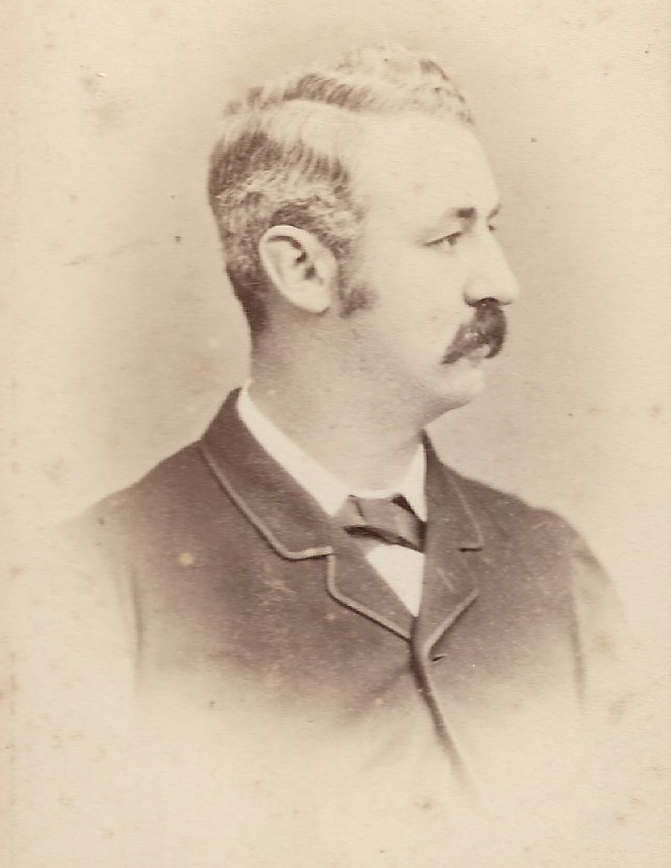 |
|
Samuel Thomson Plumbe
photo from Claire Freestone
|
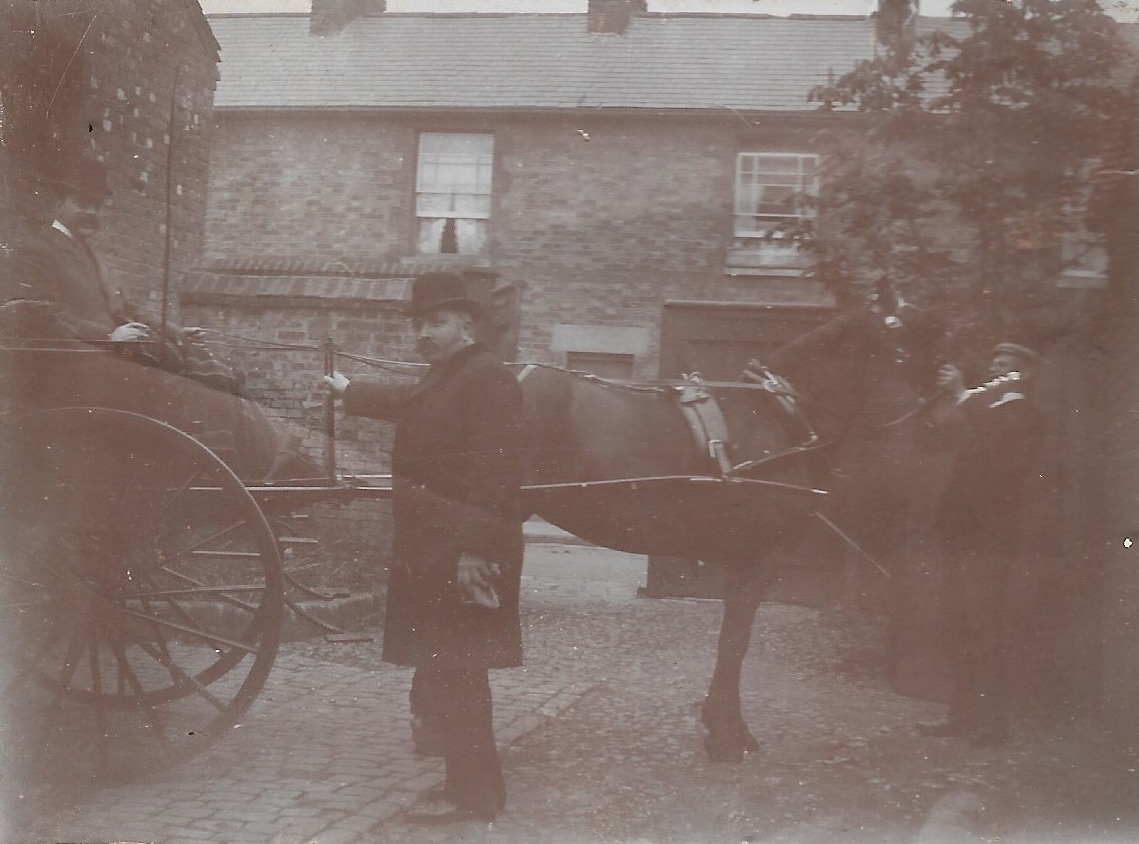 |
|
Samuel Thomson Plumbe
photo from Claire Freestone
|
8 July 1853 in Maidenhead, Berkshire,
England
7 November 1853 in Maidenhead
Chapel, Maidenhead, Berkshire, England
Samuel Alderson
Plumbe
Louisa
Burton (Hulke) Plumbe
General Practitioner.
Samuel began training at St Bartholomews in October 1872 and he was there
for five years. He was appointed House Surgeon at the Kent and Canterbury
Hospital on May 2 1877 as House Surgeon. He was M.D., London, 1882; M.B.,
M.R.C.S., and L.S.A., 1877.
1883 Samuel Thomson Plumbe, MD, Surgeon
Montgomery & Plumbe,
Surgeons, 88 High Street
1903 Montgomery & Plumbe, Surgeons, 88 High Street
Plumbe, Samuel Thomson, MD
London, MRCS England, Physician & Surgeon
Samuel was one the founding members of staff at the Maidenhead Cottage
Hospital in Norfolk Park, Maidenhead, which was opened in 1879, at which
time it could accommodate seventy three patients. The cost of the building
was met largely by public donations. It was enlarged in 1908, 1911 and 1921,
and by the time the final extensions were completed in 1930, it accommodated
over five hundred patients. In 1948 it was absorbed into the National Health
Service as Maidenhead General Hospital. It was closed in 1974 and its
patients moved to St Mark's Hospital, Maidenhead. Samuel worked there until
his death in 1909, and a brass memorial plaque was created in his honour
reading:
"Samuel Thompson Plumbe, MD, member of the staff of the hospital, 1879-1909.
Erected March 1910."
Samuel played football for the Maidenhead
Football Club, scoring the first goal in the club's first match at the
York Road on 16 February 1871. York Road is believed to be the oldest senior
football ground continuously used by the same club in the country
("Country's 'oldest' football ground in Maidenhead gets plaque" BBC
News, 13 October 2012)
BBC
Berkshire, 18 February 2011
Maidenhead Football club celebrates140
years of history
On 16 February, 140 years ago Maidenhead played their first
football match at York Road.
The club began life two months earlier, playing at Bonds Meadow,
but moved to York Road after receiving permission from Maidenhead
Cricket Club.
Today Maidenhead FC claims to hold the record as the oldest
continuously used senior football ground in the world.
... Back in 1871, Maidenhead's first match at York Road was against
Marlow.
At 1530 GMT 15 Maidonians dressed in white with a black and green
Maltese cross, faced up to fifteen Marlovians dressed in blue and white
stripes.
The rugby sized line up reflected the fledgling years of the game
when many of the rules were interchangeable.
Marlow won the toss and opted to kick up the slope. The first
half hour was even with Marlow's brawn being matched by Maidenhead's
speed and creativity. The scene was thus set for the first ever goal at
York Road which was reported as follows:
"Mr Plumbe has seen his chance. He runs with astonishing speed -
gets it - and keeps it - until - gently kicking - he has skilfully,
gradually, obliquely, worked it along to the desired spot, and the first
goal is won by Maidenhead.
"The excitement now becomes great and, amidst the cheers of the
bystanders, Mr Plumbe is carried round the goal on the shoulders of his
exulting confederates."
After half time Maidenhead's Basset hit the post and shortly
before the end the captain, Goulden, sealed the win for the home team
with a neat dribble and shot.
A query on the Plumbe home "Monkendons" was posted on www.curiousfox.com for
Maidenhead:
"Monkendens" was situated at 151 High St
where, I'm told, its roof had a landmark copper dome or cuppola. On the
land now, I am told a mere supermarket stands! Dr SA Plumbe served the
area in a joint practice from about 1863 till his death in 1876, while his
son Dr ST Plumbe took over and must have made his mark till his own early
demise in 1909. About 1910 the house-contents were sold, and we think the
site was cleared at that time.
A Catalogue of Sale for the house-contents dated 1 September 1909 shows that
the house had 5 bedrooms, 2 maid-rooms, Billiard room, Drawing room, Morning
room, Library, Dining room, Entrance Hall, Kitchen, Scullery and Larder.
7 June 1909, at "Monkendens", High
Street, Maidenhead, Berkshire, England, aged 55
Maidenhead Advertiser 9 June 1909
PLUMBE.—On
June 7th, at Monkendons, Maidenhead, suddenly, Samuel Thomson Plumbe,
M.D. London, aged 55. Funeral service on Thursday at 2.15 at St. Luke's
Church, and at the Cemetery.
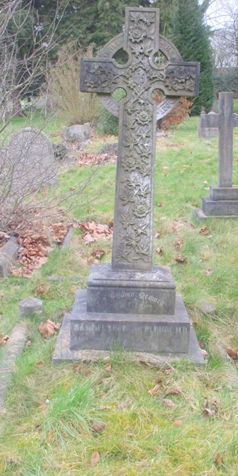 |
|
Gravestone of Samuel Thomson Plumbe in
Maidenhead cemetery, Berkshire
photo from Mark Smith
|
10 June 1909, in Maidenhead
cemetery, Maidenhead, Berkshire, England.
The Slough, Eton and Windsor Observer, 12 June
1909 p8 column 4
SUDDEN DEATH OF DR. PLUMBE.
We deeply regret to have to record the
death, under peculiarly distressing circumstances, of Dr. Samuel Thomson
Plumbe, the sad event occurring with painful suddenness at his
residence, Monkendons, High-street, Maidenhead, on Monday morning last.
The doctor discharged his professional duties on Sunday, and when he
retired to rest at shortly after midnight he appeared in his customary
health and strength and was as cheerful as usual. At between 8 and 9
o'clock on Monday morning one of the domestic servants went to his room
to call him, but obtaining no response she entered the apartment and was
amazed to find her master lying dead on the floor of the room. She
promptly called Miss Plumbe, the doctor's sister, to whom, of course,
the discovery was a great shock. Dr. Cecil Montgomery—Dr. Plumbe's
partner—was telegraphed for, and on arrival found that the worst fears
were justified, and that life was extinct. He was of opinion that death
had taken place about an hour previously. Three years ago Dr. Plumbe had
an attack of syncope, and it was then known that he suffered from heart
disease.
The news of the sudden death of Dr.
Plumbe caused a profound sensation in the town and district, and
confirmation of the sad intelligence on inquiry at the surgery and
residence was received with the utmost regret, no resident being more
widely known or more highly esteemed.
The deceased was a son of Dr. Samuel
Alderson Plumbe, who came to Maidenhead in 1852, and who died suddenly
on December 6th, 1876, at the age of 52. He received his early trining
in medical and surgical skill at St. Bartholomew's Hospital, where he
was for five years. He was then appointed House Surgeon at the Kent and
Canterbury Hospital. After this, and twelve months after the death of
his father, Dr. Plumbe joined Dr. Edwin Cuthbert Montgomery, in 1878,
thus taking the place of his father, who had been in partnership with
Dr. Montgomery for some 14 years. On the retirement of Dr. Montgomery
last year, Dr. Plumbe took Dr. Montgomery's son (Dr. Edwin Cecil
Montgomery) into partnership. The late Dr. Plumbe was M.D., London,
1882; M.B., M.R.C.S., and L.S.A., 1877. He was 54 years of age.
Dr. Plumbe was not only a very skilful
medical practitioner, but he was a true friend of his patients -
attentive, sincere, sympathetic, and kind-hearted. he was ingenuous and
outspoken, but tactful, and always most conscientious in the discharge
of his responsible duties. No call made on his professional skill came
too late or too early an hour, and no summons came from too great a
distance. To all requests for his attendance he responded with alacrity,
and with a cheerfulness that was remarkable. The need, and not the
person, was Dr. Plumbe's first consideration. He was a real friend to
the sick poor who came under his treatment and influence, and his death
is little short of a calamity to the town and district.
He was Medical Officer to the Post
Office, Police, and most of the local friendly Societies and Slate
Clubs, as well as Medical Officer under the Factory Act.
He was unmarried, and resided with his
sister, Miss E. A. Plumbe, for whom, as well as the other members of the
family, the deepest sympathy is felt and expressed in their peculiarly
sad bereavement.
British
Medical Journal, 26 June 1909 p1578
Dr. PLUMBE, who had practised for thirty-one years at
Maidenhead, was found dead in his bedchamber on the morning of June 7th.
He had attended as usual to his professional work the day before, and
seemed to be well and strong when he retired to rest, but he had
suffered from an attack of syncope three years earlier, and it was then
discovered that he was already the subject of heart disease. His father
died suddenly in December, 1876, at the age of 52, and Dr. Samuel Plumbe
himself was only 56 at the date of his decease. He died unmarried. Dr.
Samuel T. Plumbe was the son of Dr. Samuel Alderson Plumbe, who settled
in Maidenhead in 1852. He studied.at St. Bartholomew's Hospital. He
graduated M.B.Lond., and obtained the diploma of M.R.C.S. and L.S.A. in
1877, and took the degree of M.D.Lond. in 1882. He held for a time after
his first qualification the appointment of House-Surgeon to the Kent and
Canterbury Hospital. In 1878 he joined his deceased father's partner,
Dr. Edwin Cuthbert Montgomery, in practice. Dr. Plumbe was widely and
deservedly popular, being skilful, prompt, punctual, and extremely
humane. His funeral, which took place at Maidenhead Cemetery on June
10th, was very largely attended, and the assemblage of persons
representative of all classes was a striking testimony to the affection
and esteem in which he was held throughout the town and district.
granted 3 July 1909 to
Philip Algernon Plumbe and Harriet Charlotte Whitfirld
National
Index of Wills and Administrations 1909 p395
PLUMBE
Samuel Thomson of Monkedons Maidenhead Berkshire died 7 June 1909
Administration London 3 July to
Philip Algernon Plumbe bank clerk and Harriet Charlotte Whitfield (wife
of George Sydney Whitfield). Effects £20921 8s. 5d.
1861: High
Street, Cookham, Maidenhead, Berkshire
1871: Holyport,
Bray, Berkshire
1881: Taplow
Mills, Taplow, Buckinghamshire
1891: 86-90 High Street, Cookham,
Berkshire
1901: High
Street, Maidenhead, Berkshire
Samuel William Plumbe
1866, in Winchcombe, Gloucester,
England
Henry Plumbe
Caroline (Straford) Plumbe
Edith Thompson in 1908 in King's
Norton
district, Worcestershire, England.
Edith was born in 1876/7 and died in Birmingham
district, Warwickshire, in 1938, aged 69.
Census:
1911: King's Norton, Worcestershire: Edith Plumbe is aged 34
7 September 1927, in Birmingham
North
district, Warwickshire, England, aged 60
1871: Terrace, Winchcombe,
Gloucestershire
1881:
9
Johnstone St, Bathwick, Somerset
1911: King's Norton, Worcestershire: Samuel William Plumbe is aged 39, born
in Winchcombe
1927: 68 Lower Essex Street, and 75 Addison Road, King's Heath, both in
Birmingham, Warwickshire (London Gazette 13 January 1928 p335)
- England Birth Index
(4Q1866 Winchcomb vol 6a p359); exact place from 1871 census
- England Marriage Index
(3Q1908 King's N vol 6c p683); Edith birth from 1911 census (age at
death gives birth year of 1868/9); Edith death from England Death Index
(1Q1938 Birmingham vol 6d p558)
- England Death Index
(3Q1927 Birmingham N. vol 6d p378); exact date from estate notice
in London Gazette 13 January 1928 p335
Samuel Henry Plumbe
28 September 1866, in Whitechapel
district, Middlesex, England
Henry Martyn
Plumbe
Louisa (Walker) Plumbe
Christ's Hospital School (London)
Henrietta Maclaren on 11 September
1902 in Atlin,
British Columbia, Canada
Henrietta was born on 17 April 1871 (? - see source notes) in Ontario,
Canada, the daughter of Henry Maclaren and Helen Baird. She died on 2 June
1943, in North Vancouver, British Columbia, aged 70. Probate was granted on
6 August 1943.
Henrietta's sister, Helen Elizabeth, married Richard D. Featherstonhaugh who
became a mine manager in Atlin, B.C. and it was presumably during
Henrietta's visit to her sister recorded in the 1901 census, that she met
Samuel Plumbe, also a mine manager in Atlin.
Census:
1881:
Torbolton,
Carleton, Ontario
1891:
Torbolton,
Ontario
1901:
Bennett
& Atlin sub-district, Burrard, British Columbia
1911:
62 Government Street, Victoria, British Columbia
Accountant, earning $2000 a
year in 1901, and superintendent of mining companies.
Samuel went to Atlin in northern British Columbia as superindendent for the
Birch Creek Mining Company and he later, as representative of the Nimrod
Mining Syndicate of London, managed the McKee Creek Hydraulic Company.
Victoria Daily Colonist 28 September 1906 p5
PROGRESS
AT ATLIN.<
The McKee Hydraulic Company Makes a Good
Clean-up.
Atlin advices of September 15th, say:
S. H. Plumbe, manager for the McKee Amalgamated Hydraulic company,
was in town on Saturday last with a clean-up which his company made the
previous Tuesday. Five hundred and thirty-three ounces of gold, valued at
over $9,000, were obtained as the result of 23 days piping. Although the
water was slowly falling off, the company last week commanded a 6-inch
head and Mr. Plumbe is fairly confident that he will have one, if not two,
good clean-ups before the end of the McKee Creek season.
Samuel was the manager of the Amalgamated McKee Creek Mining Company which
also owned leases on McKee Creek.
Annual report of the Minister of Mines 1905
p69
ATLIN
MINING DIVISION.
REPORT OF J. A. FRASER, GOLD
COMMISSIONER
MCKEE CREEK
Nearly all the ground on this creek is owned by companies and only
from 10 to 15 individual miners operated on it during the summer, but
those were rewarded by good returns.
The scarcity of water and the uncomfortably close quarters into
which Ginaca & Co., and the McKee Consolidated Hydraulic, Limited, had
worked themselves in 1904 induced the latter company to suspend operations
for this season, so as to enable the said Ginaca & Co. to work past
the point of conflict and interference, which they did with satisfactory
results. They operated on the Old
England and Winnemucca
leases, and with five men and the use of the hydraulic plant and water of
the above-mentioned McKee Creek Consolidated Hydraulic, Limited, uncovered
about 5,500 square yards of bed-rock and moved about 27,500 cubic yards of
gravel, with satisfactory results.
The Amalgamated McKee Creek Mining Company, under the management of
Mr. S. H. Plumbe, operated further down stream on the Beta
and Gamma leases, with a force
of from 8 to 12 men and an expenditure of about $15,000, and uncovered
about 4,700 square yards of bed-rock, and as the banks were very high
(about 130 feet), moved a considerable quantity of material, which
averaged about $4.70 per square yard of bed-rock exposed, and gave a
handsome net profit for the season's operations, notwithstanding the
shortage of water, which, unfortunately, permitted of the use of two
monitors for a few weeks only, and towards the end of the season of one
monitor only for a few hours a day.
Annual report of the Minister of Mines 1907
p48
ATLIN
MINING DIVISION.
REPORT OF J. A. FRASER, GOLD
COMMISSIONER
MCKEE CREEK
Only four individual operators were engaged on this creek this last
season, and they for but a comparatively short time. Their ground being
pretty well worked out and water being scarce the results were not as
satisfactory as in former seasons. The whole creek being practically under
one management, although held by two companies, the McKee Consolidated
Hydraulic, Limited, owning the leases on the upper portion of the creek,
was granted exemption from the operating conditions of said leases on
account of the scarcity of water, and so as not to embarrass the
operations of the Amalgamated McKee Creek Mining Company, Limited, on the
lower portion of the creek. This company, under the superintendence of Mr.
S. H. Plumbe, with Mr. Geo. Adams as foreman, and latterly under the
direct supervision of Mr. Fletcher T. Hamshaw, president and general
manager, commenced operations about the middle of May and continued as
water would permit until October 8th. About midsummer the company was
compelled by the scarcity of water to reduce the width of the sluices to
make the available quantity more effective. Notwithstanding these and
other difficulties, this company, according to the president's report,
moved about 500,000 cubic yards of overburden, washed nearly 60,000 cubic
yards of pay gravel, thereby uncovering nearly 7,000 square yards of
bedrock and recovering therefrom nearly $24,000. The last pit worked was
the best, and according to said report averaged $8.45 per square yard of
bedrock. It also removed a great quantity of overburden (nearly 400,000
cubic yards), which leaves a large amount of pay gravel exposed for next
season's operation. About $8,000 was expended on new plant, pipe-lines,
etc., which, with the amount of dead-work already done, leads to the
expectation of a good start and excellent results for next season. A force
of about 20 men was employed during the season.
In 1909 Samuel was superintendent of supplies for J. M. Heney, the
contractor in charge of the construction of the Copper City - Cordova
railway in Alaska.
Samuel went to the United States in
1891, according to a family letter. In the 1901 census, Samuel lists that he
emigrated to Canada in 1894. The 1900 census shows him working in Alaska,
having located there in August 1898, but listing his home as Victoria, B.C.
A legal document lists his home address on 1st February 1899 as being 408
Union St, Seattle, King county, Washington, United States.
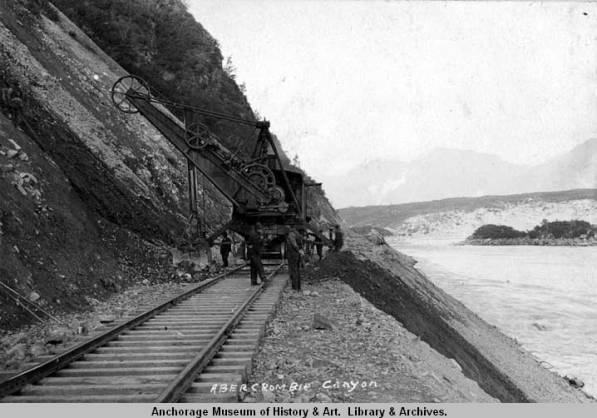 |
|
Construction of the railroad through
Abercrombie canyon. It was during this construction that Samuel
Plumbe was struck by a train and killed.
|
9 May 1909 at Cordova, Alaska, United
States, aged 42. Samuel was struck by a train in Abercrombie canyon, and
died of a punctured lung from broken ribs.
Victoria Daily Colonist 12 May 1909 p6
Victorian
Killed in North
News has been received in the city of the death at Cordova,
Alaska, of S. H. Plumbe, well known amongst mining men of the north and
Atlin, where he spent many years, and also in this city, where up until
a few months ago he has for some time been residing. Mr. Plumbe was
transportation agent for M. J. Heney, the contractor upon the Copper
river railway, and on Saturday last was struck by a train while passing
through Abercrombie canyon. He died the following day. Word was received
by Hon. Dr. Young, who was an intimate friend of the deceased, asking
him to break the news to the bereaved family. The body has been shipped
south to this city for interment by the steamer Northwestern.
A letter from Archie W. Shield in Cordova to Hon. Dr. Young gives more
detail on Samuel's death:
Copy of a letter from A Shield to Hon. Dr.
Young.
M. J. Heney
Railway Contractor
Cordova, Alaska
Cordova,
Alaska May 10th 1909
My Dear Young:
It is with the deepest feelings of sorrow that I have to
confirm to you my telegram telling you of the death of our poor friend
Plumbe. Until two oclock on the afternoon of his death he was considered
by us all to be out of danger and his sudden taking away has been a great
shock to us all. I hope poor Mrs. Plumbe is bearing up well under her
great bereavement and that you & Jack will be able to be some comfort
to her.
We are sending his remains down on the Northwestern leaving this
morning and I am wiring you that this has been done & asking you to
confer with our Seattle office in regard to the transfer from that city to
Victoria. Dr Whitting is writing you on this steamer also.
The accident that caused his death was one of those things that no
one can explain. he walked down the track towards a train that was slowly
coming towards him with the intention of jumping on board & taking a
ride. the train was not going in excess of a mile an hour, as she was just
pulling out after taking water. he caught ahold of the hand bar an got his
foot onto the step; but in some way either slipped or in climbing up got a
cramp and let go. he was not struck by the wheels, but by the boxing of
the trucks which knocked him clear of the wheels and under the Car. the
train was of course immediately stopped and the poor old chap taken out
and over to the hospital where everything was done for him that could be.
he was conscious when we got him out from under the car, and rested very
easy Friday night. Saturday and Saturday night he was feeling very well
although not hungry. in fact he did not seem to want anything to eat but
fruit, on Sunday morning he was more cheerful still, and the Doctors gave
it as this opinion that he was out of danger, and we were discussing if it
would not be a wise thing to send him down home to build up his strength,
on the steamer leaving here on the 20th. at two oclock on Sunday afternoon
he seemed suddenly to collapse and from that on till the end came at seven
thirty he sank very rapidly. the end was very peaceful he appeared to be
free from all pain although must have been badly crushed internally. to
all outward appearances his injuries consisted of a broken collar bone and
three fractured ribs. I will write you on the next boat, old man and
arrange to send down the poor boys effects at that time. I am enclosing
you a short note to Mrs Plumbe which I hope you will please hand to her.
will you please also keep me posted as to how she bears up under her great
sorrow, and if there is anything in the world we can do for her please do
not hesitate to advise me
very sincerely yours
Archie W. Shield
17 May 1909, in Ross Bay cemetery,
Victoria, British Columbia. His grave is in Block T, plot 88 W 44.
Victoria Daily Colonist 18 May 1909 p7
ACCIDENT'S VICTIM LAID TO REST
Late S. H. Plumbe Recently Killed at
Cordova Buried Here Yesterday
The
funeral of the late S. H. Plumbe, who recently was accidentally killed
at Cordova, Alaska, where he was acting as superintendent of supplies
for J. M. Heney, the contractor in charge of the construction of the
Copper City-Cordova railway, took place yesterday afternoon from the B.
C. Funeral Furnishing parlors. His Lordship, Bishop Perrin, assisted by
the Rev. Baugh Allen officiated, and the attendance was large. Interment
took place at Ross Bay cemetery.
The late Mr. Plumbe was one of the best
known residents of the north, and had a host of friends throughout
British Columbia, Alaska and the Yukon. Liked by everyone who knew him,
he was extremely popular. His tragic death at the early age of 42 came
as a real shock to everyone.
Mr. Plumbe had been at Cordova but a
few months when the accident occurred. For the past year he has made
Victoria his home, and his family, a wife and four children, reside here
on Government street, near the Dallas road.
Of the 20 years which he had spent in
B.C. the last 12 years were passed in Atlin. Going there originally as
superindendent for the Birch Creek Mining Company, he later as
representative of the Nimrod Mining Syndicate of London, managed the
McKee Creek Hydraulic Company. Some six years ago he married Miss
McLaren, of the well-known family of Ottawa, Ont., and Buckingham, Que.
His father lives in Croydon, Eng., and one brother, A. G. Plumbe, is a
resident of Seattle. He with W. C. McLaren, a brother-in-law, of
Calgary, were present here for the funeral.
The regard in which the late Mr. Plumbe
was held by his large circle of friends was manifested by the beautiful
floral tokens which were recelved. Countless telegrams and letters of
condolence have been received by the bereaved family.
The pallbearers yesterday were E.
Roselli, Hon. Dr. Young, J. Byrom, C. Bourne, J. Canavan and J. H.
Brownlee, all old friends of the deceased.
Samuel Henry Plumbe's will was probated in the British
Columbia Supreme Court in 1909.
1881:
Christ's
Hospital School, Newgate Street, City of London
1900:
Broadway,
Skagway, Alaska Territory
1901:
Bennett
& Atlin sub-district, Burrard, British Columbia
1909: 62 Government Street, Victoria, British Columbia (Directory of Vancouver Island 1909 p284)
Sarah (Plumbe) Dunn
25 September 1795
21 October 1795, in St. Mary,
Henley on Thames, Oxfordshire, England
John Plumbe
Sarah
(Simmons) Plumbe
Thomas
Henry
Dunn on 11 July 1821, in St. Mary, Henley on Thames, Oxfordshire,
England. Marriage witnessed by John Simmons Plumbe (bride's brother),
Charlotte Plumbe (wife of John Simmons Plumbe) and Mary Plumbe (presumably
the younger sister of the bride)
17 August 1886
Claire Freestone's data has the
marriage of Sarah to Thomas Highgate, but I can find no corroboration of
this and I believe it to be a transcription error of Thomas Dunn of
Highgate.
- David Morris at
www.steelbreeze.net
- Parish registers
researched by Keith Hazell
- Henley parish
registers researched by Mike Strange; parish registers researched by
Keith Hazell
- Keith Hazell
Thomas Plumbe
14 July 1806, in Wantage, Berkshire,
England
8 August 1806, in SS Peter &
Paul, Wantage, Berkshire, England
Samuel Plumbe
Molly
(Aldworth) Plumbe
Ellen Moss on 1 June 1841, in
Trinity Church, Marylebone, Middlesex, England
The Asiatic Journal, June 1841 p166
June 1. At Trinity
Church, Marylebone, Capt. T. Plumbe,
27th Bengal Infantry, to Ellen, youngest daughter of D. Moss, Esq., of
Portland-street, Portland-place.
Ellen was born in 1816/17, in Kensington, London, the daughter of D. Moss.
Her father was a successful businessman in Lima, Peru. Ellen was converted
from the Jewish faith by a prominent American evangelist whilst sailing to
England from Peru. She died in 1906, in Wellington
district, Shropshire, aged 89.
Census:
1871: Lyncombe
& Widcombe, Somerset
1881: Abbey Villa,
Lyncombe & Widcome, Somerset
1891: Great
Yarmouth, Norfolk
1901: Willesden, Middlesex: Ellen Plumbe, mother-in-law, is aged 84, born in
Kensington, London.
Army Officer. Thomas served in
the 27th Native Infantry in the East India Company's service. He was
commissioned as a cadet in 1824 and sailed from England on the Boyne
on 5 January 1825, arriving in Madras on 6 May 1825. In 1839, he was a
lieutenant interpreter and quarter master of the 27th regiment of native
infantry, and appointed to act as station staff at the Ferozepore station on
27 April 1839 (Calcutta Monthly Journal and General Register
1839 p103). Thomas was made captain on 8 October 1839 (East India Register and Army List 1845 p118).
His unit was stationed to Moradabad in June 1843 (East India Register and Army List 1845 p118).
Thomas was promoted to Brevet Lieutenant-Colonel on 28 November 1854 (Allen's Indian Mail 31 October 1856 p642)
and a full Lieutenant-Colonel on 28 November 1856 (India Office and Burma Office List 1857 p73).
During the Indian Rebellion of 1857 the loyalty of the sepoys, or
native enlisted men, of the 27th Native Infantry was questioned as other
regiments in the region had started to mutiny. Thomas argued strenuously in
favour of the loyalty of his sepoys, but was overruled and the regiment was
disarmed and disbanded.
Memorials
of the Life and Letters of Major-General Sir Herbert B. Edwardes
p130-1 (Sir Herbert Benjamin Edwardes, 1886)
Hitherto a large garrison of Hindostanee
troops had been deemed necessary to occupy this Afghan valley. It was now
proposed to reverse matters, to disarm the majority of the Troops and call
in the people and mountaineers instead; this, too, when our prestige was
gone. But it was the least of evils. And the General choose it with
characteristic promptitude.
All the Commanding-officers of corps were summoned. Day dawned
before they were collected at the Residency, and for two hours the
Commandants of the condemned regiments protested against the measure. It
was impossible not to sympathize in the soldierly feelings of Colonel
Harrington and Major Shakespear; but when Colonel Plumbe declared his
'implicit confidence' in the 27th Native Infantry to be unshaken by the
events in Hindostan, and had nothing to recommend but 'conciliation,'
while the Colonel of the 51st Native Infantry, on the other hand,
predicted that 'his men would attack the guns if called on to give up
their muskets,' hesitation was at an end.
General Cotton announced his determination to to disarm the four
most doubtful regiments, and ordered them to parade, each on its own
ground, at seven a.m. for that purpose (already it was past six).
The events of the next hour were to decide the fate of Peshâwur
during this war, and those who best knew the disaffection of the Sepoys,
and had been most convinced of the necessity of disarming them, felt most
anxiously as to the issue.
The corps to be disarmed were the 5th Light Cavalry, 24th, 27th,
and 51st Regiment Native Infantry.
Whether Thomas's faith in the loyalty of his men was justified or misplaced
will never really be known - the regiment was disarmed without incident. His
loyalty during the Rebellion was not appreciated by more militant officers -
Edwardes later writes:
Memorials
of the Life and Letters of Major-General Sir Herbert B. Edwardes
p132
... the 7th, which was the most doubtful, was
commanded by a firm and vigilant officer (Colonel Mulcaster) who was not
infected with the disease of 'implicit confidence;'
Thomas retired on 23 July 1858 and was given a step promotion to the
honorary rank of Colonel (London Gazette 23 July 1858 p3413).
10 January 1894, at 15 Cambridge
Gardens, Kilburn, Middlesex, England, of chronic brochitis and old age, aged
87.
1871: Lyncombe
& Widcombe, Somerset
1873: Bath (mentioned as a trustee of annuities established by his brother,
Robert)
1881: Abbey Villa,
Lyncombe & Widcombe, Somerset
1891: Great
Yarmouth, Norfolk
Thomas Plumbe
26 January 1828, in Wantage,
Berkshire (now Oxfordshire), England
19 March 1828, in SS. Peter &
Paul, Wantage, Berkshire, England
John Plumbe
Elizabeth
(Neate) Plumbe
9 November 1844, aged 16
in Wantage, Berkshire (now
Oxfordshire), England
- Parish registers
researched by Keith Hazell
- Parish registers
researched by Keith Hazell
- from tombstone researched
by Claire Freestone
- from tombstone
researched by Claire Freestone
Thomas David Plumbe
1842/3
Thomas Plumbe
Ellen (Moss) Plumbe
7 February 1843, near Allahabad,
North-Western Provinces, India, an infant
Bombay Times and Journal of Commerce 15 March
1843
On the 7th Feb near Allahabad Thomas David the infant son of Capt T Plumbe
27th Regt NI
Thomas Plumbe
1857, in Ashton Keynes, Wiltshire,
England
John Plumbe
Elizabeth
Jane (Richards) Plumbe
Susan
Argent in 1882, in Hackney
district, Middlesex, England
Warehouseman (Silk trade) 1936
1901: Leyton, Essex; Age: 43; Occupation: Warehouseman Silk Trade; Place of
Birth: Ashton Keynes, Wiltshire
- 1901 census; Claire
Freestone
- England Marriage Index
(3Q1882 vol 1b p892)
- 1901 census
- Claire Freestone
Thomas Strange Plumbe
17 September 1865, in Henley on
Thames, Oxfordshire, England
William Plumbe
Ann
Richardby (Strange) Plumbe
20 November 1865, in Henley on
Thames, Oxfordshire, England
- England Birth Index
4Q1865 vol 3a p517; exact date from David Morris at www.steelbreeze.net
- England Death Index
4Q1865 vol 3a p355 (listed as Plumb); exact date from Keith Hazell
Thomas Argent Plumbe
1884, in West Green, Edmonton
district, Middlesex, England
Thomas Plumbe
Susan
(Argent) Plumbe
Violet Danford
Drapers Warehouseman
1967
1901: Leyton, Essex; Age: 17; Occupation: Drapers Warehouseman; Place of
Birth: West Green, Middlesex
- 1901 census; Claire
Freestone
- Claire Freestone
- 1901 census
- Claire Freestone
Velebeth Plumbe
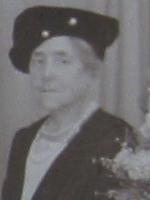 |
|
Velebeth Plumbe
photo from David Morris
|
27 July 1870, in Islington,
Middlesex, England
James Plumbe
Velebeth
(Chibnall) Plumbe
Charles Strange
Plumbe on 11 August 1910, Aylesbury, Buckinghamshire, England
1947, in Henley
district, Oxfordshire, England
Velebeth was known as "Vi". She
married her second cousin. The common ancestors were her great-grandparents,
John Plumbe and Sarah Simmons.
1881:
Box
End, Kempston, Bedfordshire
1891: 18 Gery Street, Bedford St.
Cuthbert, Bedfordshire
- England Birth Index
(3Q1870 Islington vol 1b p242); exact date from David Morris at
www.steelbreeze.net
- England Marriage
Index (3Q1910 Aylesbury vol 3a p2017); exact date and place from David
Morris at www.steelbreeze.net citing the marriage certificate
- England Death Index
(4Q1947 Henley vol 6b p787)
William Plumbe
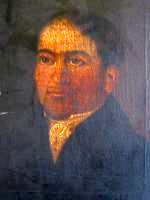 |
|
William Plumbe
portrait from David Morris
|
14 April 1798, in Henley on Thames,
Oxfordshire, England
16 May 1798, in St. Mary's, Henley
on Thames, Oxfordshire, England
John Plumbe
Sarah
(Simmons) Plumbe
Anne
Outhwaite on 7 January 1823, in St. Mary's, Henley on Thames,
Oxfordshire, England. The marriage was witnessed by John and Mary Plumbe,
and James and Robert Outhwaite.
Ironmonger in Henley upon
Thames, Oxfordshire
6 June 1845, in Henley on Thames,
Oxfordshire, England. William died at the Henley regatta.
13 June 1845, in St. Mary's, Henley
on Thames, Oxfordshire, England
- Parish registers
researched by Keith Hazell; also recorded as aged 47 at burial
- Parish registers
researched by Keith Hazell
- Parish registers
researched by Keith Hazell; Henley marriage registers researched by Mike
Strange has 7 June 1823 - one or the other is a typo.
- David Morris at
www.steelbreeze.net
- England Death Index
2Q1845 v16 p59; exact date from David Morris at www.steelbreeze.net.
Regatta info from David Morris.
- Henley parish
registers researched by Mike Strange
William Plumbe
15 February 1802, in Wantage,
Berkshire, England
30 March 1802, in SS Peter &
Paul, Wantage, Berkshire, England. The IGI has the baptism date as 19 March
1802; I note that there is a discrepancy of exactly 11 days, and that this
is the same as the discrepancy for William's younger brother Robert. It
seems quite a coincidence that the Old Style / New Style date discrepancy is
11 days even though this should only ever be a factor for dates before 1752.
Keith's data is taken from transcripts prepared by the Oxfordshire Family
History Society.
Samuel Plumbe
Molly
(Aldworth) Plumbe
Died abroad
- IGI Batch C021982;
Oxfordshire parish registers researched by Keith Hazell
- Oxfordshire
parish registers researched by Keith Hazell; IGI Batch C021982
- Claire Freestone
William Plumbe
21 February 1821, in Henley on
Thames, Oxfordshire, England
2 May 1821, in St. Mary's, Henley
on Thames, Oxfordshire, England
John Simmons
Plumbe
Charlotte
(Aldworth) Plumbe
Ann
Richardby Strange
Magistrate Alderman Draper.
William was the Mayor of Henley in 1858, 1874 and 1882.
14 March 1890, aged 69
20 March 1890, in St. Mary's, Henley
on Thames, Oxfordshire, England
1881: Market Place, Henley on
Thames, Oxfordshire
William is named as an executor in the will of Thomas Strange (his
father-in-law):
Thomas Strange. Personal Estate
£2.916.6s.8d. 1 January. The will with a codicil of Thomas Strange late of
Swindon in the County of Wilts Gentleman who died 29 August 1883 at
Swindon was proved at the Principal Registry by William Strange of
Bilbrooke in the County of Somerset Paper Manufacturer the son and William
Plumbe of Henley-on-Thames in the County of Oxford and James Lang of
Ludlow in the County of Salop drapers and Thomas Coll of Stroud in the
County of Glouucester Banker the Executors.
- Date from David Morris
at www.steelbreeze.net; place from 1881 census
- Oxfordshire parish
registers researched by Keith Hazell
- Henley baptism
registers researched by Mike Strange
- 1881 census; Mayor
dates from David Morris at www.steelbreeze.net
- England Death Index
1Q1890 vol 3a p535; exact date from David Morris at www.steelbreeze.net
- Oxfordshire parish
registers researched by Keith Hazell
- Strange
website
William Henry Plumbe
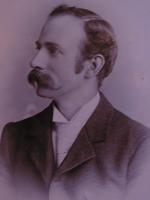 |
|
William Henry Plumbe
photo from David Morris
|
31 December 1860, in Henley on
Thames, Oxfordshire, England
10 January 1861, in St. Mary's,
Henley on Thames, Oxfordshire, England
William Plumbe
Ann
Richardby (Strange) Plumbe
Draper
4 April 1894, in Henley, Oxfordshire,
England
7 April 1894, in St. Mary's, Henley
on Thames, Oxfordshire, England
1881: Market Place, Henley on
Thames, Oxfordshire
- England Birth Index
1Q1861 vol 3a p483 (listed as William Henry Plumb); exact date from
David Morris at www.steelbreeze.net; place from 1881 census
- Henley baptism
registers researched by Mike Strange; listed as Henry Plumbe
- 1881 census
- England Death Index
2Q1894 Vol 3a page 395; exact date from David Morris at
www.steelbreeze.net
- Keith Hazell
William Plumbe
about 1859, in Islington, Middlesex,
England
James Plumbe
Velebeth
(Chibnall) Plumbe
Photographer of 76a High Street,
Maidenhead. Some of William's work can be found in the National
Portrait
Gallery
1915, in Henley on Thames,
Oxfordshire, England
- Keith Hazell
- David Morris at
www.steelbreeze.net
- David Morris at
www.steelbreeze.net
Return to Chris Gosnell's Home Page
If you have any comments, additions or modifications to the information on this page, please feel free to email me.
Created and maintained by: chris@ocotilloroad.com










































